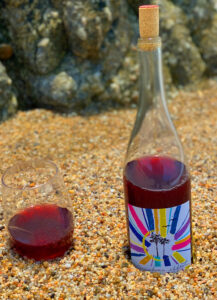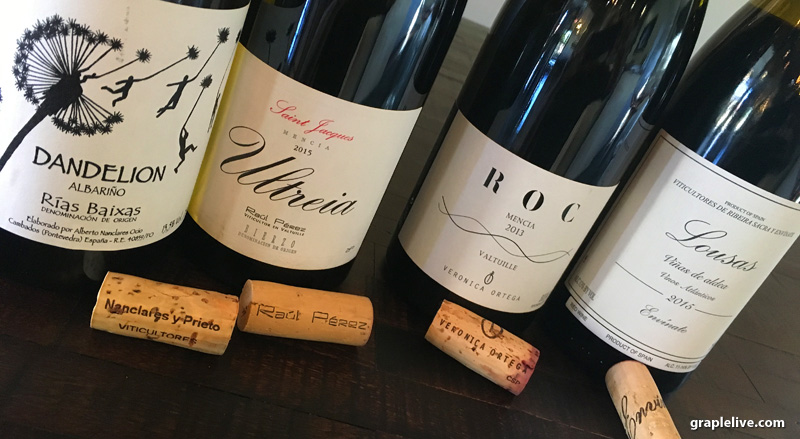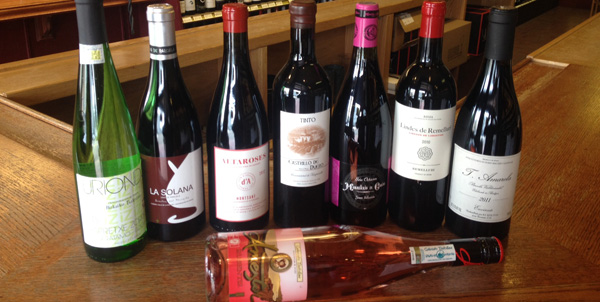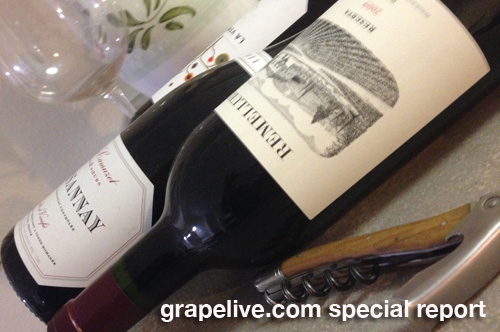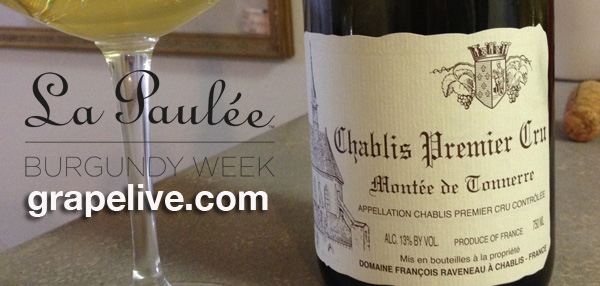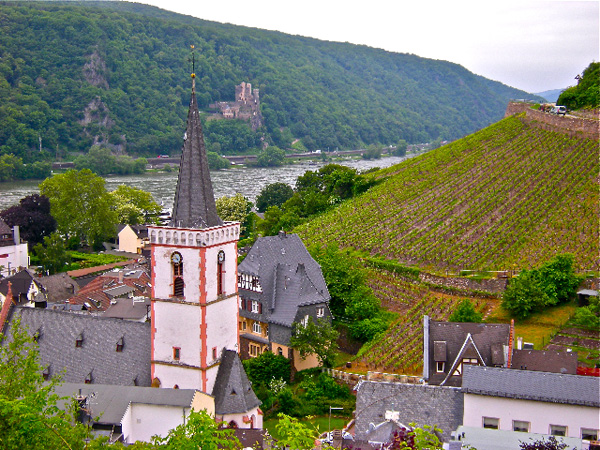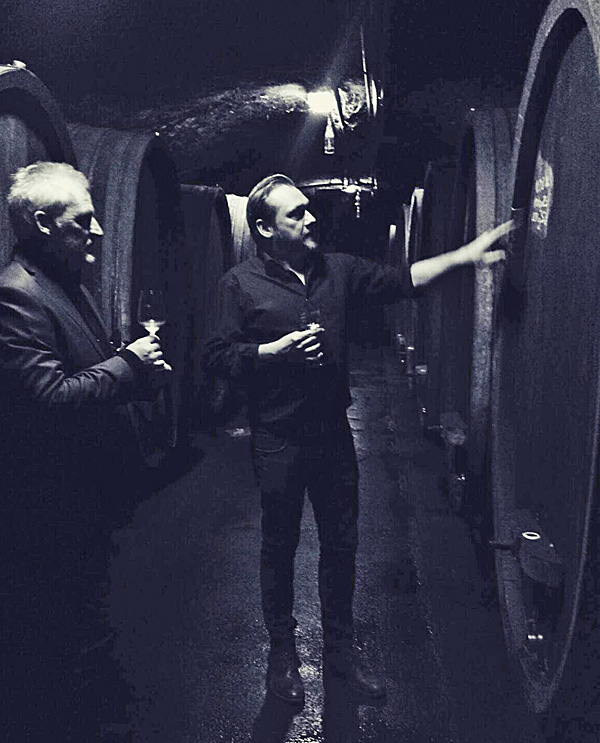
Latest Article

Traditional Cassoulet
In Search of the Languedoc Holy Grail
By Bradley Gray, Special Contributor to Grapelive.com
Cassoulet is undeniably the most delicious comfort food on the planet. This is a centuries-old peasant dish that I’ve been attempting for a mere decade, and with each uniquely different try – most were tasty – it was clear that I wasn’t getting it right. I travelled to the home of Cassoulet: the Languedoc region of Southern France. I met chefs, ate Cassoulets, and now I have a newly defined picture of what “traditional” Cassoulet is. I wanted to understand what Cassoulet is meant to be, directly from the source.
Cassoulet is a dish of legend which begins during the 100 Years War circa 1375. The British had surrounded the small village of Castelnaudary and were basically trying to starve the residents into surrender. Villagers gathered what food they had, cooked it in a cauldron, and fed it to the local forces. Folklore says it provided the soldiers with ample energy to drive the enemy away. It has always been a peasant dish: a stew of beans, sausage and local meats. The word “Cassoulet” comes from the terra cotta vessel it’s served in, the “cassolle” made by local potters. My goal was to learn how to re-create what I enjoyed where Cassoulet was born.
This dish is revered with great passion in Toulouse, Castelnaudary and Carcassonne, the three neighboring villages that hold claim to Cassoulet. Today, there is an honor bestowed on the finest Cassoulet restaurants: Grande Confrérie du Cassoulet de Castelnaudary (the Grand Brotherhood of Cassoulet of Castelnaudary). This alliance, formed in 1970, focuses on protecting the integrity of the dish. Although regional cassoulets can vary (in Toulouse, you may find lamb or mutton, while in Carcassonne, goose or partridge may be ingredients), I’m sticking with Castelnaudary style, with duck confit and Toulouse style sausage (all of the restaurants I visited in Toulouse, Castelnaudary and Carcassonne served this style).
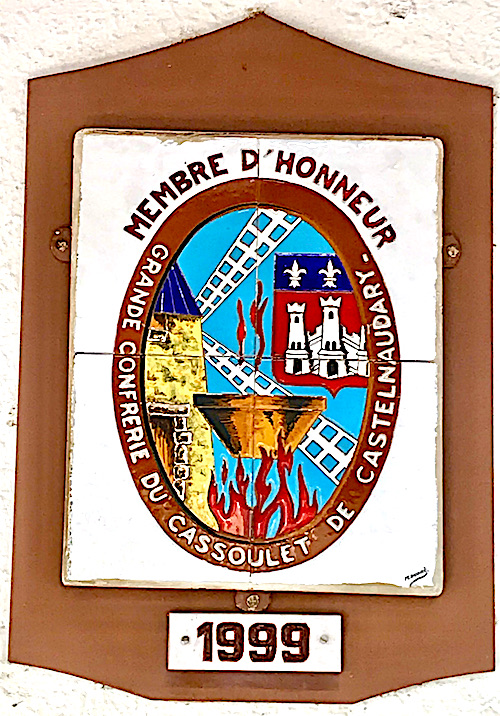
I began in Toulouse which is the cultural center of the Languedoc. I dined at Maison Du Cassoulet, which is a local favorite founded in 1956. I was immediately struck at how different Cassoulet was here compared to the recipes I had followed previously. There were no signs of any tomatoes or bread crumb toppings, the pork sausage was in one piece (rather bite size pieces) and quite mild, and the broth surrounding the beans was very rich and almost clear. In fact, this was the case with every cassoulet I ate, and I tried a bunch! Maison Du Cassoulet also has locations in Castelnaudary and Carcassonne. Delicious isn’t even a good enough word. They gave me a really cool hat.
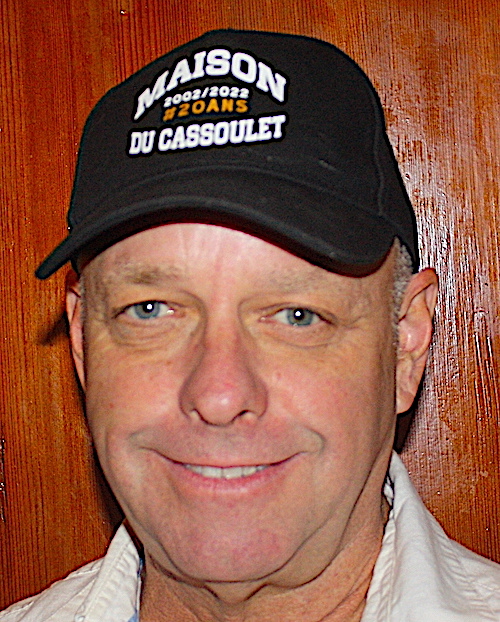
The next day, it was a quickie train ride to Castelnaudary – the birthplace of Cassoulet! After a hike from the train station, I had a wonderful Cassoulet at Le Centre Restaurant, in the heart of the small historic village. This establishment was more elegant than Maison Du Cassoulet, and their offering was excellent. It was rich and hearty, and the “crust” on top of their Cassoulet was magnificent.
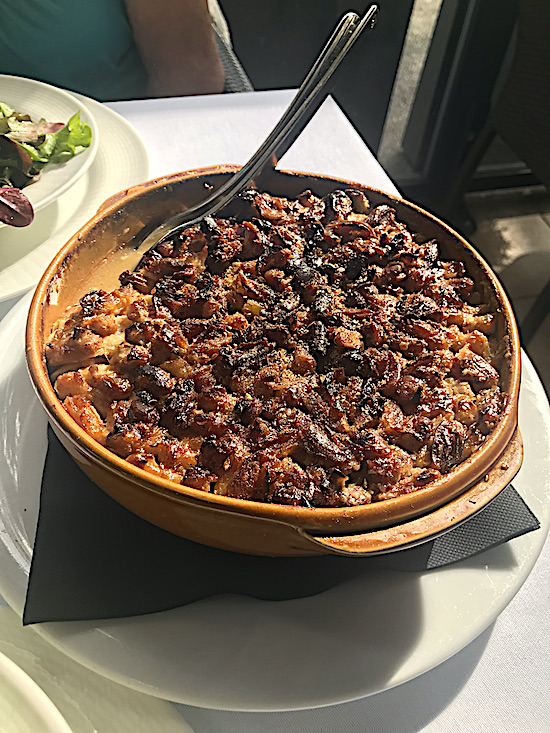
Carcassonne is a simply amazing city, just a stone’s throw down the tracks from Castelnaudary. It’s a community within the walls of a huge medieval fortress and castle on a hilltop. On this evening, it was Adelaide, a famous Cassoulet restaurant I’d sought out before my trip. It was inside the walls of the fortress, and words can’t describe Carcassonne or it’s charm. Their Cassoulet was presented a little differently than the previous ones, with the duck confit and sausage floated on top of the casserole. It was spectacular. And delicious.
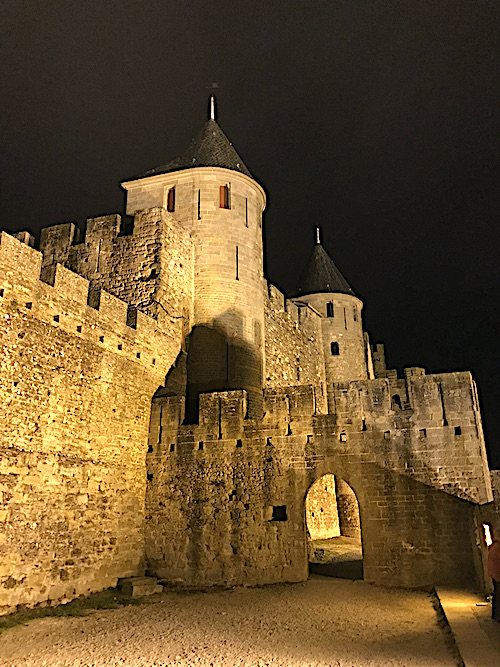
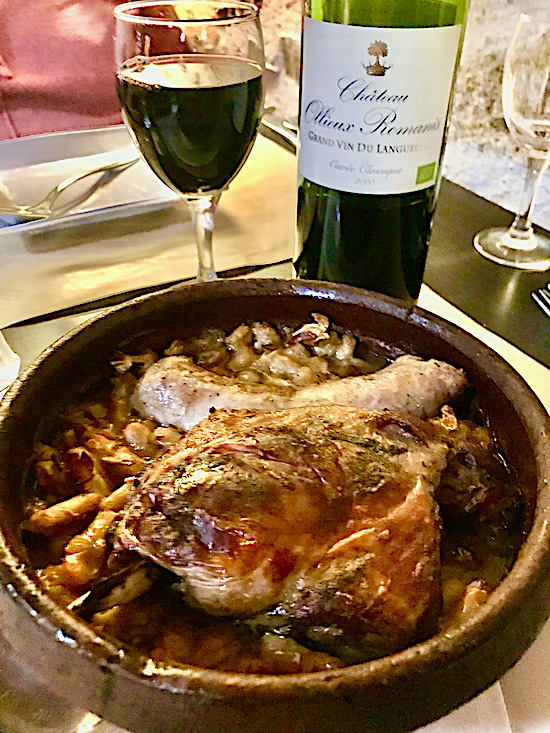
Then there was the Cassoulet at La Trivalou, a tiny cafe in Carcassonne. Before my trip, I researched the best restaurants for Cassoulet, and this was touted to be the best in the Languedoc by multiple websites. And it was! Just under the drawbridge of the majestic castle, this little restaurant was all about the chef, and nothing else. The ambience was so-so, it was a small cafe where the food did all of the talking!
The starter was delicious yet untraditional escargot in cauliflower, and the Cassoulet was not only visually stunning, it was the tastiest by far. Chef Cyril Requi spent time talking to me,
and although there were language challenges (I don’t speak French), I did understand what he was saying. I have read recipes that say you need to cook Cassoulet for 3 days, breaking the “crust” a minimum of seven times. The last time I tried that, it tasted burnt, but I wasn’t using duck fat or duck stock, and my oven was too hot. Honestly, I really didn’t know what I was trying to create. Requi says that after the Cassoulet is assembled, cook it at two hours at a simmer max. He also said something about adding foie gras, but I didn’t completely understand. The thing about the La Trivalou Cassoulet that set it apart from the others is that it’s flavors were focused, clean, super pronounced and it was so creamy.
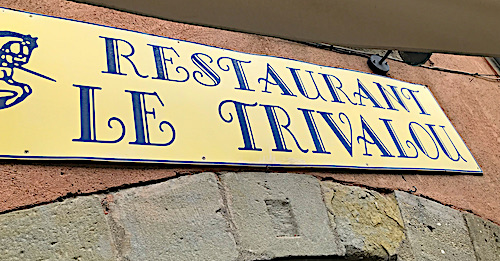
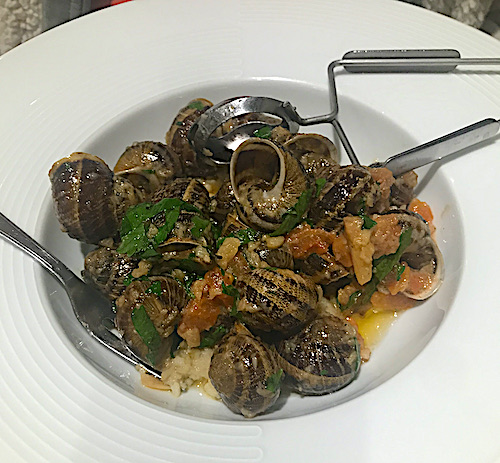
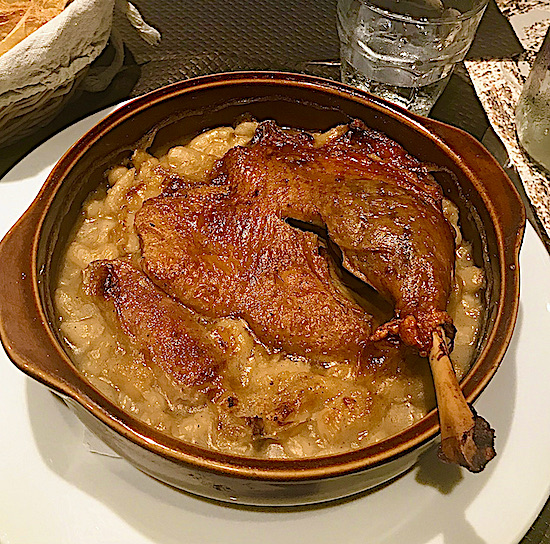
Online domestic websites and recipes (including the Julia Child’s version of Cassoulet) call for ingredients I didn’t see in Languedoc Cassoulets: tomatoes, bread crumbs (to create a fake crust), spicy sausage, chicken, salami (?), beef and beef sausage. I’ve seen recipes that call for chorizo, bacon, etc. No wonder my previous attempts didn’t quite have it!
Cassoulet might be made with goose, pork shoulder or partridge, but all of the Cassoulets I had in “the home of Cassoulet” included the same main ingredients: very mild Toulouse style sausage served in one piece, duck confit, duck stock, rendered duck fat, salt pork lardons (not bacon), Tarbais beans, carrot, onion, celery, etc.
All of that said, I am not a soup Nazi. If you are thinking about making Cassoulet, it is a peasant dish, and wide open to improvisation. Here, I am only trying to understand the dish in its purity, and share my experience. I mentioned above I’ve been attempting to make cassoulet for years before this trip, and they were mostly all wrong but each uniquely delicious.
Recipes I have followed in the past called for the wrong sausage. Julia Child’s cassoulet calls for Kielbasa or Chorizo, and both are too spicy for “traditional” cassoulet. Toulouse style sausage is not available locally in Sonoma or online. In the past, I’ve used mild Italian sausage, but the fennel, basil, paprika and other spices have clashed with the Cassoulet. The only ingredients in Toulouse sausage are ground pork, pork belly, garlic, pepper and a small pinch of nutmeg. With Toulouse sausage, the meat flavors shine, rather than the heavy dose of seasonings found in other sausages. I asked Jeremy, the butcher at Sonoma Market what he recommended, and I sure didn’t expect the answer he gave me: “Make it yourself!” So, with a few tips from him, I did exactly that with a $10 sausage stuffer from Amazon and a couple Youtube tutorials. There’s a first time for everything!
If you are up to making your own Toulouse sausage (it’s not very hard or expensive), there is a good recipe here. I found that this recipe made way more sausage than I needed, so I suggest cutting it in half. Ask your local butcher to grind the pork and pork belly coarsely: https:www//honest-food.net/toulouse-sausage-recipe/
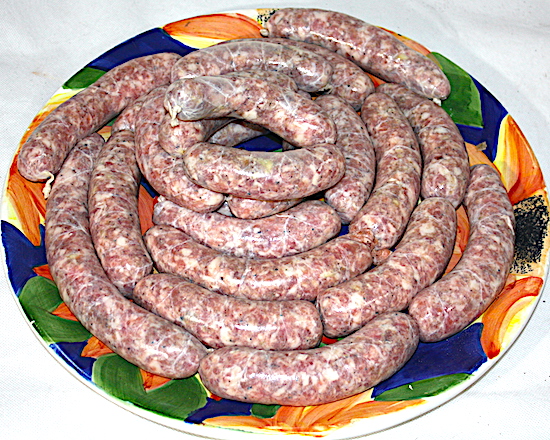
Presentation is important, and finding the correct dish for Cassoulet isn’t easy. The “cassolle” terra cotta dish is the right one. They don’t exist in the US for under $50, mostly from artisan potters. Le Creuset and others make Cassoulet bowls. They aren’t traditional, but pretty. Chef Cyril Requi (Le Trivalou) sent me home with two authentic bowls from his restaurant. In Languedoc, brown earthenware oven-safe bowls are used, but go with what you have!
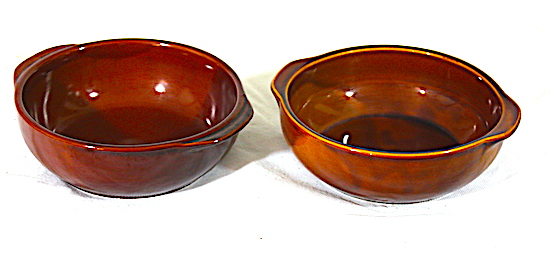
After this enjoyable and eye opening visit to the Languedoc, I once again attempted to create Cassoulet, but this time, I had a focussed understanding of what I was aiming for, both flavor-wise and visually. I did face some ingredient problems: Toulouse style sausage I discussed above. Traditional Tarbais beans are available online here for $20 per pound. I used great northern beans and saved $19. Duck stock is not available here. I purchased a duck carcass from a local duck company and made my own. If not for the duck company, I would have used chicken stock, which is do-able. Duck confit is available at upscale grocers, along with duck legs. Prepared confit is expensive, so I bought the duck legs and did the confit myself. Instructions are online.
The “crust” on the top of Cassoulet is part of its magic, and no, contrary to American urban myth, it’s not done with bread crumbs. The crust is the gelatinous part of the stock, which rises to the top when cooked. It’s easy to achieve this crust, even if you are using store-bought chicken stock. The crust comes from slow cooking. Part of the Cassoulet tradition is cooking, then refrigerating overnight, and cooking again. This allows the crust and melded flavors to develop.
This time, I tried to do it right. The results were spectacular, and the flavor was exactly what I reminisce from France! You’ll never catch me preparing a Cassoulet with tomatoes, spicy sausage or beef, and I’ll NEVER add bread crumbs to the top, ever (again). Promise!
Enjoy Cassoulet on a blustery or cold evening with a green salad, a baguette and a Languedoc wine. See Kerry’s Grapelive.com wine suggestions below.
Cassoulet does take time and patience to make. Plan on a couple days, though for most of this, you won’t have to babysit it. As with most French recipes, cutting corners only diminishes the shine. If you do make it, don’t rush it!
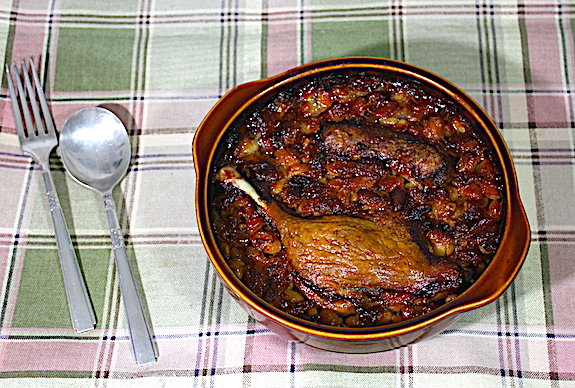
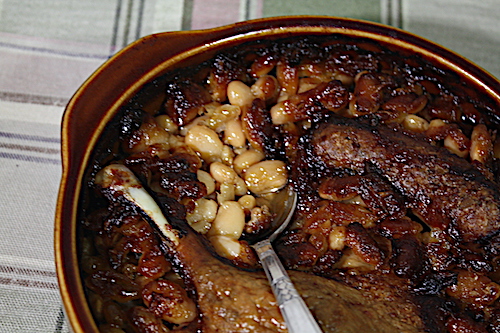
Grapelive Cassoulet Wine Suggestions
There are many fantastic Languedoc wines from which to chose and here are some of my favorite reds to enjoy with these hearty and rustic traditional Cassoulet dishes. -Kerry Winslow, grapelive.com
Wines
Chateau La Roque, Pic St Loup “Cuvee les Vieilles Vignes de Mourvedre” Languedoc, France.
Chateau La Roque is one of my favorite producers and I have long admired the quality and soul found in their wines, especially this 100% Mourvedre red from Pic Saint Loup. This richly textured and deeply colored wine is super lavish and ripely flavored with an explosion of black and red fruits on the palate along with chewy tannins, mineral and wild herbs. The extroverted special Mourvedre cuvee from Chateau La Roque is mouth filling and hedonistic from start to finish and has a real Bandol like feel and even hints at Chateauneuf-du-Pape, making for a most pleasing red that way over delivers for the price. The palate flowers deep with blackberry, cherry liqueur, blueberry and plum fruit, touches of pepper, cassis and a sweet and savory meaty element. The finish is amazingly long and fruit driven to the end, while touches of burnt earth, garrigue and dried flowers add complexity. -Kermit Lynch ($26)
Clos Marie, Metairies du Clos, Pic Saint Loup, Vieilles Vignes, Languedoc, France.
This rare and deeply flavored Grenache and Syrah blend from Clos Marie is a rival for many a Chateauneuf and or Gigondas with wonderful pure fruit, spice and mineral essences to put a smile on any Rhone lovers face. The Metairies comes from very old vines, all biodynamic, on clay and limestone soils that maximize that impact of the fruit, handcrafted and artisan made this is a spectacular wine of quality and style. The nose has earth, flowers and sweet herbs to start with fresh berries and exotic liqueur notes leading to a dense and dramatic palate of dark fruits, cracked pepper, violets and chalky stones with boysenberry, plum, fig and plum along with hints of cassis, saline, peppercorns, truffle and black licorice. While rich and intense this red has plenty of juicy acidity to keep things fresh and vivid, this is beautiful stuff, especially with classic Cassoulet. -Beaune Imports ($30)
Chateau de Lascaux “Carra” Pic Saint Loup, Coteaux du Languedoc Rouge, France.
Jean-Benoît Cavalier’s Chateau de Lascaux is a wonderful domaine in the heart of the Midi, tucked in the foothills of the Cevennes mountain range in the Languedoc, where remarkable wines are made, including this beautiful cuvee Carra made from 60% Syrah and 40% Grenache, grown on limestone soils within the Pic Saint Loup area. Lauscaux’s whites are terrific as well, these are all exotic and flavor filled wines of quality, character and distinction, with this year’s Carra being one of my favorites, it shows ripe fruit, mineral intensity and a savory tone along with textural charm and density, finishing with vivid clarity. The added details of garrigue, licorice and pepper add style and the core boysenberry, blueberry, pomegranate and raspberry fruits hit all the right notes, as well as background notes of warm earth, chalk and kirsch that highlight the terroir and complexity in this pleasure driven red. The Syrah really adds power and substance in this vintage, while the Grenache adds a heady hedonism that is seductive, this is a positively a drink now wine that oozes sex appeal. -Kermit Lynch ($24)
Maxime Magnon, Rozeta, Corbieres Rouge, Languedoc-Roussillon, France.
Magnon is an all natural producer is the wilds of the Languedoc in Vallee du Paradis and he crafts wines from field blend vineyards in Corbieres. These are beautiful, almost delicate wines, all organic and without the addition of sulfur, he learned his winemaking at the famed Morgon cellar of Jean Foillard and has been mentored also by Didier Barral in Faugeres. Maxime uses native yeasts and used Chassagne-Montrachet barrels to make his wines, the grapes are fermented whole cluster and all are co-fermented, the blend in this gorgeous Rozeta Corbieres is unique with varietals that include Carignan, Grenache and Syrah, but also has Grenache Gris, Macabou and Terret which are grayish and white grapes that add acidity, pigment and are in a way like Cote-Rotie is with the Syrah and Viognier. The soils part a part in the character in Magnon’s wines with limestone and schist adding complexity, mineral and spicy notes to these wonderfully textured and vibrant expressions of terroir. Wild strawberry and vine picked red berries which together with stemmy savory tones, spice and lavender make this a lovely wine all year long! -Kermit Lynch ($49)
Mas de Daumas Gassac, Haute Vallee du Gassac Rouge, Vin de Pays de L’Herault, Languedoc, France.
The Guibert family’s Mas de Daumas Gassac Grand Vin Rouge is a unique Bordeaux driven blend made from about 80% Cabernet Sauvignon along with about 20% of other grapes which could include Merlot, Cabernet Franc, Syrah, Tannat, Petit Verdot, Malbec, Pinot Noir, with later vintages having some Dolcetto and even some Nebbiolo. Founded in 1971 Mas de Daumas Gassac is set on iron rich red soils in a glacial formed valley in the Saint-Guilhem-le-Désert – Cité d’Aniane area of the L’Herault region of the Languedoc, it’s one of the most iconic estates of the south of France making this unique Red as well as also their equally unique and famous White that is mostly Petit Manseng, Viognier, Chardonnay and Chenin Blanc. The Guibert family now led by Samuel Guilbert, son of legendary Aimé Guibert who planted Cabernet Sauvignon from the Bordeaux’s Medoc. Each vintage is slightly different but always dark, rustic and powerful, needing robust cuisine to bring out its best, with Cassoulet being a wonderful companion to this Languedoc Grand Cru! -Beaune Imports ($65)
Traditional Cassoulet de Castelnaudary Recipe -By Bradley Gray
(Serves 4)
Ingredients:
1 pound great northern beans (Tarbais beans if you can find them)
1 quart duck stock (or chicken stock w/ 2 packets unflavored gelatin)
7 ounces salt pork
3 tablespoons Rendered Duck Fat
4 Toulouse Sausages
4 Duck Confit Legs
1 Onion
2 Carrots
2 Celery Stalks
2 Bay Leaves
10 Peppercorns
10 Whole Cloves
8 Garlic Cloves
4 Parsley Sprigs (including stems)
4 Thyme Sprigs
Day 1
Soak the beans overnight in cold water. Check periodically to make sure the beans are covered in water, as they do absorb.
Day 2
Drain water from soaked beans. Put beans in a Dutch oven or large pot, cover with cold water, bring to a boil, drain water, set beans aside.
If using store bought chicken stock instead of duck stock, place chicken stock in a bowl and add 2 packets of unflavored powdered gelatin.
Cut salt pork into 1/2 inch cubes.
Heat rendered duck fat over high heat in dutch oven. Add salt pork cubes and brown on all sides. Remove salt pork cubes with a slotted spoon and set aside.
Add sausages to fat and brown on all sides. Transfer to bowl with salt pork. If using chicken instead of duck confit, brown the chicken too. Transfer to bowl with sausage and salt pork.
Reduce heat and add the finely chopped onion and cook until translucent.
Wrap all of the bouquet garni items (2 carrots cut into thirds, 2 celery sticks cut into thirds, 2 bay leaves, 10 peppercorns, 8 garlic cloves, peeled but not chopped, 10 whole cloves, 4 large parsley sprigs including stems, 4 thyme sprigs) in a cheesecloth packet, as it will all be removed later. I find that a large clean tube sock is a nice substitute for cheesecloth. Tie it off when all ingredients are in. I told you this is a peasant dish!
Add bouquet garni, beans and stock to the Dutch oven. Bring to a boil, reduce heat and simmer uncovered for 45 minutes, flipping the bouquet garni several times to incorporate flavor.
Remove and discard bouquet garni and stir to blend flavors.
If you are using cassole or oven safe individual bowls: Assemble the Cassoulet in individual oven safe serving bowls if you plan to serve it that way. Each bowl should contain 1/4 of the lardons, placed in the bottom of the bowl, beans, 1 sausage and 1 confit, skin side up. The sausage and confit should be visible on the surface.
If you are serving from the Dutch oven: Add lardons, sausages and duck confit, skin side up, keeping the sausage and confit visible on the surface.
Place in 280 degree oven, uncovered until a crust forms on the surface (about two hours). Make sure the beans are staying covered, as you will need to add a little water or broth periodically, carefully to the side, so it flows into the casserole, not over the crust.
Note: At this point, if you would like to refrigerate, you may. It will hold for several days in the fridge. Before continuing, allow it to come back to room temperature. Part of the tradition of Cassoulet is to cook it, allow it to cool, and then cook it again.
Day 3
If refrigerated, bring back to temp in a 280 degree oven.
“Break” the crust every 30 minutes for the next 4 hours and allow underneath liquid to flow over the crust (jiggle the pot or cassole).
At the 4 hour mark, stop breaking the crust. Continue cooking for another hour.
Serve immediately, bubbling hot.
Bradley Gray, Special Contributor to Grapelive.com
Bradley is a 27-year wine industry public relations professional and journalist.
His journalism background covers wine, rock and roll and automobile racing. His weekly wine columns have appeared in The Sonoma Valley Sun and Marin Scope Newspapers. He was the Sonoma Valley Regional Correspondent for Appellation America. In addition, his work has appeared in The Wine Spectator, Grapevine Magazine, Vogue, CineSource Magazine, Grapelive.com, Quilter’s Newsletter Magazine, Sonoma Magazine, Vintage Guitar Magazine, Dot.Direct Magazine, Viansa At Home Magazine, FineLife Magazine, The Sonoma Index-Tribune, Weekender Magazine, Leeds Guide Weekly (U.K.), Patchwork Tsushin Magazine (Japan) and others.
Bradley owns Gray Matters Communications, a wine business PR firm.
In his personal life, he enjoys collecting vintage wristwatches, automobile racing, antiquing and bicycling.
All photos were taken by Bradley Gray, used here by permission, all rights reserved.
Bradley can be reached at: bradley@vom.com
Latest Article
Fair Moon Wine a Birth of a Winery
by Kerry Winslow, grapelive
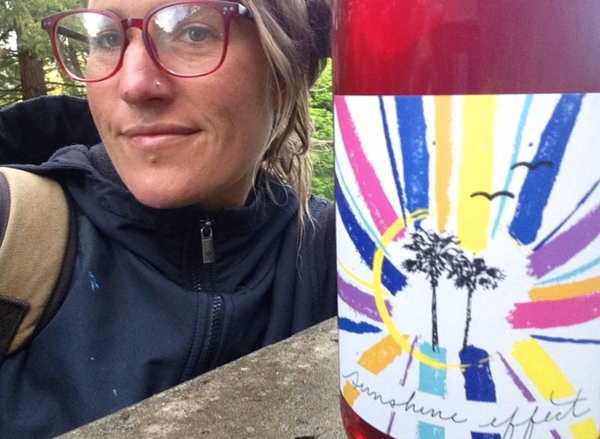
Jessica Wilmes’ Fair Moon Wine is about to release her new wines, a skin fermented (Pinot) Auxerrois white and what she calls “A half-assed carbonic Tinto Cao red, made from a rare Portuguese varietal that is starting to gain traction in the new world. Fair Moon is an all new ultra small-production micro winery, the looks to hand-craft unique tiny lot stuff with natural-driven winemaking, with, what Wilmes playfully adds, happy palates in mind. She is motivated by her own experiences, which have included years chasing harvest intern jobs, having to live out of her trusty Toyota Tundra truck and long hours for little pay, which has made her grateful for fleeting moments of calm. This has led her to make wines that are fun, quaffable and flavorful, for what she hopes will be enjoyed during everyday adventures or periods of total relaxation with friends and with lots laughter. Jessica’s first vintage, 2020 Sunshine Effect orange wine, highlights this pleasure seeking passion with skin-contact Pinot Gris, sourced from the cool climate Holmes Gap Vineyard nestled in the Van Duzer Corridor in the Willamette Valley with mainly marine sedimentary soils.
The name for debut effort, Sunshine Effect, originates from, as Wilmes explains, the daily moving of the fermenter outside into the sun to kick off fermentation. Wilmes allowed her cool macerated Pinot Gris to go all with spontaneous yeast fermentation, with absolutely no additives, with short term aging in a single neutral French oak barrel and bottled unfiltered and unfined. This delightful reddish glowing wine, Wilmes says, is a wine that would flirt with you, bring good times and would always wear twirly dresses if it was a human, I can see that! Digging into modern natural wines can be a painful task at times with lots of weirdness out there, something that Wilmes herself admits and while she embraces the funk and doesn’t shy away from it here, she also is not a fan of seriously flawed or is driven by pure dogma over the goal of making a wine of balance. Wilmes’ “Sunshine Effort” bottling, was inspired by some of the world’s most intriguing skin contact white wines, known as orange or Ramato wines like those of Gravner, Radikon, Skerk and Zidarich in northeastern Italy, as well as a few closer to home, like Oregon’s Cameron’s skin contact versions.
Jessica’s journey into wine is best told through her own words, so I have let her tell her story here as I eagerly await here new releases.
Me: Jessica, so I know you as a young winemaker who just got your own label up and running, and I must say, I loved your first release, but before this you had a long and humorous struggle to get here, so how did it all start for you?
Jessica: Ok, I have no idea where to begin with this except to say I that used to drink SH*TTY wine and was perfectly okay with it. Not that there is anything wrong with people drinking what I used to drink and liking it, but wine is like any other learning process and eventually you reach a philosophical point of understanding and there are fireworks, and cheerleaders, and lightbulbs, and “a-ha”s, and this uplifting feeling of “Oh my God I get it!”. It’s like a little wine fairy comes along and hands you your official wings to transcend the daily babble of planet Earth and fly into the whimsical world of wine to fully experience all of its art-meets-science-meets-wonder euphoria.
And believe me, if the World of Wine were a video game filled with challenges of learning wine from tasting, to production, to the artistry and passion that moves the whole darn thing along, I would still be down on a very low level striving to get extra lives, wine coins and a superpalate. I am, in all seriousness, levels away from King Bowser. Wine, like anything else, requires time, energy, interest and a willingness to not give up on it. My personal journey thus far has been nothing shy of a total frustration-satisfaction yoyo. So, let’s start from the beginning and go from there.
Me: Okay, so are from a state that is not known for wine right?
Jessica: (as if a confession says) I WAS BORN IN NEBRASKA AND MY PARENTS DRINK BUSCH LIGHT AND KIRKLAND VODKA. This is in uppercase because I want to accentuate the fact that I did not grow up with wine-drinking parents, nor did I grow up in a wine region or, for the very lucky, in a wine producing family on a freakin’ vineyard. It has taken me a little time to grapple with this fact, mostly due to my own insecurities of where I stand in my wine knowledge and very jealous of those who at times seem to have had an unfair start at life in wine, but of course I have to call out my own BS on this one because we all start every journey somewhere and whatever came before eventually led us to where we are now. And, more importantly, my parents are super amazing and total party animals and if one were to even attempt to party like they do it makes perfect sense not to play quarters with a Burgundy Grand Cru.
Me: In the last few years you’ve worked for some impressive Oregon wineries like Troon in Applegate Valley and for John Grochau, a very serious Pinot producer in the Willamette Valley, and last year you got to see Violin and Vincent up close, that must seem far away from your college days and early experiences with wine?
Jessica: (she sums up her college years as her Franzia years) FRANZIA. Have you had this? It is poison. Please stop drinking it. Or don’t, but know it is not actually wine. I’m pretty sure the label even mentions something along the lines of this being a “wine product”. What the heck does that mean? Wine product? For me, that is enough to stop slapping the bag. However, Franzia was the delight of my freshman year Fridays in the dorms when a few other gals and I declared “Franzia Fridays” and drank whatever available blush bagged wine we could get our hands on before venturing out to house parties that surrounded the university campus. It’s funny now when I look back on it and try to remember caring about how the wine tasted. This is probably where my parents could have influenced me.
If I had known what real, good wine tasted like, I maybe wouldn’t have guzzled down boxed-wine nonsense. But, so it went, Franzia Fridays, Andre-sparkling Saturdays, and Gallo three-dollar-something or another Day throughout the week. Inspired by two summers abroad in Europe, I unrealistically felt I advanced my understanding (oh, because I bought 1 euro boxed wine in Barcelona?) and during my junior year I used my fake ID to buy wine at Walmart so my friends and I could be “classy” and have some red with movie night. Maybe it was better than jungle juice, but really I now know I was drinking wine laden with a potential 70-plus approved ingredients by the FDA, from vines that were sprayed with RoundUp and a finished product that tastes nothing like what the initial grape or land it was grown on would have represented. I guess it tasted more like jungle juice, which is why we liked it.
Now, back to the present, Jessica who is a Gamay freak, likes to drink Cru Beaujolais, especially Anne-Sophie Dubois’ Fluerie and Foillard Morgon, is making natural style wines from unique and rare grapes in the Willamette Valley and hopes to eventually find the right vineyard to source Gamay, so watch this space. It is never easy to start a winery or a label, especially when you don’t come from wealth and made even tougher during a global pandemic so I have incredible respect and admiration for what Jessica has achieved and I am waiting no so patiently for her new bottlings…. You can follow her wines at www.fairmoonwine.com and on Instagram at: @sunshineeffectwine
Book Review
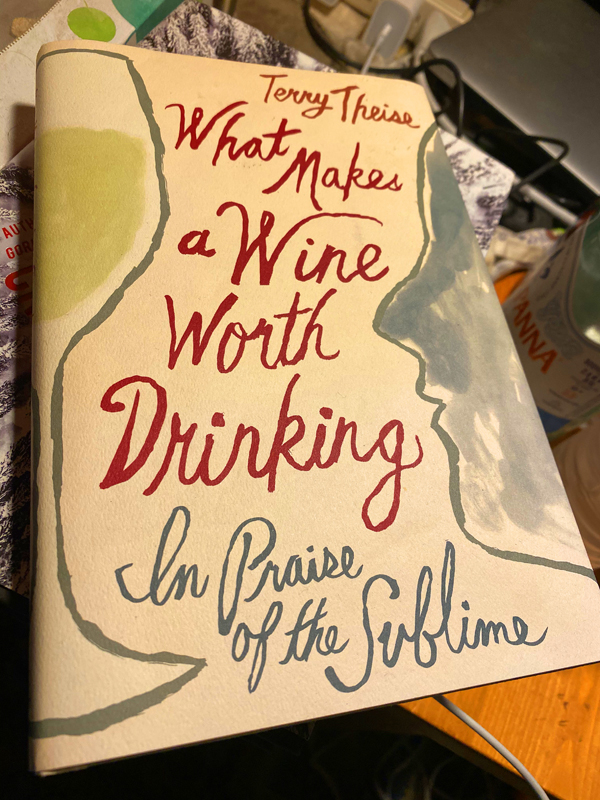
For almost 20 now, I’ve experienced to joy, almost like a Christmas morning opening presents like a child when I got the new Terry Theise/Skurnik sales catalogs, these magical and lyrical efforts always set my mind a light with grinning ear to ear joy, they must be the best, heart felt and most expertly written trade literature ever made. I know that these played a huge part in my personal exploration of German wine and gave me the push to visit the country. Seeing Terry, at his tastings, often wearing his Jesus Drank Riesling T-Shirt meant a new discoveries, meeting new winemakers and finding a new way of look at wine and the men and women that make them. Now we have a series of books by Theise that focus our thoughts on wine and its meaning. The book What Makes a Wine Worth Drinking – In Praise of the Sublime is not an easy read for the novice or those looking for absolutes in a simple fashion, but it is truly important wine literature, brilliantly written by one of my favorite personalities in the wine world Terry Theise, one of the great influencers in the business. There is so much to cover and explain, it gets difficult to relate this piece of work to others, it is one that moves individuals in their own mind and explores the meaning of wine to you, first and foremost, but also to the producers that try their best to share their homes, their histories and terroirs with you. Terry tries to guide to authentic wines, wines that are divine in subtle delicacy and away from the blitz of screaming fruit and oak driven factory beverages that lack a soul, he is convincing and well meaning, hoping you’ll support the true heroic vignerons that make wine from the heart. This book is thought provoking and leads its reader to the joys of lighter and more refreshing wines, but still wines that are profound, impactful and yes, as Theise submits, the sublime.
Over the years I’ve spend some time with Terry and I have been incredibly inspired by his gentle guidance and I cannot begin to thank him for the introduction to so many wines and people that have changed my life for the better! This is a book that will take you on Terry’s journey, hearing his purpose, though the more you read the words you’ll see your own path and clarify what you want in wine and what it gives you. Theise is well aware of his palate, its brilliance and limitations, this is a refreshing bit of honesty that should be rewarded with your attention, much like he wants you to remove the noise and really listen to the wine in your glass. Theise covers a lot of territory in his sometimes challenging prose with everything from soils expression to climate change and his own pet peeves, like higher alcohol wines, but he wraps it up with lots of inspiring antidotes and humor. Some will think this book appeals to professionals and especially sommeliers, but I think it will give everyone something meaningful to remember. Terry Theise has brought German and Austrian wines, almost single handedly, into the mainstream in America with his amazing portfolio of vintners and his collection of grower producer Champagnes has changed the way we think of this region, he and Kermit Lynch are a big part of why we love old world wine in America. The What Makes a Wine Worth Drinking – In Praise of the Sublime should be in every wine lovers collection, it’s a guide to finding beauty in wine and in life and gives you reason to find time enjoy the quiet moments and calm with the wines and people that mean something to you. I highly recommend taking a dive into this essay and I suggest following Terry’s new blog on his recently launched website at www.terrytheise.com
($16.20 Est. Amazon, $12.99 Kindle)
Book Review
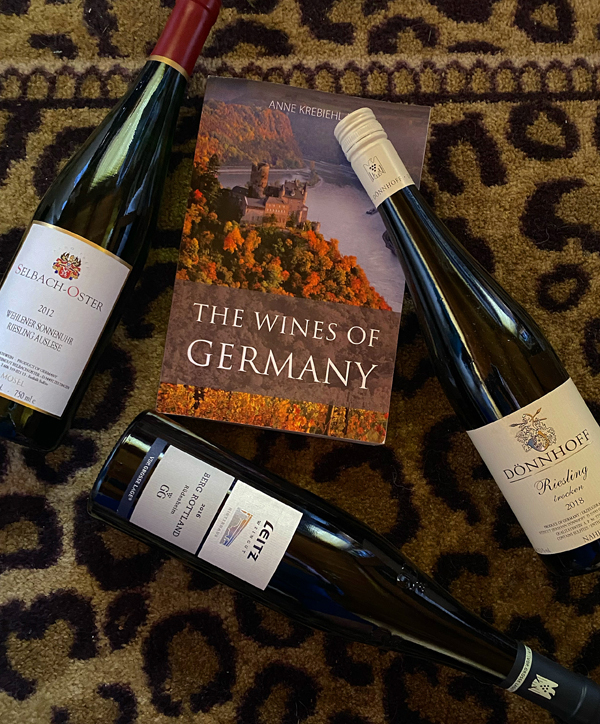
The Wines of Germany
by Anne Krebiehl MW
I am really glad I got this book, The Wines of Germany, by Anne Krebiehl MW, Anne has done an amazing job of research here on this incredibly informative tome and she has with some talent made it easy to understand and readable. With German wine law being as dysfunctional as it is, she has made it as clear as possible, which was no easy task even for a Master of Wine, like she is. You can through the pages see Krebiehl is passionate about her subject and knows her stuff, she has a real grasp of Germany’s past, present and future. The layout and chapters are well thought out and go by with surprising ease, this includes a ton of history of both Germany, its wines and individual personalities, plus a great overview of each of Germany’s 13 main regions, from the Mosel to the Rheingau and beyond. There is everything you’d want and more about climates and terroir, plus it goes deep on winemaking styles and almost every varietal and where they thrive, with a heavy lift on Riesling, as one would expect, as well as a nice amount of time given to Spatburgunder, Germany’s name for Pinot Noir. It was also good to see loads about my favorites and old friends, like Donnhoff, Leitz and Selbach, to spotlight just a few.
Of course there are things, grapes and producers that were overlooked, but overall there is so much is here, there can be no complaints, plus there are some great finds here, and I will be doing my best to get my hands on some of Anne’s recommended wineries and future stars, including Gesine Roll of Weingut Weedenborn in the Rheinhessen and Weingut Benedikt Baltes in the Franken region, to name a few. There are plenty of pages dedicated to the classics and the established stars too, with many interesting tidbits about the domaines and I learned a lot, and I’m well informed about German wine and have visited many times! There’s much here that you’ll want to have on hand or close to hand if you are studying the wines of Germany or planning to travel there to visit the main wine areas as well as the lesser known spots. I got my copy early out of England, but it is now widely available and on Kindle too, if you are an acid freak or Riesling fan you’ll want this book.
($40 Est. Paperback – Kindle SALE $16.17 – as of 4/4/20)
94/100 Rating, grapelive
Latest Thoughts
The Chenin Renaissance by Kerry Winslow, grapelive.com
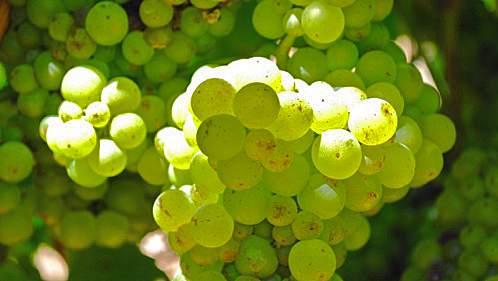
Chenin Blanc, the famous grape of Vouvray and Montlouis, also known also as Pineau de la Loire among other names, is a white wine grape variety from the Loire Valley of France where it makes some of France’s most sought after wines like those of Domaine Huet, Chidaine, Joly and Guiberteau. Chenin has been in California for a longtime and it was once as popular as Chardonnay if not more so prior to the early 1980s. Recently this grape has made a comeback and is highly regarded by sommeliers and wine geeks with many outstanding examples being made throughout California, below I am highlighting a few that really standout. Its high acidity means it can be used to make everything from sparkling wines to well-balanced dessert wines, although it can produce very bland, neutral wines if the vine’s natural vigor is not controlled. This renewed interest and the rise of Chenin in California looks set to be a thrilling movement, that looks unstoppable as people look to exciting alternative offerings, one just has to look at the success of Albarino and even Gruner Veltliner to see this is not just a passing fade.
Outside the Loire it is found in most of the New World wine regions, in fact During the 1980s, the California wine industry had more acreage of Chenin blanc planted than France, though the numbers of plantings later steadily declined. it is the most widely planted variety in South Africa, where it is also known as Steen and like California, there are some amazing versions too, like those from Sadie Family, Reyneke and Mullineux. For most of its history in the California wine industry, the grape was considered a “workhorse variety” that could be used anonymously in bulk and jug wine blends, but there also was some fantastic versions being produced, anyone who had Daniel Gehrs, Chalone, Casa Nuestra, Durney or Chappellet, just to name a few, can tell you these are and were amazing examples. Chenin’s natural acidity and ability to adapt to wines of varying degrees of sweetness made it an ideal blending partner with Colombard and Chardonnay in mass-produced blends, as well as making interesting dessert versions like those made by Sterling Vineyards during the 1970s.
Chenin grows from the Baja to Mendocino to great effect with serious plantings in Santa Barbara County, the west side of Paso Robles, Monterey County, the Sierra Foothills, Lodi, Clarksberg, Sonoma, Napa Valley and the mentioned Mendocino County, and there are a number of vineyards that date back to the middle of the last century.
The newer generation of Chenin champions in California include some exciting new producers as well as some old hands, including talents like Ted Lemon of Littorai, Pax Mahle, Chris Brockway of Broc Cellars, Justin Willett of Lieu-Dit, Andrew Jones of Field Recordings, Combe by Raj Parr and Stolpman Vineyards, Tegan Passalacqua of Sandlands, Russell Joyce of Joyce Wine Company, Jaimee Motley as well as the classics still made by Nuestra, Chalone and Chappellet. It is a great time to re-discover Chenin Blanc in California as it re-emerges from obscurity to center stage, here are three wines to look for that are either out now or will be very soon, these are small producers that focus on handcrafted wines and have put a lot of effort into making these beauties to highlight the grape’s best qualities and terroir. Chenin’s rebirth in California is rewarding to watch in real time, especially with these wines. Paragraph
New
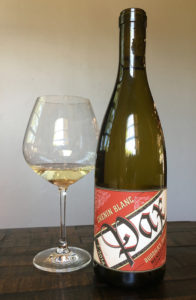
2016 Pax, Chenin Blanc, Buddha’s Dharma Vineyard, Mendocino County.
Chenin Blanc has made a remarkable come back in California in recent years, it was arguably the best white wine in California back in the 70s, 80’s and into the early 90s, but had fallen into obscurity until these times with people like Ted Lemon of Littorai, Andrew Jones of Field Recordings, Justin Willett of Lieu-Dit, Raj Parr of Combe, Jaimee Motley, Tegan Passalacqua of Sandlands, Royce Joyce of Joyce Vineyards and Pax Mahle, who has made this new one under his Pax label, but has been doing awhile under his old Wind Gap label. Those old school wines, like Daniel Gehrs, Durney, Chalone, Chappellet and Casa Nuestra (still making it) from old vines were unique wines, so I’m glad this grape has made its rennesaince in California, This Pax 2015 Buddha’s Dharma Chenin shows exceptional and crystalline flavors and has a crisp and tangy dry palate with classic varietal presence in the glass. Pax crafted this bone dry wine with native yeasts, whole cluster pressing, he fermented his Buddha;s Dharma in a combination of stainless steel, concrete plus used barrel and raised it all well seasoned neutral french oak casks for 10 months, finishing up at 12.9% natural alcohol, which shows it this wine’s cool refreshing presence in the glass.
Planted in 1944 just north of the City of Ten Thousand Buddhas, this old vine vineyard is one of the gems of Mendocino, it’s dry farmed without chemicals, to organic principles at the base of Enlightenment Mountain. The Chenin is grown on gravelly volcanic soils, and Pax says he is absolutely amazed at the concentration and intensity of fruit from these vines. The 2016 Pax Chenin is flinty and smells like liquid rock, almost Riesling like in intensity, and is wonderfully brisk in detail with lifted citrus at its core, but as the wine opens you realize just how much more is there, it reveals white peach, white flowers, lemon/lime and golden fig notes. I can imagine this amazing Chenin aging close to two decades gaining in complexity with every year, those that like the classic Saumur or Savennières, think Joly or Domaine aux Moines! This wine is more mineral driven than fruit driven with a steely core that again is more similar to a dry Riesling or Chablis, though again with air it fills out on the palate and adds spicy elements, wet stone and light herb notes, and food really makes everything come alive even further, especially creamy cheeses and or even oysters. Lingering with delicate floral tones and a hint of paraffin/wax this is a lovely crisp white wine.
($26 Est.) 93 Points, grapelive
New
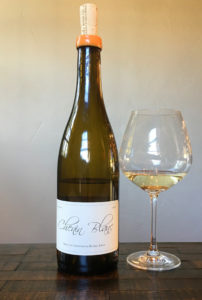
2018 Russell Joyce Small Lot Collection, Old Vine Chenin Blanc, Carmel Valley, California.
The new edition of Small Lot Collection by Russell Joyce, of Joyce Vineyards, is an amazing old vine Chenin coming from the Massa Estate, formerly the Durney Estate Vineyard in Carmel Valley and it’s a great example of vintage and terroir, it is a unique and powerful expression of this Loire white grape. The 2018’s intensity, vibrancy and density is on full display, showing beautiful definition and sharp detailing, but with an expansion on the palate that is utterly compelling and impressive, it is a wonderful wine of purity and class. The 2018 is rich and mouth filling without being ponderous or heavy, in fact has almost the driving force of a red wine in character such is the impression it makes, even for such a young wine it gives a spellbinding performance, especially when it gets air and paired with food. Russell, who killed it with his Gamey Noir bottling under his personal label, has crafted another thrilling wine, using native yeasts, whole cluster pressed juice with about 8 hours of skin contact and barrel fermenting for his Chenin Blanc along with employing well seasoned French oak for the six months of lees aging, making for a wine of substance and textural charm. Chenin has a long and cherished history, locally as well as all California where it was one of the greatest white grapes before Chardonnay eventually took over, and while seemingly an obscure Loire varietal, it’s re-emergence is looking like one of the most successful comebacks of all time, especially in Sommelier and wine geek circles, and this Joyce Small Lot version is without question a real Geek Star wine!
Getting an extended pre-release preview and drinking it over several days really proved the quality on display here, even after four full days this wine shined with crystalline mineralilty and grace, it never for a minute dropped off and delivered on its promise with each and every sip, impressive for a wine recently bottled and I can’t wait to see this in a year or more, I expect it will be much better, which means it will be astonishingly good. The 2018 has layers of white peach, pear and lemon fruits along with a seductive aromatic profile that hints of orange blossom and honeysuckle, which is offset by leesy notes and a stony personality adding a phenolic element, unsweetened honeycomb/wax and wild fennel. Time and air reveals more width and dimension allowing this Chenin to fill out in the mouth without losing its steely charm or focus with the fresh acidity holding everything here in check, though you can tell it will get more brioche and butter cream with bit of age, but not anytime soon. This is exceptional Chenin, it will be very limited on release, so you’ll want to be sure to let Joyce know you are interested, it joins an elite group of producers that are leading a California renaissance of this grape, like Raj Parr, Pax, Littorai, Lieu-Dit snd Jaimee Motley to name a few that are bringing Chenin back to the top of the states white wines, don’t miss it.
($35 Est.) 93+ Points, grapelive
Previously Reviewed
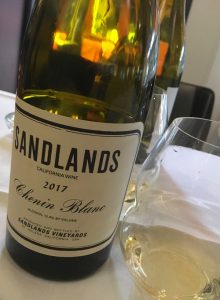
2017 Sandlands, Chenin Blanc, California.
Tegan Passalacqua’s inter-regional Chenin, under his Sandlands label is a beauty with fresh detail and lively fruit with pure peachy charms and delicate mineral focus. This wine is 58% Chenin of Passalacqua’s own Kirschenmann Vineyard, in the Mokelumne River AVA of Lodi, and 42% Chenin from the Buhdda Vineyard located on the Talmage bench in Mendocino County. Wonderfully balanced and rich in texture this graceful white is only 12.4% natural alcohol, making it feel easy to quaff, though it comes through as a complex and serious wine. The Sandlands label is the personal project of Tegan and Olivia Passalacqua, a small winery that does a line-up that encompasses some the forgotten classic California varieties, like this Chenin Blanc as well as Mataro (Mourvedre) primarily grown on decomposed granite/sand. Tegan gets his grapes from regions and vineyards that have been farmed for many generations, but maybe have remained the outliers of California viticulture, featuring mostly head-trained, dry-farmed and own rooted vines, with vineyard sites that, as he puts it, harken back to California’s roots of exploration, wonder, and hard work.
Tegan, a Napa Valley native, got his start in the wine industry working in winery labs in Napa, but quickly established himself as a talent. For the past eleven years, he has worked for Turley Wine Cellars, working his way up from harvest intern to Winemaker/Vineyard Manager, where his has crafted some of America’s best wines, especially his old vine Zinfandels. Additionally, he has worked in the cellars of Craggy Range in New Zealand with Doug Wisor, with Eben Sadie in the Swartland of South Africa, and with Alain and Maxime Graillot in the Northern Rhone Valley of France, all of which are legends in the wine world. Getting back to this brilliant 2017 Chenin, it’s hard to resist with layers of the mentioned peach, honeyed pear and vivid citrus on the medium bodied palate and the aromatics are exceptional with wet stones, white flowers, clove and apple butter that fold into the background flavors very nicely. The wine opens and expands with air, but still keeping its fresh and crisply dry nature all the way. it is a well judge effort that will drink well for quite awhile, be sure to look for this very reasonably priced white.
($22 Est.) 92 Points, grapelive
Latest Article
Galicia’s Star is Rising
Spain’s Galicia region on the Atlantic coast is a historic wine area that goes back to pre Roman times and while remote and almost forgotten this is a region on the rise and with an amazing array of wines and passionate winemakers. From Bierzo’s legendary winemaker and guru Raul Perez, the godfather of Mencia, to new stars like Nanclares y Prieto, Veronica Ortega and Enivante’s Ribeira Sacra project. Here are a few of their offerings, they are really worth searching out, even though hard to find in some cases in the states, these are wonderful terroir driven wines.
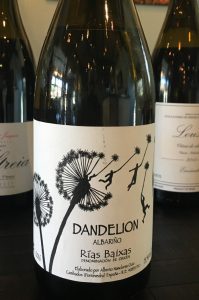 2016 Nanclares y Prieto, Albarino “Dandelion” Rias Baixas, Galicia Spain.
2016 Nanclares y Prieto, Albarino “Dandelion” Rias Baixas, Galicia Spain.
Beautiful pure and almost Kabinett/Feinherb Riesling like (intensity of form) with generous flavors in the mouth this gloriously delightful Albarino from Alberto Nanclares and Silvia Prieto is vivid, saline and textured with bright green apple, tangerine and peachy stone fruit on the crisp palate, with wet stones and light spices, it’s so well balanced you’d think it might be slightly off dry, but with brisk energy giving it a cat like taught muscle like focus! The unpretentious and humble Nanclares is one of Albarino’s great stars from the Cambados area of the Rias Baixas region in the Atlantic influenced Galica, his wines all from organic grapes show a leesy depth, while still being mineral driven and salty, with this Dandelion cuvee coming from 30 to 60 year old vines near Val do Salnés grown on sand and granite soils, right at sea level with locally historic pergola training. The Dandelion is fermented with native yeast, naturally, in stainless steel with no malo and aged a year on the fine lees, it is unfined and unfiltered allowing the complete capture of every nuance and terroir elements, and this 2016 is the best yet, that I’ve tried on this wine, it’s detail and varietal vitality is fantastic, especially for the price. This wine will be killer with crab this holiday season and is an amazing sea food cuisine partner, from oysters to grilled baby octopus as well as mackerel and sardines, it makes my mouth water just thinking about it! Drink it now and often, not easy to find, Silvia and Alberto have a cult following, I got my bottles from Vinopolis Wine Shop in Portland, Oregon, and it’s well worth the search as is their estate bottlings as well as is their super rare Mencia (Ribeiro Sacra) offerings, imported by Jose Pastor Selections, these are not to be missed wines from Galicia.
($22 Est.) 92 Points, grapelive
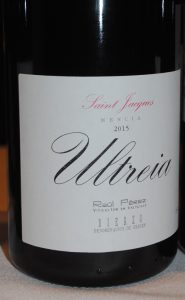 2015 Bodegas y Vinedos Raul Perez, Mencia, Ultreia Saint Jacques, Bierzo Tinto, Spain.
2015 Bodegas y Vinedos Raul Perez, Mencia, Ultreia Saint Jacques, Bierzo Tinto, Spain.
It was a great honor to meet and taste with Raul Perez, one of Spain’s most heroic and influential winemakers, also known as the godfather of Mencia, at the Skurnik Wines West Portfolio tasting in San Francisco, it was an amazing event and collection with a fantastic array of producers and wines. Raul Perez’s lineup was mind-blowing and lived up to my huge expectations in every way, and I was wildly thrilled with each and every one of these offerings, especially this new Ultra Saint Jacques Bierzo Tinto that delivers wonderful depth and complexity at a price that makes it a bargain by any standards. Perez has mentored many rising stars, including Pedro Rodriguez, one of my all time favorites, at Guimaro and still has Veronica Ortega, who’s wines I recently discovered, working with him. Made from mainly from Mencia, but with some inter planted Bastardo (thought to be Trousseau) and Garnacha Tintorera (Alicante Bouschet) coming off vines that average about 75 years old, this dark and ripe vintage shows an almost northern Rhone like character and has a earthy/savory/spicy edge like an lighter Cornas. This Bierzo Ultreia Saint Jacques Tinto was fermented with native yeasts, about 80% whole cluster in large oak cask with long macerations lasting between 2 and 5 months and then aged in mixed vessels including some cement, as well as 225L and 500L oak, unfined and unfiltered. It’s pretty in detail with violet/floral tones, peppercorn and a medium body that flows with sweet tannins, vibrant, but smooth acidity and flinty mineral elements as well as a core of loganberry, plum, candied cherry and tart currant fruits as well as salted black licorice, lavender, pipe tobacco, shale stones, earthy charms and a hint of cinnamon. This 2015 is lovely stuff that drinks very well right now and should prove pleasing for 3 to 5 years, for this price you’ll want a case!
($20 Est.) 93 Points, grapelive
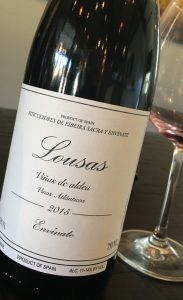 2015 Viticultores de Ribeira Sacra Y Envinate, Lousas, Vinas de Aldea Vinos Atlanticos, Ribeira Sarca, Galicia Spain.
2015 Viticultores de Ribeira Sacra Y Envinate, Lousas, Vinas de Aldea Vinos Atlanticos, Ribeira Sarca, Galicia Spain.
The gang at Envinate has crafted a gorgeous wine here, after allowing for it to blow off it’s slight reductive funk, it turns beautiful with classic peppered violets and damson plum, and it’s vital medium body gives subtle pleasures and life, wow this 2015 is a seductive charmer, especially after plenty of air. Envinate, which means “wines yourself” is four friends that are from vastly different regions of Spain from the remote Canary Islands to Murcia, they are winemakers Roberto Santana, Alfonso Torrente, Laura Ramos, and José Martínez, all regional stars, if not superstars! Roberto Santana almost singlehandedly has made the wines of Tenerife mainstream and world renown with his volcanic and rustic offerings made from mostly mission grapes, especially Listan Prieto, but his partners have had almost the same successes from their areas too, and this 2015 Viticultores de Ribeiro Sacra y Envinate Lousas comes from vines overseen by Alfonso Torrente, and it’s one of the best Envinate I’ve tried! And this is their village level offering! It’s all Mencia (think Syrah meets Burgundy with a touch of Fleurie mixed in!),100% whole cluster, native fermented in bins and then raised in used mid size oak casks without racking, bottled with a tiny amount of SO2, unfined and unfiltered, it’s a beauty with lovely detail and lots of mineral spice. The grapes are hand tended from steep plots, these Sil River valley slopes look like the Rhein or Mosel and the soils are smoky slate and granite, which gives these Mencia wines their likeness to the Northern Rhone, in particular Cornas and St Joseph, as is so in this Envinate Lousas (Slate in Galician) Vina de Aldea, sourced from 60 year old organic vines. The contrast of sweet violets and red pepper and flinty notes really is really seductive and entrancing, I love this stuff, this and Pedro Rodriguez’s Guimaro are two of my favorite Ribeiro Sacra wines, drink over the next 3 to 5 years easy.
($38 Est.) 94 Points, grapelive
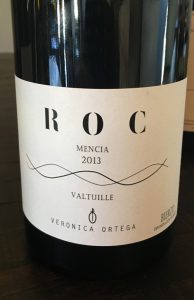 2013 Bodega Veronica Ortega, Mencia, ROC, Valtuille, Bierzo, Spain.
2013 Bodega Veronica Ortega, Mencia, ROC, Valtuille, Bierzo, Spain.
The carefully hand harvested ROC by Veronica Ortega is bright and fresh with an almost Dolcetto like bite and feel, but gains with air and becomes a bit more serious with time in the glass, turning into a lovely full flavored Mencia. Veronica, the Cadiz native, who has trained around the world including a stint at Burn Cottage in Central Otago with Ted Lemon and was mentor by the famed/legendary Raul Perez, uses 80-100 year old vines for her signature ROC bottling, with native yeast ferments and 14 months in French (mostly well seasoned) barriques, showcasing her Valtuille terroir in a less overt manner than some Bierzo, crafting a wine that highlights the mixed soils which include clay, sand and slate and at good elevation, which allows vitality and structure. She ferments in cement vats with normal punch downs with a 20 day maceration, with 50% whole cluster from organic grapes, making a wine with traditional character and with aging potential, it’s got a pop rock feel right now, but it looks set to get really rocking good over time! Interesting, Ortega’s ROC continues to remind me of Piedmonte, with a full Barbera like color and Alto Langhe Nebbiolo like feel on the firm/youthful palate! The ROC 2013 starts with earthy blackberry, tart cherry and tangy currents, it’s still primal on entry with a tight slightly closed feel before giving way to sweet raspberry, strawberry and plum fruits along with bitter citrus peel, light herbal notes, mineral tones, balsamic/iodyne and wild spices, finishing with some tannins and delicate wood shadings. Imported by Eric Solomon Selection, Veronica’s wines are not always easy to locate, though are starting to attract more attention, be on the look out for her latest releases!
($35 Est.) 92 Points, grapelive
Also look for the wines of Guimaro, Luis Rodriguez and Laura Lorenzo, the region’s newest superstar! See reviews at grapelive Reviews
A Very Serious German Wine Adventure with Scenes from the Rheingau and Nahe at Harvest 2016.
By Kerry Winslow, grapelive.com

In October of 2016 I went to Germany on a mini vacation, staying five days in total, it was a busy time with harvest having already started, but I did manage to visit four wineries, Leitz, Kruger-Rumpf, Schlossgut Diel and Spreitzer, all welcomed me with warm and graciousness beyond all expectations, especially considering my timing. Being in the right place at the right time never seems to describe me, but I was lucky this week and a glimpse of the beauty and stress of harvest in some of the world’s most beautiful regions, the Rheingau and the Nahe, two of the best for Riesling you can find. While I adore the Mosel and the Pfalz, I happened to focus my limited time to mainly to the Rheingau around Rudesheim and the Nahe closer to the Bingen side as I was mostly on foot, train and ferry while staying in Rudesheim on the Rhein. The hiking here is thrilling and includes dramatic vistas of the river, forest and steep vineyards, and since this was mostly a vacation get away I didn’t make all that many arrangements or appointments, I certainly wished I could have seen and met up with more people, for that I’m sorry to those I couldn’t get to, but still I got to see some old friends and a few new ones, and I got unequaled access to the whole harvest experience at Weingut Leitz, toured their vines with Markus Roll, Leitz’s dynamic young vineyard manager, as well as have a few wonderful diners with my friend Johannes Leitz, one of the world’s best vignerons and all around fantastic person.
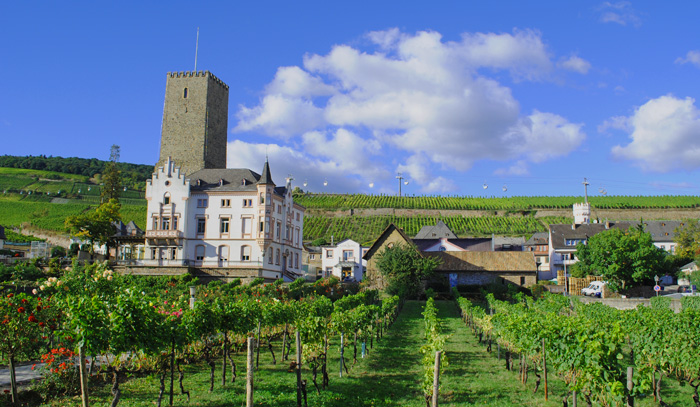
It was also great to visit Andreas Spreitzer and family at Weingut Spreitzer in the upper Rheingau in Oestrich-Winkler, who in 2015 turned out some of the old wineries best wines ever and is a winery on the rise. Crossing the Rhein, to Bingen and on the Dorsheim, I got to see Georg and Stefan Rumpf bring grapes in and tour their very old cellar as well as getting a are chance to taste at Schlossgut Diel as they brought gorgeous Pinot Noir into their cellar! Even with all the craziness and stress, everything went smooth as silk and I am grateful for all the warm and kindness I felt from everyone. 2016 didn’t look good in July when they all had a deluge of rain and cold weather, but a miracle came in late August when the sun returned and gave real salvation and bright days, and through September things came back on course so much so that now in October the Riesling grapes look and taste fantastic, and with the cool weather as I write they will be able to pick at a more leisurely pace and give the grapes a longer hang time for the more serious bottlings, and even the Pinot Noir came in beautiful, though careful sorting and de-stemming was employed.
The Rheingau is a Region Re-discovering it’s Historical Greatness and Finding it’s Place in the Modern World!
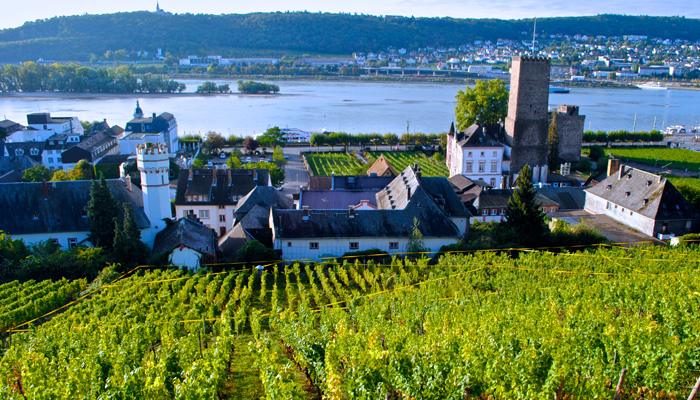
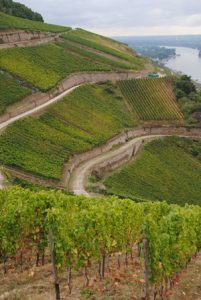
Rudesheimer Berg “Magic Mountain” I love this place, it is one of my favorite spots in the world, I first came here in 2009 and hiked these vineyards, and I am still in awe of Rudesheimer Berg, from Hinterhaus below Rottland, and Roseneck to the top of Kaisersteinfels, as well as Drachenstein and Ehrenfels castle, Schlossberg, this is a breathtaking experience, with every labored step up through these vines a cherished moment in time, beautiful and historic. This should be a world heritage site no question. Hundreds of years as the world’s most treasured wine center, the Rheingau has a long history of trade, from the Romans to the church, this was the spot and Riesling was (and is now) the shinning star! If you really love wine, historical sites and the outdoors, and especially if you are fit and don’t mind a little exercise, you’ll need to visit Rudesheim… Weingut Leitz enjoys some of the very best plots in these Crus, and his team is keeping them in, from what could see, the best shape, in fact they are spectacular! Johannes Leitz makes some of the most drinkable and pleasing wines in the world, he is a great producer, a great and tireless ambassador for the Rheingau and a most serious and thoughtful winemaker that continues to reach for new heights. Every time I see him I learn volumes of new information, see a whole new world and feel even more passionate about these wines and especially this very special place, it’s funny we all know the Rheingau, or think we do, but is has many surprises and in fact it is one of the smaller wine regions in Germany, almost twice as small as the Nahe by comparison, which is small too!
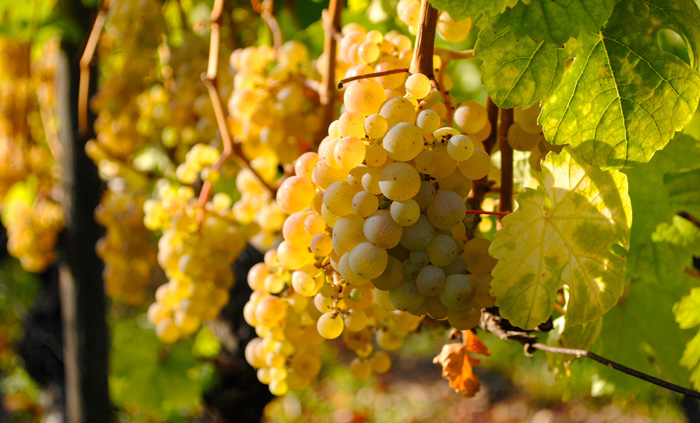
I look at the Rheingau, rightly or wrongly in three area, Rudesheimer Berg, the upper Rheingau at the widest part of the Rhein River, that includes many terroirs, and Assmannshausen, a shrine to Pinot Noir. Rudesheimer’s main crus, Roseneck, Rottland, Schlossberg and Kaisersteinfels are mostly slate influenced with some red quart, while the Drachenstein a long thin band above has a quartzite influence with some loam and slate, each is unique, this is home to Grosses Gewachs or Grand Cru and in the case of Drachenstein, Erste Lage or Premier Cru Trockens the most serious and dry of German wine overseen by the VDP control, but also you’ll find some of the world’s greatest off dry and or semi sweet wines too, while the world is screaming for the dry wines, you must not dismiss the fine Kabinett and Spatlese, as well as the non classified QbA’s that can have various levels of sugar, these are not dessert wines that can be just as monumental as the Trockens, when balanced and full of acidity they are mind-blowing.
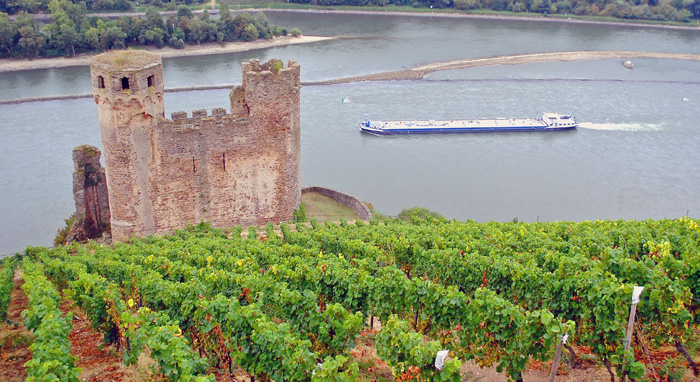
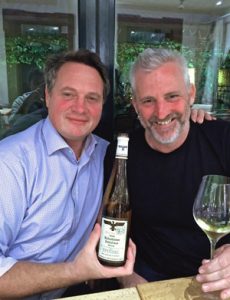
The Leitz Kabinett and Spatlese wines are especially intriguing with detail, clarity and length, in fact they are in some cases more rewarding than GG’s, don’t get blinded by the false sugar issue, these are very sexy wines with terroir personalities to cherish, in particular the 2015 Weingut Leitz Riesling Spatlese Rudesheimer Berg Roseneck stands out, it is simply an awesome white wine of intensity and class with a lavish mouth feel rater than sweetness, search it out and enjoy it’s purity and opulence! The Leitz 2015 GG’s remind me of very young Grand Cru Chablis, tight and un-evolved, without question these are superior examples, but will exceptional with more age! Mind you, they aren’t bad now, especially as I was able to enjoy/drink them in their individual vineyards and terroir! Of the three 2015 GG’s I tried, Roseneck, Schlossberg and Kaisersteinfels, it’s the Schlossberg Ehrenfels that at this early stage stole my heart, plus the view wasn’t bad! Other notable Leitz wines include, the fruit driven 2015 Dragonstone, which is noticeably drier this vintage with it’s lowest RS to date, the steely Drachenstein Erste Lage Trocken and the absolute best value 2015 Rudesheimer Berg “Magic Mountain” a cuvee that comes from only top GG sites and sells for under twenty bucks! Leitz sets a high bar in the Rheingau with a tremendous set of wines that range from playfully fun to ultra serious, but all of the wines set standards for quality in level and offer stylish fun, seeing behind the scenes at Leitz was an insight few ever get the chance to experience, I found the commitment, ethics and dedication a thrill to witness and a joy to be part of. Attention to detail,from packaging, marketing, vineyard work and winemaking is second to none at Leitz, and while they use some high tech processes and innovate, these are wines of soul and a true love of place. Watch this space, the future is bright and full of excitement here!
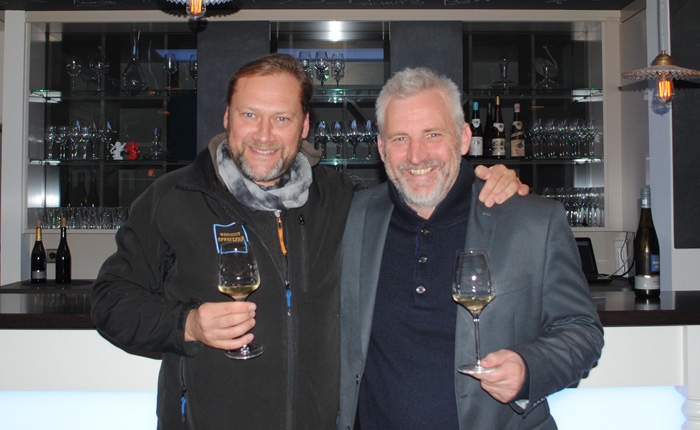
Andreas Spreitzer of Weingut Spreitzer picked me up in his Land Rover and took me on a tour of his vines near Geisenheim, Hattenheim and Eltville, but mostly his prized sites in Oestrich-Winkel above where the Rhein reaches it’s widest point. Spreitzer explained to me the almost lake effect his region gets and showed me the many micro climate and soils here in the upper Rheingau, it was like being exposed to a whole new world, vastly different than my experience in Rudesheim and my limited time in the Nahe. It was amazing to see each of these terrors translated through each different wine at Spreitzer, especially with the glorious 2015 vintage providing the perfect path to enlightenment on this area. Andreas and Bernd have really in recent vintages especially have fine tuned their lineup and crafted some excellent wines. The 2015 Grosses Gewachs from Spreitzer are decedent, opulent and engaging wines which have blossomed into glorious Rieslings since being bottled, I had found them closed and extremely tight as barrel samples when Andreas first sampled me on them at an early Terry Theise tasting, but now they are some of the best yet from this estate and rival some big names! There are many gems and wonderful wines in the latest set of releases here, in particular was the amazing old vine 2015 Hallgartener Hendelberg Alte Reben Trocken, only slightly less dense than the three GG’s, the Hallgartener Hendelberg shows a delicacy and mineral clarity that is truly exceptional, this might be my dark horse or sleeper wine of the vintage in the Rheingau! The mix of loess and loam, clay, red quartz and light slate of these vineyards makes for a head spinning mix of complex flavors! Other Spreitzer wines that need mentioning are without question include the lovely and over delivering 2015 Ostrich Lenchen Riesling Kabinett, the vigorous and thrilling 2015 Ostricher Doosberg Alte Reben Riesling Trocken and the beautifully perfumed and seductive 2015 Winkeler Jesuitengarten Alte Reben Riesling Feinherb, as well as the succulent Spatlese from the same vineyard, all of these stood out and deserve your attention, this is an area that needs a serious re-discovery!
The Nahe’s Glorious Future is Here Now!
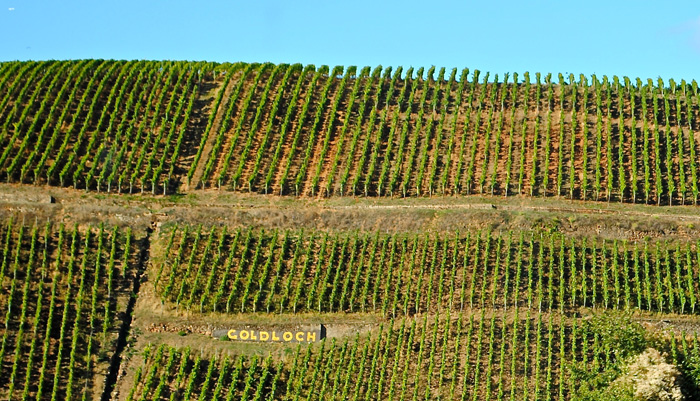
A visit to the Nahe at harvest is special, getting to meet up with two of the regions emerging talents, in a region full of very busy winemakers, is even more special! I followed by a day, a visit to the region by one of Germany’s most famous wine critics, and who reviews for Robert Parker, Stephan Reinhardt, so I guess in many ways I’m grateful, as both Kruger-Rumpf and Schlossgut Diel, the two brilliant family wineries I was lucky enough to see, had a extra rare bottles open, so Thanks Stefan! Getting to the Nahe, in my case from Ruedesheim without wheels, I took the ferry boat to Bingen, where Georg Rumpf picked me up with a big smile and a convertible Saab, borrowed from his mom, as his more workman and family like car was out in the vineyards with his crew, and off we went, into the heart of Bingen, a small old town across the Rhein from Ruedesheim, and the gateway to both the Nahe and the Rheinhessen, first stop was a brand new vineyard that Rumpf has acquired and have made one vintage from in 2015, the Abtei. The Abtei is an intense site, super steep and with great south facing slopes, it is set in mixed quartz and has some slate underneath it’s thin top soil, Georg jokingly calls it a hobby vineyard, because the cost of farming and adapting the vines here is and will be costly, but there is real potential here for beautiful wines, in fact I loved the 2015, the first try at wines from here, it’s vital and lively with great extract and full flavors. After this we stopped in at the winery where the crew was bringing in some Sauvignon Blanc, Georg was needed and jumped back into winemaker mode, as I passed on the man behind Kruger-Rumpf’s modern success, Stefan Rumpf, Georg’s dad and semi retired grandpa, he showed me most of wines, while Georg worked feverishly in the cellar.
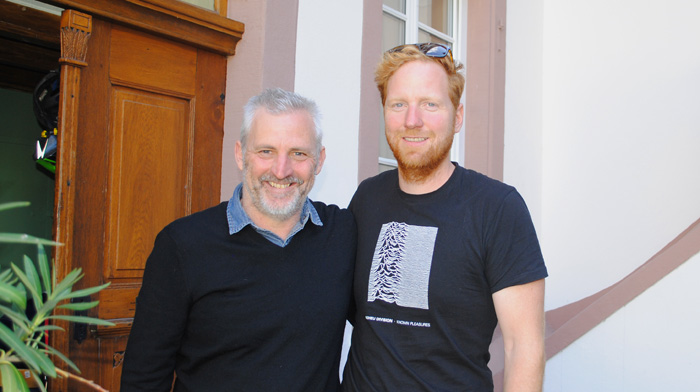
It was quite a cascade of wine that was presented to me with a few vintage items that shined including the 2001 Dorsheimer Burgberg, gorgeously full bodied dry and length, the 2006 Pittersberg GG from Munsterer’s Grand Cru vines, a delicate and refined effort that got more interesting and lengthy in the glass, even though it was opened the day prior, and the nervy and intense 2010 Pittersberg GG which is just hitting it’s stride and shows of the house style very well. Kruger-Rumpf is smaller than I had thought and is a really tight family affair, everyone is involved and the love of place is in the air, it’s all hard work, but with laughter and passion. I was impressed with all things Kruger-Rumpf, especially the current set of 2015’s, of course, they are stand out wines even in a region full of stars! Looking across the Nahe to the southeast is Scharlachberg, a Grand Cru site that is part of Bingen, but somehow within the Rheinhessen, the Rumpf’s have vines there to, and tasting the GG Scharlachberg was very memorable, it’s a massive wine with great detail, density and depth, it was one of my favorites of the lineup, even if it wasn’t strictly a Nahe offering, wink wink.
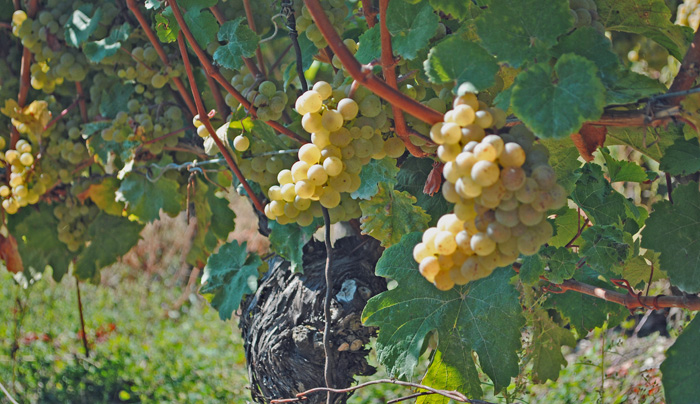
It was fun to lunch with the family and cellar crew, simple food and Kruger-Rumpf’s Sauvignon Blanc really hit the spot. Getting back to the wines, I must mention the Rumpf’s Scheurebe, one of the best examples of this varietal on the planet! Along with Muller-Catoir in the Pfalz, Kruger-Rumpf does stunning Scheurebe, it’s a must try wine, in particular look for the exotic and sexy 2015 Scheurebe Spatlese, again please, please forget seeing the Spatlese at all, this wine is decedent, opulent and lush, but it isn’t overtly sweet, it is deserving of your time and respect as a table wine, forget must weight and sugar levels and reap the rewards of an open mind and happy palate! I was able to taste almost ready to pick Scheurebe off the vine with Stefan and wow, it had a burst of tropical fruit like I’ve never experienced from grapes of the vine, pineapple, guava and kiwi exploded in my mouth, now I can’t wait for their 2016! One other wine that stood out for class and value was the remarkable Munsterer Kapellenberg Kabinett 2015, this is a stupidly good Riesling that feels balanced, pure and drier than expected on the palate, if you are a Riesling fan or bargain hunter this is a wine to look for! If you want authentic wine, made by hardworking and warm people, get Kruger-Rumpf, you can taste love of family and terroir in all of their wines, do not miss the 2015’s.
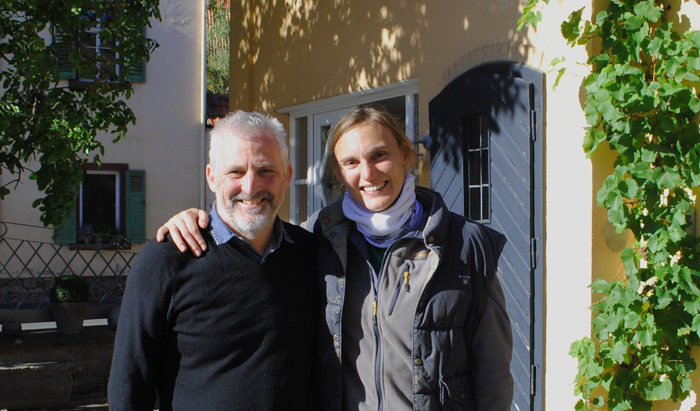
In a great bonus to my Kruger-Rumpf visit, as Georg got busy, he called over to Sylvain Taurisson, Caroline Diel’s husband at Schlossgut Diel, and he agree to take me at the winery, even though he was busy cooking for the vineyard and cellar crew! It’s nice to have connections, and Stefan drove me over to near Dorsheim and the Berg Layen castle that is Schlossgut Diel’s home, checking in on a few vineyards on the way. I was surprised to run into Armin Diel himself, though he quickly passed me on to Sylvain after a brief hello, but that was all good, as I really enjoy Sylvain’s French humor and joy of life addictive, and even though he was juggling many chores he made my day that much the better for his charm and class, it didn’t hurt either when he opened a fresh bottle of Diel sparkling wine! And what a treat that was, the Schlossgut Diel Sekt Goldloch is one of the world’s best bubbly wines, with something crazy like 96 months on the lees, this one was from the 2008 vintage, it’s mind-blowing full of brioche, mineral intensity and with insane length with an ultra fine mousse, can you say better than Champagne? Maybe, but it’s a unique effort and a unicorn sparkler!
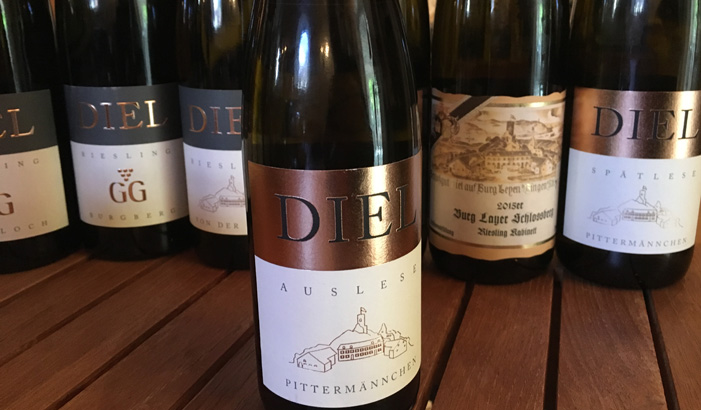
Caroline Diel is making some elite wines, and everything is so detailed and poised, and while never easy to find, there are some values in the lineup that merit note, especially the Terry Theise inspired Riesling Von Der Nahe Feinherb at about $24 is a great entry or gateway to the drier wines at Schlossgut Diel and the Dorsheimer Goldloch Kabinett with a touch more RS, but with succulent layers and immediate pleasures. But, of course, when you think of Diel you think of their top Trockens, the Goldloch GG in particular, and the Pittersmannchen GG, these Grosses Gewachs or Grand Crus really are the soul of Diel and rate as some of Germany’s greatest wines, and the 2015’s certainly are that. Trust me when I say, you cannot go wrong with all and all things Schlossgut Diel in the 2015 vintage! From Caroline’s glorious dry Rieslings to her Auslese sweeties, everything is beyond great, but don’t overlook the amazing Pittermannchen Spatlese if you want the best of both worlds, it’s a rich, layered and mineral driven beauty with near perfect balance, don’t let the sugar or must weight scare you, this is pure class with amazing cellar potential as well!

Caroline Diel the winemaker, is worldly and studied in her craft, her talent is on display in each and every wine at Schlossgut Diel, as well as her heart, the wines have her perfectionist focus and energy, this is especially true in her signature Pinot Noir, the “C” or her Cuvee Caroline, it is a gorgeous wine of elegance, graceful subtlety and is skillfully crafted with amazing attention to detail, some of her thoughts and methods might have come from when she did a spell at Romanee-Conti in Burgundy, even from a difficult vintage, such as 2014 was, the wine is truly captivating and seductive, it’s an awe inspiring effort that is worth every penny! Caroline Diel joins an elite group of Spatbugunder producers like Becker and Mayer-Nakel in making world beating Pinots from Germany, and I was able to see the magic happen here, as the Pinot Noir fruit was coming into the cellar, the 2016 is looking awesome, at least in the bins ready to be sorted the grapes looked fantastic, it will be good to take a mental note to get some in 4 years! Plus I can’t wait to see what she did with the 2015, which I sadly missed when visiting this time.
History Lessons and the Rise and Fall of Kabinett!
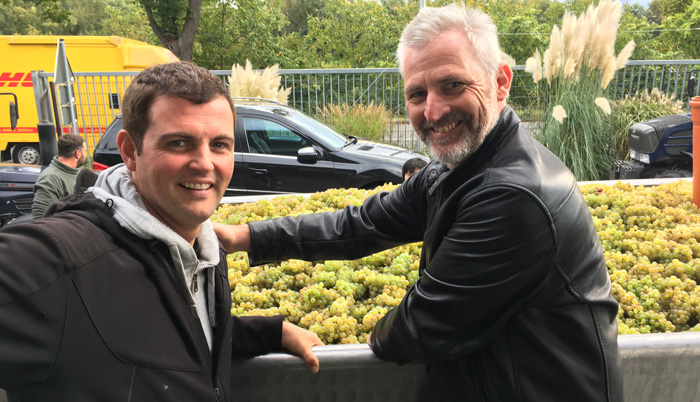
Kabinett was once the most prized wine of all, no I’m not kidding, and it still should be taken more seriously now, I am often mystified by peoples fear or dismissal of these lightly sweet Rieslings, and while I am an advocate for the dry or trocken wines the shear pleasure, flexibility and generous charm of Kabinett should not be forgotten. Kabinett Riesling with fresh crab is one of the best Food and wine pairings ever, but I like Kabinett with everything from smoked meats to tacos! The modern wine drinker needs to better understand these wines that offer so much for such a value price and find a place for them, they go with multi-ethnic and fusion cuisines, are refreshing and low in alcohol, perfect for summer and more complexity and charm than most other white wines in their class, plus if we are honest, and we are not, this fear of RS (read sugar levels) is pretty much bullshit anyway, most Chardonnay and modern Sauvignon Blancs from the new world most likely have as much sweetness or more than Kabinett level Rieslings! Really, and Riesling at least has less oaky/buttery character with bright zesty acids and true mineral tones. I’d rather have a Kabinett Riesling over a bland Pinot Grigio or oak chipped sickly cloying Chardonnay any day, but that’s just me it seems! This is a great time to re-discover Kabinett, especially these 2015 wines, which feel drier and have an array of complex flavors.
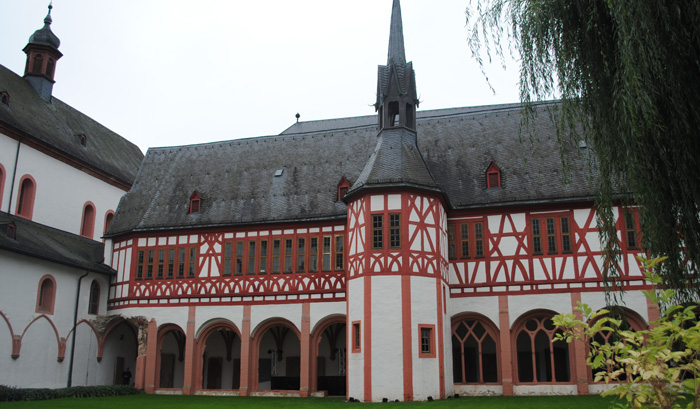
The monks at Kloster Eberbach had their own Kabinett cellar, it was where their most prized wines were kept, you can visit the old monastery today and see it, I was lucky enough to make my own pilgrimage this year with an excellent tour guide, Markus Roll of Weingut Leitz, this was a bit of Riesling lore I had not heard about or known. German wine law is strict and tricky, and it is in flux, so traditional Kabinett, Spatlese and Auslese are losing some of their prestige and appeal, as the wine industry tries to classify and regulate itself. The best and most useful English language explanation of German wine law and labelling is by Tim Gaiser, MS and can be reviewed on his blog at http://www.timgaiser.com/blog/understanding-german-wine, but for my purpose I’ll explain that Kabinett Riesling is classified by must weight or sugar in the grapes at harvest, the local term for this measuring is the Ochsle Scale, it is way of telling the amount of solids and sugar in the grapes compared similarly to the amount of water, and before your eyes glaze over, it is translated into a number, in the case of Kabinett that is 67-82 Oechsle (148–188 g/L sugar). What that means is that Kabinett level wines, yes do have sugar, but are usually high in acid and lighter in style giving them a delicately fruity taste. Interestingly Kabinett lost it’s prestigious place on top of the wine world, due to a fluke and a bishop with a sweet tooth! There is a statue at Schloss Johannisberg of a horseman, it is historic and cruel that Kabinett lost out, because of a lazy horseman, but it’s true that a couple hundred years ago, the monks sent a horseman to the Bishop to bless the approaching harvest so they could begin picking the grapes, well, the horseman come back as expected and the monks waited and waited as the grapes got riper and riper, it was thought maybe the horseman had spent his time with a lover, though eventually he did show up, but it was too late to make the traditional Kabinett style wine, hence the term Spatlese or late picked gaining favor, as when the Bishop tried this sweeter wine he hailed it as the best wine he’d ever tasted, much to the chagrin of the monks at Kloster Eberbach, though celebrated by sweeter wine producers, such as Schloss Johannisberg who still make celebrated Spatlese and honor the lazy horseman. I know I butchered Markus’ telling of the story, but I hope you can forgive me.
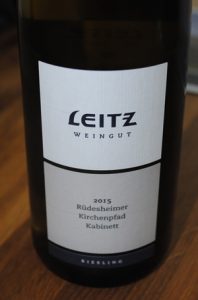
If you are curious about Kabinett Rieslings and want to try them, here are a few top producer recommendations for you: Selbach-Oster, Mosel, JJ Prum, Mosel, JJ Christoffel, Mosel, Willi Schafer, Mosel, Leitz, Rheingau, Spreitzer, Rheingau, Kruger-Rumpf, Nahe, Hexamer, Nahe, Schlossgut Diel, Nahe and especially Donnhoff, Nahe.
One of my favorites is the Leitz Rudesheimer Kirchenpfad Kabinett (pictured) this 2015 shines brightly with impressive detail and richness with lots of mineral and orchard fruits with plenty of brisk acidity to balance the sweetness.
My visit to Germany this October of 2016 was one of my career’s best and most eye opening wine travels, a much too short trip that with time and reflection has given me a wealth of new knowledge and respect for the terrors of the Rheingau, including the famed Rudesheimer, Assmannshausen and the upper Rheingau as well as part of the Nahe and a tiny piece of the Rheinhessen that touches Bingen. A grateful thanks to the wonderful and authentic people I saw and met on this trip, including my friends Johannes Leitz, Caroline Diel, Andreas Spreitzer, Stefan and Georg Rumpf as well as Markus Roll, Leitz’s vineyard and general manager that patiently toured me through almost every section of vines in the Rheingau and took me on a tour of Kloster Eberbach and taught me a brief history lesson of the region! This was my second visit to the Rhein, my first was in 2009, and I can promise you I’ll be going back repeatedly if life gives me that opportunity, it is one of the most beautiful and interesting places in the world, let alone the wine world, my few pictures here hardly due justice to this glorious place, I suggest you visit yourselves, after a five minute hike up the hill from Rudesheim was all it took to hook me in and make me a fan for life!
Spanish Treasures 20 Wines to Search Out
By Kerry Winslow
Spain has a major generational change going on, in every way this vibrant culture is pulsating with youth and is rethinking it’s future, this kind of change doesn’t come easy and especially with a huge economic depression hanging over the country, but that is what makes this movement even more impressive, even in these dark times, the wines of Spain have never been better and more interesting, there is a real sense of pride of place, experimentation and even a look back to ancient traditions. Spain has Europe’s largest area planted to vine, but is still I believe third in total production, this is because of much smaller yields and tonnage made into wine, behind France and Italy, these numbers have been getting closer in recent times, but the truth is and will be that Spain makes far less tons of grapes per acre than anywhere in the developed wine world, and this translates into more expressive and intense wines. Spain is also western Europe’s value leader, and by far, the wines of Spain even with the Euro at full value are the best priced quality wines in the world. This last year has seen an incredible array of wines being released, and this is just a beginning for a revolution of styles and new faces coming to the fore, this is an exciting time and a new era of Spanish Treasures!
Here are some of my top picks from the year to date, from classic areas like Rioja, Ribera del Duero and Sherry to Cangas and remote Basque regions, these are not to be missed wines! Ole Ole Ole!
The Wines
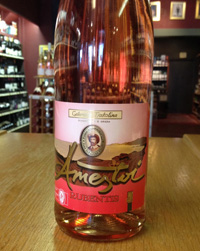 2013 Ameztoi, Getariako Txakolina, Rubentis, Basque Rose, Spain.
2013 Ameztoi, Getariako Txakolina, Rubentis, Basque Rose, Spain.
The zesty Ameztoi Rose is one of the best in Spain, found at almost every pinto bar and is one of the most celebrated seasonal wines of the Basque regions. Ignacio Ameztoi is the 7th generation of this grower/producer and is ensuring tradition and continuing the line of benchmark wines, he makes a white, a red and this lovely and lively rose from his estate near the Bay of Biscay in Northwest Spain. The latest release, the dry, brilliantly pink hued 2013 Ameztoi Getariako Txakolina Rubentis is bright, tangy and has almost a spritz with loads of energy, charm and delicate flavors showing pink citrus, watermelon, tart cherry, sea shore, wet stones, unripe plum and strawberry essence. There is mineral tones and zippy acidity making this wine wonderfully refreshing and crisp, it has that lip smacking zest and saltiness that begs you for another sip and is mouth wateringly good. This makes for a great start to an evening, great for picnics and of course it is great with brunch too, it is all around a fun and smile inducing wine that has everything you’d want from a summer wine being both serious and light hearted, playful yet thoughtful, this is pure joy, drink now and often! Plus try their Blanco Txakoli for a zippy lime infused white too!
($22 Est.) 90 Points, grapelive
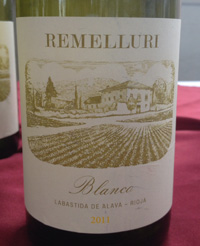 2011 Remelluri, Rioja Blanco, Labastida de Alava, Spain.
2011 Remelluri, Rioja Blanco, Labastida de Alava, Spain.
Since Telmo Rodriguez’s return to his family estate Remelluri, a new direction and drive have found their way into the wines, the latest set of Remelluri are some of the winery’s best to date, especially this amazing 2011 Blanco, it looks set to be a classic, and maybe one of the finest whites in Spain. Telmo always plays coy with his processes from winemaking to varietals, he stresses it is about place and history rather than type of grape or techniques, in our last two meetings now he neither confirms nor denies my guesses as to how and what goes in and on, but regardless this is a fantastic wine, it certainly possesses qualities that lead to comparisons to Meursault, Hermitage and Chateauneuf-du-Pape and wines from Roulot, Coche, Chapoutier, Chave and Beaucastel, and if you wanted to reference California maybe even the likes of Aubert, Peter Michael and Kongsgaard. The Remelluri Blanco 2011 is full and generous, but with refinement and purity, it starts with white flowers, citrus and wet stones leading to a deep palate of sublime texture with apple, peach, honeysuckle, clarified cream, clove, fig, a steely note and lemon curd. There are flashes of tangerine, chalk, butterscotch and apricot along with savory and saline elects, plus a bit of stone fruit pit and a lift of acidity to keep this rich wine in check. This wine is absolutely world class in every detail, I know it has a mix of about 9 varietals including Chardonnay, Roussanne and a few Spanish grapes and was fermented using natural yeasts, some of the wine used cement, some big cask and some stainless, it is a Remelluri original field blend, in fact Telmo tells me that it will be the model he will use on the estate red, going forward he will increase the number of red grapes in the vineyards, he believes it will allow a better canvas to create the best picture of place, I certainly will enjoy watching as the full image emerges, as for now, the Blanco is a masterpiece, near perfection, drink from 2014-2020.
($84 Est.) 97 Points, grapelive
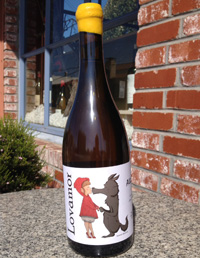 2012 Alfredo Maestro Tejero, Lovamor, Albillo Vino de la Tierra Blanco, Castilla Y Leon, White, Spain.
2012 Alfredo Maestro Tejero, Lovamor, Albillo Vino de la Tierra Blanco, Castilla Y Leon, White, Spain.
This rare old vine white from near Ribera del Duero is made from the scarce and native Albillo grape, this wine comes from 100-120 year old vines grown on clay-limestone at about 800m to 1100m in elevation in a wild and arid stretch of hills. Alfredo Maestro Tejero crafts this natural wine with great care and delicacy using 6 days of skin contact and is fermented and aged in small steel vats, nothing is ever added or are then any adjustments to this intriguing wine. With only around 400 bottles produced, this is exceptional rare juice and will be a hunt to find, a needle in the haystack, but certainly a rewarding endeavor. All of the Bodegas Maestro Tejero wines are worth checking out, these are some of the most innovative and seriously delicious offerings coming out of region. The 2012 Albillo, known as the Lovamor, starts with lime blossom, chalk and savory elements and is a golden yellow with an orange tint from the extended skin maceration and has a raw vigor that is very entertaining and unique. There is lemon/lime, tangerine and peach fruits, melon rind, a hint of tannin, herbs and spice along with a grainy stone essence. I’d really love this wine with savory tapas, smoked fish, cured meats and middle eastern lemon chicken. The 2011 was slightly more nutty and already mature, while the 2012 seems fresher and more lively finishing with lots of zest and tangy elements, both very cool, drink 2014 to 2018.
($34 Est.) 92 Points, grapelive
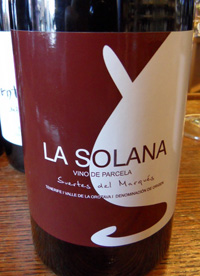 2010 Suertes del Marques, La Solana Vino de Parcela, Tenerife Valle de la Orotava DO, Canary Islands Red, Spain.
2010 Suertes del Marques, La Solana Vino de Parcela, Tenerife Valle de la Orotava DO, Canary Islands Red, Spain.
One of the most exotic and rare wines of the Canaries, the La Solana by Suertes del Marques is a masterpiece of the unique and a marvel of vigor and focus with fruit, spice, umami, mineral and textural pleasure. I adore these wines from the Canary Islands, especially the Suertes del Marques set of 7 Fuentes and this beautiful La Solana. The La Solana is racy and profound with a bouquet of dried flowers, porcini and pepper with mixed berry fruit that leads to a lively palate of spiced plum, raspberry, kirsch and currant with cayenne, grilled fennel and saline notes while warm stones, chalk and silky tannin mix in perfect harmony. This wild and natural wine is utterly seductive and has a wonderful sweet v savory tension that heightens the pleasure factor and leaves you begging for more. This is a thought provoking and beguiling red, made from the native Listan Nergo grape, that will challenge you and keep your attention for a long time.
($30 Est.) 94 Points, grapelive
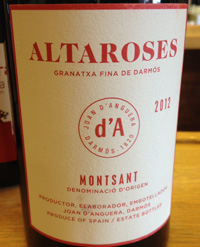 2012 Joan d’Anguera, Altaroses, Granatxa Fina de Darmos, Montsant D.O. Spain.
2012 Joan d’Anguera, Altaroses, Granatxa Fina de Darmos, Montsant D.O. Spain.
A few years back Joan d’Anguera converted to 100% biodynamic farming, changed the winemaking to bring out terroir and restraint and focused on the details in a truly artisan way, and it has paid off with huge rewards, the wines are charming, full of flavor and have a sense of place, these are wonderful wines that show Montsant perfectly in the glass. The Joan d’Anguera wines are some of the finest values in hand crafted Spanish wine, no question and they are just getting better and better, especially their lovely Altaroses Granatxa, a seriously delicious red from old vines. This adorable and stylish Grenache cuvee flows with silky grace across the palate with vivid layers of black and red fruits, spice, mineral and texture, this is pleasure filled experience from start to finish. The nose shows floral essences with hints of wild flowers, dried roses and lavender along with garrigue, minty sage, cracked pepper and raspberry leading to a full mouth of blackberry, plum, lush cherry and wild strawberry while in the background you find a mix of sweet and savory herbs and allspice, chalk, dusty earth, hints of game and licorice. The wine deepens in the glass, but remains lively and focused leaving a long fruit filled aftertaste, drink now and between 2014-2020, it is stupidly good right now, no need to wait.
($18 Est.) 92 Points, grapelive
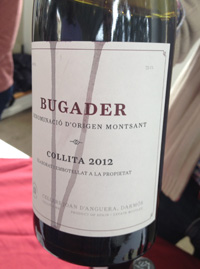 2012 Joan d’Anguera, Bugader, Montsant D.O. Spain.
2012 Joan d’Anguera, Bugader, Montsant D.O. Spain.
The latest set of wines from Joan d’Anguera in Darmos, the 2012’s, are really quite extraordinary and beautifully detailed, this is a big evolution from the past where things seemed almost a bit over the top, and the contrast between the prior vintages to 2012 is vast difference. Where before it was all about big, extracted and port-like the new wines show grace, life and harmony, I think almost everywhere this kind of re-think is going on, but is is at it’s most stark in Spain and in California, though it looks as if Australia might be doing some of same too, it is move to a more natural style, some people use the term balanced, and there is more of a focus on regional, historic and artisan winemaking, along with highlighting terroir, or place over grape or new oak. Not that this change is always perfect or welcome in some cases, and there has been some awkward wines, but not so here, Joan d’Anguera has nailed it, these wines especially the Altaroses 2012 and this magnificent El Bugader (100% Syrah) 2012 are stunning examples and are now all biodynamic as well. While the Grenache based Altaroses remains one of Spain’s great value wines at about $18, the El Bugader is some a bit more dear and it certainly is a special wine, full of delicate detail and exquisite quality, drinking like a fine Cote-Rotie. The 2012 Joan d’Anguera El Bugader Montsant shows perfume, a medium body and suburb length with violets, crushed roses, white pepper, wild herbs, blueberry, boysenberry and kirsch, along with subtle plum, a touch of mineral and gravel, almost flinty and faint traces of game and anise. This wine is pure, thought provoking and excellent, it should be available this fall of 2014, and will drink great over the coming decade, be sure to follow this winery and look for these fantastic 2012 vintage releases. (Pre release sample bottle tasted May, 2014 in SF, CA.)
($75 Est.) 94 Points, grapelive
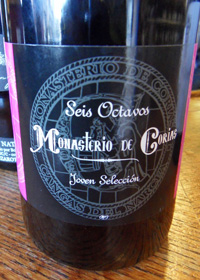 2011 Bodegas Monasterio de Corias, Seis Octavos Joven Seleccion, red Vino de Calidad de Cangas, Spain. (Albarín Negro & Carraquín)
2011 Bodegas Monasterio de Corias, Seis Octavos Joven Seleccion, red Vino de Calidad de Cangas, Spain. (Albarín Negro & Carraquín)
One of my new favorites, a beautiful medium weight red that has elements of character that remind me of St.-Joseph meets Nuits-St.-Georges with dark violets, earth and spices with a core of cherry and plum fruits. The floral and loamy nose leads the way to a vivid palate of the dark fruit, peppery spices, sweet herbs, anise and lavender plus a touch of mineral and stone. Everything is nicely framed by soft tannins and juicy acidity in this delicious red from Spain’s Northwest. This wine is made from vines grown inside the Monastery de Corais in Cangas where the exposure helps get the Albarin Negro and Carraquin red grapes ripe in this cool climate area. Only a tiny amount of this wine gets made and considering the conditions and rarity it is also a steal! This is lovely and unique wine that is done organic and as naturally as can be, and after tasting the last four vintages I highly recommend searching it out.
($18 Est.) 93 Points, grapelive
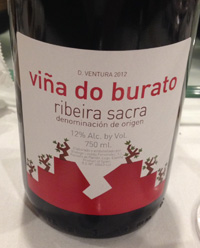 2012 Don Ventura, Ribeira Sacra DO, Vina do Burato, Spain.
2012 Don Ventura, Ribeira Sacra DO, Vina do Burato, Spain.
From the Ribeira Sacra “sacred slopes” this pure Mencia is a vibrant and impressive wine, crafted by the Losada family in the old zone of Amandi. For those looking for flavorful low alcohol reds, you should definitely check out Mencia from Ribeira, and wineries like Don Ventura and Domino de Bibei in the DO of Ribeira Sacra, where you find 12% alcohols and organic and biodynamic practices and still have deep and beautiful wines. Ramon Losada’s entry level Vina do Burato is a steal and shows Mencia in it’s purest form and is unadorned by flashy extras, it simply is lovely and easy to love with bright fruits, spice, hints of game, earth and has plenty of texture and style. The nose is slightly perfumed with traces of dark flowers, green spice and pepper notes like Loire Cab Franc, mineral and tangy currants leading to a medium weight palate of black cherry, plum, mixed berries and wild herbs, stones and dried porcini. The finish is crisp and fresh with youthful acidity and a lingering strawberry note, this is a very nice wine that shows the varietal and region in a solid performance, drink now through 2018.
($20 Est.) 92 Points, grapelive
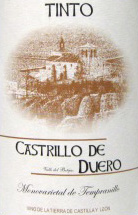 2011 Alfredo Maestro, Tinto Castrillo del Duero, Spain.
2011 Alfredo Maestro, Tinto Castrillo del Duero, Spain.
This is fast becoming one of my favorite Ribera del Duero wines, from the talented Alfredo Maestro, a producer than doesn’t label it thus, preferring to keep his independence. Alfredo Maestro wines mostly come from distinct single parcels or single crus (vineyards), he is capturing terroir and the vines sense of place in unique areas in central Spain from Madrid to Ribera del Duero. The latest release is the rich and darkly detailed 2011, a wine that is hard not to love with nose of morello cherry, dried flowers, raspberry liqueur and soft wood notes, leading to a lush palate of blackberry, cherry and loganberry fruit along with hints cranberry, baking spices, mineral and poached plum, all bright and slightly tangy, with a touch of black licorice before the finish, which turns creamy with warm toffee essence, giving a bit of sweetness. The lingering effect is impressive and seductive, Alfredo Maestro is an artisan winemaker that is ever challenging the boundaries and exploring new paths, be sure to taste his wonderful wines when you see them, especially this monovarietal Tempranillo, drink from 2014-2020.
($28 Est.) 93 Points, grapelive
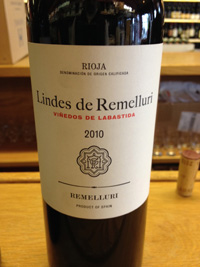 2010 Remelluri, Lindes de Remelluri, Rioja, Vinedos de Labastida, Spain.
2010 Remelluri, Lindes de Remelluri, Rioja, Vinedos de Labastida, Spain.
Telmo Rodriguez, one of Spain’s great winemakers, has turned around his family estate Remelluri in Rioja and he is making some of his finest wines of his prolific career, especially these secondary Remelluri offering from old vine purchased fruit, under the Lindes de Remelluri label. These two vineyard select wines, coming from vineyards that used to go into the Remelluri reserva are now separated into two new single vineyard bottling, and while both are excellent, it is the Labastida that really stands out for me, it comes from a mainly Tempranillo site in Rioja Alavesa where there is higher elevation and unique chalky soils, a very different terroir and character than La Rioja Alta, and it shows in it’s flavors. Telmo, having made wine at Jean-Louis Chave in Hermitage and in Bordeaux, has accomplished himself as a champion of place over varietal and employes artisan craftsmanship in the cellar, his wines hardly ever show oak or alcohol, they always show purity and a sense of place, these are magnificent expressions of Rioja, they are completely distinct and soulful wines that are seriously seductive and charming with style and substance in spades. The 2010 vintage Lindes de Remelluri is 90% Tempranillo and the rest a mix of Garnacha and Graciano, it is a field blend from extremely old vines that provide tiny yields of amazing complex and deep fruit, this 2010 Labastida is impressive, intense and tannic with a garnet/black hue along with a heady perfume and richly textured palate, this is dramatic stuff and will be long aging wine. The nose shows violets, dried flowers and sweet herbs with hints of cedar and blackberry leading to a firm and powerful palate of black cherry, damson plum, blueberry and mixed red and black berry fruits with loam and mineral that remind me of left bank Bordeaux, spice and hints of wild strawberry. There is a tangy currant running throughout and lingering liqueur cassis feel in the same vein, and some lavender, licorice and earthiness rounding out the complexity in this dense and layered Rioja. This is captivating and fantastic wine, this is not to be missed and certainly is another feather in Telmo’s cap, drink this gorgeous beauty over the next two decades, no question a great cellar candidate, this is an affordable collectors item, best from 2018 to 2035.
($30-35 Est.) 94 Points, grapelive
 2009 Remelluri, Rioja, Reserva, Spain.
2009 Remelluri, Rioja, Reserva, Spain.
Telmo Rodriguez returned to his family estate in 2010, but had plenty of time in the cellar to separate lots and refine the blend in this sublime Rioja that for the first time in modern history was all estate grown, with the purchased old vine fruit going into the Lindes de Remelluri bottling. Telmo has great plans for this glorious estate wine, and his estate white, the Remelluri Blanco is already seeing his vision come into focus, he plans to model the red along the same lines, he will add more varietals each year until he has up to 9 or 10 different grapes to the classic mix of Tempranillo, Garnacha and Graciano, his idea is craft a unique field blend that is proprietary to Remelluri a more complex and exotic wine. I can see why, as his Blanco proves he’s on to something special here, the terroir is ideal for this too with slopes and high elevation Remelluri has it’s own sense of place, quite different to other properties in Rioja, Remelluri is literally on the edge with a mix of soils and it’s own micro-climate in Rioja Alavesa. 2009 was a warm and generous vintage, and the Remelluri is full of richness and texture with ripe tannins and wonderful length, Telmo’s masterful touch in blending gave this wine a graceful almost Burgundy like feel, it is rich without being heavy, no mean feat in this vintage. Pretty red fruits, earth, spice and subtle wood notes all play important roles here with raspberry, cherry and dark plum. There is texture and layers here, with hints of game, exotic spice, truffles, anise, cedar and warm stones, this is an interesting wine and it sets the senses alight, drink now and through 2019. Be sure to keep an eye out for future releases of Remelluri, and don’t miss the Blanco, the 2011 is stunning!
($45 Est.) 93+ Points, grapelive
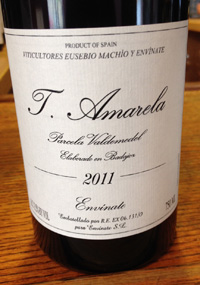 2011 Envinate, T. Amarela, Parcela Valdemedel Elaborado en Badajox, Extremadura, Spain.
2011 Envinate, T. Amarela, Parcela Valdemedel Elaborado en Badajox, Extremadura, Spain.
The grape Tinta Amarela is one of the Port grapes and is widely planted in the southern part of Portugal, though it is rarely found in Spain itself, it makes for a rich and complex wine. This wine comes from Badajox in Extremadura Spain, a south-western part of the country, land locked and bordered by Portugal to the west, so it is not terribly surprising to find this grape here, though I can tell you it is very uncommon to find it as a single varietal wine and especially as a Spanish one, this was my first experience tasting it and research proved much more difficult, but I did learn of the grapes heritage and use in some Port wines and that it is a fickle vine that easily rots, so great care must be used to get successful results and that Tinta Amarela, also known as Trincadeira, does well in these dry warm regions, making a wine of deep color and complexity. The Envinate range of wines is interesting, the winery is a brainchild of four friends that met in viniculture school in Alicante, who all make wine in different regions from Northern Spain to the Canary Islands, they are lead by Laura Ramos and include Jose Martinez, Alfonso Torrente and Tenerife native Roberto Santana who’s Canary Island wines at Suertes del Marqués are really turning some heads, and of which I’m a huge fan of personally. The Envinate (meaning “Do Wine Yourself”) wines are very limited to say the least, and this T. Amarela is a beautiful red wine with deep color and flavors done in a wonderfully elegant and very artisanal in style, showing unique terroir driven flavors and lovely transparency. The 2011 Envinate T. Amarela starts with dried roses and wild flowers, juicy plum, sweet mountain herbs, red berries and currants leading to a medium full palate of blackberry, red peach, tangy cherry and star anise along with warm stones, hosin and dusty earth. There is hints of leather, red spice and the texture is caressing helping to lengthen the finish which lingers with blue and black fruits. I must say I’m very intrigued and impressed, I would enjoy tasting all of their offerings and recommend finding their exotic wines, like this very compelling rarity, drink now and for the next 3 to 5 years.
($45 Est.) 92 Points, grapelive
Sherry
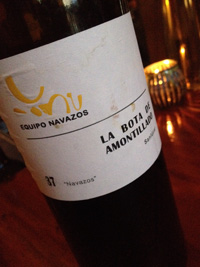 n.v. Equipo Navazos, Sherry, La Bota de Amontillado no. 37, Hijos de Rainera Pérez Marín “Navazos” Sanlucar de Barrameda, Jerez-Xérès DO, Spain.
n.v. Equipo Navazos, Sherry, La Bota de Amontillado no. 37, Hijos de Rainera Pérez Marín “Navazos” Sanlucar de Barrameda, Jerez-Xérès DO, Spain.
This unbelievable Sherry is drop dead gorgeous and complex, only 3,000 bottles of this rare Amontillado were made from unique casks, this No. 37 is drawn lots of Hijos de Rainera Pérez Marín, hand selected by Equipo Navazos which is fast becoming the exciting Sherry shipper in the world and is putting the passion into these stylish expressions. The La Bota de Amontillado P. Marin 37 Navazos is a rare solera that has selected and refreshed with pure Manzanilla (unfortified) to add dynamic character and verve, which also heightens the aromatics and gives life to this deeply flavored and complex Sherry, without question this is one of the most interesting and pleasing Sherry wines I’ve tasted. The nose is tangy/nutty, briny and vibrant with citrus, pear, sea breeze and has green almond notes leading to a vivid palate of lemon, peach and tangerine with pecan oil, wild herbs, unsweetened salted caramel/toffee and burnt orange rind. This fine dry and dusty Amontillado gains richness with air, but is wonderfully fresh and crisp, and it is not overly oxidized, leaving a lip smacking sensation and is hauntingly long and lingering. Wow, wow and more wow, if you want to taste what great dry Sherry is all about, find this one, this is fantastic, a big thank you to Duende Tapas Bar in Oakland for pouring this one by the glass, bravo! Ole, Ole, Ole!
($60-70 Est. 750ml, 18.5% alc.) 95 Points, grapelive
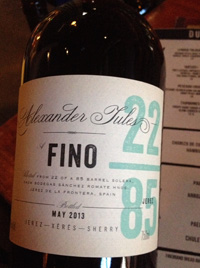 n.v. Alexander Jules, Fino Sherry “22|85” Bottled May 2013, Bodegas Sanchez Romate, Jerez de la Frontera, Jerez-Xeres-Sherry, Spain.
n.v. Alexander Jules, Fino Sherry “22|85” Bottled May 2013, Bodegas Sanchez Romate, Jerez de la Frontera, Jerez-Xeres-Sherry, Spain.
Alex (Jules) Russan is a Sherry fiend and absolute believer in all things Sherry, so created his own label and hand picks casks to bottle, each of his offerings is a limited, rare barrel select that makes up a one time release. He sources many small and big Bodeags to find that unique profile and intriguing character, and I really admire what he’s done with his Alexander Jules lineup and his focus on dry styles, that he hopes people with take to the table with meals, and I adore this wonderful and vibrant Fino “22|85” that I just recently sampled at Duende Tapas Bar in Oakland, California. The “22|85” Fino is a select Sherry that would have been known in the past as a Fino Amontillado, it was hand picked from 22 of the 85 Celestino Solera barrels at Sanchez Romate Hnos. in Sherry’s Jerez de la Frontera, is is from the oldest lots of Fino, an average age of 8 years, this adds weight, complexity and mature details, while remaining dynamic and fresh from start to finish. The May 2013 bottling is current and only 1,100 Bottles were made, only in 750ml and interestingly it is only offered in the USA, and it comes in at 15% Alc. If you are looking for a richer style, you should also check out the fantastic Amontillado from Alexander Jules, it is also sublime. This vivid Fino starts with hints of white flowers, iodine, brine and pecan butter and dives into a fresh, tangy palate that shows citrus, peach, dried apricot, tangerine rind, cheesy notes, wild herbs, baking spice and bitter almonds along with a faint trace of mineral and zesty acidity with a lingering nuttiness, this is crisp and lovely Sherry that needs food, delivering precise focus and is pleasingly well rounded, bravo.
($32-40 Est. 750ml) 92 Points, grapelive
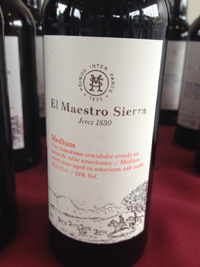 n.v. El Maestro Sierra, Medium Amoroso, Semi-Sweet Sherry, Jerez, Spain.
n.v. El Maestro Sierra, Medium Amoroso, Semi-Sweet Sherry, Jerez, Spain.
The famed El Maestro Sierra bodega was founded in the early 1800’s by a master woodworker named Jose Antonio Sierra and quickly became one of the regions most treasured Sherry houses and even today some of those early glories remain, it still has many old and rare stocks, making it the destination for visits to Jerez, and one of the most sought after wineries in the world. I was lucky to taste through an amazing array of fine Sherry and El Maestro Sierra is on another level with some of the oldest Sherry wines available and many gorgeous offering throughout their latest offerings, including a majestic Palo Cortado, a deftly crafted dry Fino and sweet and balanced Pedro Ximenez, but I think my favorite was this spectacular Medium Vino Amoroso. The El Maestro Sierra version of “Cream” Sherry is a world class semi-sweet dark Sherry aged in American oak cask and gets additional years of age in a solera, it is made from a base of 15 year Oloroso (Palomino) about 90% and 15 year Pedro Ximenez 10% (this is where the rich sweetness comes from) and trust me this is not Harvey’s Bristol Cream, this is magnificent and decedent fortified wine that has almost tawny port elements but not as sweet. The Amoroso is filled with Walnut, pecan and oily almond layers along with maple, honey and toffee notes with a core of dried peach, orange rind and tropical fruit. This is rich, mouth filling and long on the finish it is marvelous with smoked ham, cheeses, nuts and can be sipped on it’s own, this is a stunner and a great entry into the world of Sherry.
($18 Est. 375-Half Bottle) 94 Points, grapelive
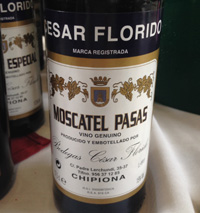 n.v. Bodegas Cesar Florido, Moscatel Pasas, Sweet Sherry, Chipiona, Jerez DO, Spain.
n.v. Bodegas Cesar Florido, Moscatel Pasas, Sweet Sherry, Chipiona, Jerez DO, Spain.
This Bodega was originally founded in 1887 and is still in family hands today, run by Cesar Florido in the Jerez sub-zone of Chipiona, an area of sandy soils that is home to mostly Moscatel vines very near the ocean. While they also make some fine dry sherry, it is their semi and sweet styles that really grab the limelight and the Moscatel Pasas is center stage, this is glorious sweet sherry that is unique and gorgeous with delicate and seductive perfume, medium sweetness and with a salty/savory nutty element adding balance and complexity. the nose stators with jasmine, dried yellow roses, verbena and honeysuckle before giving way to candied pineapple, dried apricots, orange rind, caramelized apple and poached spicy pear along with pecan and hazelnuts, plus briny sea breeze and toffee. What is remarkable in the whole and the fact that it is not cloying with life and tanginess making for a complete and detailed wine (Sherry) which can be enjoyed with many foods and not solely for desserts, it certainly would be wonderful with cheese as well. This is a very excellent example of a somewhat rare style and of this varietal from a region that deserves much grander attention, do not be afraid to explore the world of Sherry it is a wonderful adventure.
($14 Est. 375ML-Half Bottle) 93 Points, grapelive
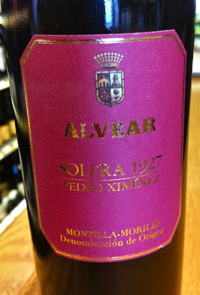 nv Alvear, Pedro Ximenez Solera 1927, Montilla-Moriles DO, Spain (sweet sherry style wine) 375ml Half Bottle.
nv Alvear, Pedro Ximenez Solera 1927, Montilla-Moriles DO, Spain (sweet sherry style wine) 375ml Half Bottle.
Alvear, a sherry style producer just outside the “Sherry Zone” in Montilla-Moriles is one of the oldest wineries in Spain and specializes in fine crafted wines, mostly Pedro Ximenez (grape) with a wealth of great offerings from Fino dry to PX sweet, of which all are excellent, especially the stickies like this fantastic Solera 1927. Alvear only taps the 1927 cask twice a year to make this selection of sweet solera, and it’s age and grace shows through with creamy richness and complexity of flavors. This wine is a rare treat, and one of the best deals in the wine world, no question, I am always amazed by this beauty, and even more amazed people still fear sherry in general, it makes me turn evangelical for these too often overlooked gems! The latest edition of Alvear Pedro Ximenez Solera 1927 shows the deep dusty coco powder and dark amber hue and the nose leads with chopped walnuts, candied orange rind, honey and dried figs with a creamy lush palate of toffee, honeyed pecans, almond paste, bitter chocolate and golden raisins with a touch of dried stone fruit and a hints of citrus. This pleasure filled PX must be tried on it’s own, but of course for added hedonistic joy enjoy this over organic vanilla bean ice cream, this is naughty sexy stuff that can replace Tawny Port on your after dinner menu and goes great with a variety of desserts.
($25 Est.) 94 Points, grapelive
Vermouth
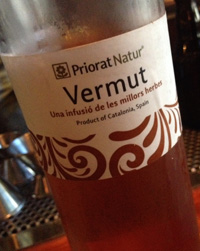 n.v. Priorat Natur, Vermut, Priorat, Catalonia. (Spanish Vermouth)
n.v. Priorat Natur, Vermut, Priorat, Catalonia. (Spanish Vermouth)
I don’t write about wine based Cocktails or Aperitifs very often and almost never mention Vermouth, but I couldn’t pass on the chance to comment on this sexy and compelling Priorat Natur, all organic Vermouth from Catalonia made with native herbs and aromatics infused into a wine base using a combination of Macabeo, Pedro Ximénez and Grenache Blanc grapes that are fermented on the skins and then aged at least two years. Xavier Buil and his wife Anna Cuadrat hand craft this delicate and intriguing Vermouth using natural and ancient methods with hundreds of local botanicals and a touch of sugar in this amber hued elixir, they add young Vermut to a barrel of old Vermut to create the richly flavored complexity, much like a solera you’d find in Jerez. Recently I’ve had the chance to examine many Vermouths from Spain and these are superb Aperitif, and with the Negroni craze out of control these days, you can find some amazing offerings using these distinct Spanish Vermouths, plus you can do some very racy Manhattans and other stylish cocktails with them, though I prefer to enjoy them sans booze, just chilled, especially this Priorat Natur Vermut, this is gloriously refined and joyous on it’s own. I was sipping this wonderful Vermouth with Tapas the other evening after it was recommended at the bar (Duende Tapas in Oakland, Calif.) and it went down beautifully, it is truly an artisan product with not too much sweetness, it shows bright dried fruits, tangy herbs and perfumed florals that all add up to a light and restrained example with citrus, clove, thai basil, a hint of wild honey, fig and almond.
($22-30 Est.) 91 Points, grapelive
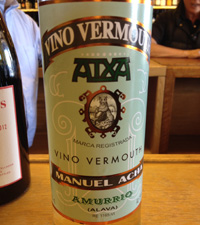 n.v. Destillerias Manuel Acha 1831, Basque Vino Vermouth Blanco, Amurrio (Alava)Spain.
n.v. Destillerias Manuel Acha 1831, Basque Vino Vermouth Blanco, Amurrio (Alava)Spain.
Wow, this is dusty dry and crisp vino Blanco Vermouth that begs to be in your ultimate Martini, and or as a fine sipping aperitif, this is great stuff made from all natural ingredients and using ultra traditional methods. The Manuel Acha family distillers in the Basque region of Amurrio makes a fine artisan Vermouth and is now run by the talented Gabriel Acha, continuing the long line of Acha’s to craft unique Basque Vino Vermouth. The Blanco is savvy and brisk with loads of citrus oil, tangy white peach and lime with crushed jamming, orange blossom and bitter herbs. On the rocks or straight up with a lemon twist this makes for a great palate awakener and again, if you want a stylish and racy Martini, this is your stuff, no question, I was left very impressed by both the white dry and the semi sweet and delicate red by Acha, I would for sure make these my bar staples. The Acha (Atxa) Vermouth is complex and layered, and stunningly good, even for someone like me that rarely indulges in mixed drinks or cocktails, I’m going to make sure I have both these around, this is quality stuff, exotic and charming, especially this dry Blanco, bravo!
($20 Est. 750ml) 93 Points, grapelive
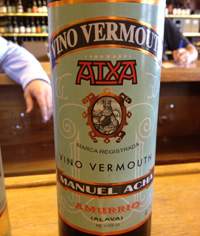 n.v. Destillerias Manuel Acha 1831, Basque Vino Vermouth Rojo, Amurrio (Alava) Spain.
n.v. Destillerias Manuel Acha 1831, Basque Vino Vermouth Rojo, Amurrio (Alava) Spain.
Acha’s, or Atxa in Basque, sweet red Vermouth is super tasty and maybe one of the world’s great Manhattan ingredients and makes for a super Negroni too, but frankly this stuff is so delicious you can serve straight chilled, and I secretly think a great sangria would enhanced using a touch of this wonderful stuff. Gabriel is a long line of Achas that have been making artisan Vermouth since 1831, he crafts all natural Basque vino Vermouth using local organic grapes and herbs. The pay of bitter and sweetness is near perfect and very exciting, much less cloying than the Italian offerings with little of the overwhelming vanilla, this is more delicate and subtle with complexity and flair, very Basque indeed. This aperitif makes for great sipping and even better cocktails with floral extracts, lavender, fennel, sweet sugar beet and classic red berry wine character along with liqueur dipped plum and candied citrus rind. Richly detailed on the palate and easy to love, if you are looking for excitement in your Vermouth and want something truly unique and special you really need to find this great product made myth passion and tradition.
($20 Est. 750ml) 92-94 Points, grapelive
Stay tuned, there are hundreds of great new Spanish wines coming!
May 2014
Three Old World Reds That You Should Look For
By Kerry Winslow
These three wines, one each from France, Spain and Italy are wonderful examples of richly flavored wines from the old world, each unique and remarkably pleasing and under $50 on the shelf, if you are looking for good value and class, these stylish wines are certainly worth exploring, they all drink great now and would be nice mid term cellar wines as well!
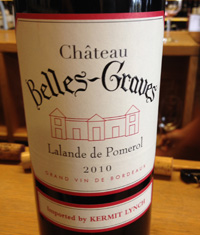 2010 Château Belles-Graves, Lalande de Pomerol, Red Bordeaux, France.
2010 Château Belles-Graves, Lalande de Pomerol, Red Bordeaux, France.
Belles-Graves dates back to the 16th century, this pre French Revolution has changed hands a few times in it’s lifetime, but now remains in the heirs of Hermine Theallet since 1938 with Xavier Piton, a relative of the famed under sea explorer Jacques Cousteau, in charge today. This secluded and idyllic Chateau is surrounded by mostly Merlot vines, though there is a good plot of Cabernet Franc that adds complexity to this classic Lalande de Pomerol with the Grand Vin made up of 88% Merlot and 12% Cabernet Franc. With a great vintage, like 2010, it is hard to wrong and certainly Chateau Belles-Graves got it right, making a stylish and full bodied Claret that is not only lush and delicious now, it can age gracefully for another 5 to 10 years easy. The nose is full of acacia and dark floral tones along with creme de cassis and with a hint of mineral/pencil lead, leading to a plush mouth filling palate of blackberry coulis, red currants, cherry and framboise plus hints of vanilla, graphite, char, briar and cedar. Good drive and polished tannins keep the vigor in this Bordeaux along with a lift of gentle acidity and the long fruit filled aftertaste. This is one of jewels in Kermit Lynch’s Bordeaux portfolio, if you are looking for a super drinking Bordeaux and don’t want to break the bank this would be an excellent choice!
($35 Est.) 93 Points, grapelive
 2009 Remelluri, Rioja, Reserva, Spain.
2009 Remelluri, Rioja, Reserva, Spain.
Telmo Rodriguez returned to his family estate in 2010, but had plenty of time in the cellar to separate lots and refine the blend in this sublime Rioja that for the first time in modern history was all estate grown, with the purchased old vine fruit going into the Lindes de Remelluri bottling. Telmo has great plans for this glorious estate wine, and his estate white, the Remelluri Blanco is already seeing his vision come into focus, he plans to model the red along the same lines, he will add more varietals each year until he has up to 9 or 10 different grapes to the classic mix of Tempranillo, Garnacha and Graciano, his idea is craft a unique field blend that is proprietary to Remelluri a more complex and exotic wine. I can see why, as his Blanco proves he’s on to something special here, the terroir is ideal for this too with slopes and high elevation Remelluri has it’s own sense of place, quite different to other properties in Rioja, Remelluri is literally on the edge with a mix of soils and it’s own micro-climate in Rioja Alavesa. 2009 was a warm and generous vintage, and the Remelluri is full of richness and texture with ripe tannins and wonderful length, Telmo’s masterful touch in blending gave this wine a graceful almost Burgundy like feel, it is rich without being heavy, no mean feat in this vintage. Pretty red fruits, earth, spice and subtle wood notes all play important roles here with raspberry, cherry and dark plum. There is texture and layers here, with hints of game, exotic spice, truffles, anise, cedar and warm stones, this is an interesting wine and it sets the senses alight, drink now and through 2019. Be sure to keep an eye out for future releases of Remelluri, and don’t miss the Blanco, the 2011 is stunning!
($45 Est.) 93+ Points, grapelive
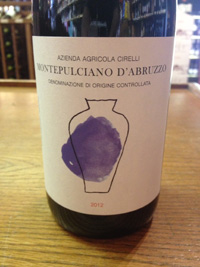 2012 Agricola Cirelli La Collina Biologica, Montepulciano d’ Abruzzo DOC, Italy.
2012 Agricola Cirelli La Collina Biologica, Montepulciano d’ Abruzzo DOC, Italy.
Francesco Cirelli has an organic farm in this hills of the Astri Abruzzi zone, his estate produces a fine selection of organic products from olive oil to ice cream, but it is his wine that are really grabbing the headlines, with red (Montepulciano), white (Trebbiano) and rose (Cerasuolo) on offer. These sandy and chalky hillsides, sandwiched by the Adriatic and beautiful National Parks are the perfect home for the native Montepulciano, a very dark skinned varietal (believed to be a long lost family member of Sangovese, though now considered very much it’s own grape) that is rich in color and can be age-worthy. Cirelli’s latest offering is a special Amphora raised version of Montepulciano d’ Abruzzo that has almost nine months on the skins, this adds up to a exotic example and a very unique expression of this varietal and terroir, making for a rich and flavorful red. The nose is grapey and there is some spice, crushed flowers and loads of mineral essence leading to a grippy palate of wild plum, blackberry, cherry and dark currants along with anise, touches of earth, blueberry skin and saline/savory notes. This purple/ruby hued red is very intriguing and compelling with a rich character, but with brightness and fine grained tannins, it finishes with class and pleasing length, drink from 2014 to 2016.
($40 Est.) 93 Points, grapelive
Avail at www.sfwtc.com
March 2014
Catching up with the Santa Lucia Highlands
By Kerry Winslow
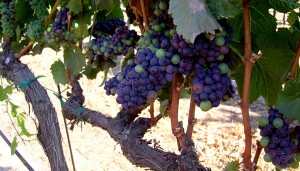
The Santa Lucia Highlands, Monterey’s most acclaimed wine area, sits on a bench land above the Salinas River, it is a cool climate region affected by cool breezes and fog sucked down the valley from Monterey Bay. Monterey’s deep cold water canyon makes for consistent weather patterns and a long growing season in the Santa Lucia Highlands, which is ideal for Pinot Noir and Chardonnay, though an argument for Syrah continues to brew here and it’s promising results since 2004 almost eclipse the epic results for Pinot Noir. The Santa Lucia Highlands leading lights remain the Pisoni and Franscioni families vineyards, these includes the famous Pisoni Vineyard, Garys’ Vineyard, Rosella’s Vineyard and their newer sites Soberanes and Sierra Mar Vineyards, all of which surely could be considered Cru vineyards if not Grand Cru, as Robert Parker called Pisoni and Garys’ a few years back in his reviews in The Wine advocate. Being from just over the hills in Carmel Valley, I certainly view the Highlands as my home team and having worked there and being involved in many insider events there I feel I have the experience to give a little insight into the currant and up coming releases from this remarkable region. At a recent trade tasting for the Santa Lucia Highlands I caught up with many friends and producers and had a chance to further my own knowledge and sample the latest set of wines.

What follows is a quick look at some terrific wines that I highly recommend and that are setting the standard for the SLH region, as per normal the Pinot Noirs lead the way, though as mentioned, Syrah is vastly underrated here and maybe the best value of the red wines. On a sobering note, I was very disappointed with the Chardonnay releases on the whole, what is going on? I will say both Roar and Lucia (Pisoni) put out suburb Chards in 2012, but most of the 20 or so from well regarded producers underwhelmed and in some cases were downright awful, there seemed to be a veggie theme or an over sweet style that repeated way to often, it was an eye opener no question. The whites as whole just didn’t excite and were way off quality wise from where I would have expected, though there was some exceptions including a few Pinot Gris wines and Rhone whites, but maybe the best of the whites was the Nacina Riesling by Tudor, this was maybe the biggest surprise, even though there has over the decades been some nice plots of Riesling found in the Santa Lucia Highlands. In summary, Pinot Noir is your go to Santa Lucia Highlands wine, but be sure to check out the Syrah, and be very selective on the Chardonnay in 2012, I hope it was just an abnormal blip and we’ll see Chardonnay again show it’s true potential again in the 2013 vintage. The Santa Lucia Highlands is remote and mysterious and sadly not all that accessible to wine enthusiasts to explore or tour, but it remains one of California’s best appellations and is close attractions like the wondrous Monterey Bay, the quaint and sleepy Carmel-by-the Sea, and the beautifully rugged Big Sur coastline, which is not too bad at all.
The latest SLH wines
Pinot Noir
The region’s star varietal and the wine that put the area on the world stage, Pinot Noir makes a richly flavored and generous style with a dark hue and density, these are full force Pinots. While they may lack the delicacy of the Sonoma Coast, these wines offer layers of fruit and still have good acidity with the best giving hedonistic pleasure and length. In recent vintages there has been a toning down of ripeness and use of new wood, but still leaving the soul of the place intact. There are a number of promising wines emerging, but I am not thrilled by the arrogant pricing, I am shocked that unheard of labels are asking over $60 for a non single vineyard Santa Lucia Highlands Pinot, and while some of these wines are interesting and well made, they don’t deserve mentioning here. Here are the wines that have star quality and or a great track record, again the Pisoni family look to be the leaders in region, though the other wines list here are wonderful examples. Others of note, Siduri continues to make some of the best SLH wines, with fruit coming from all of the Pisoni farmed sites, Adam Lee was one of the first to showcase the regions Pinot, then there is Kosta Browne and new comers Black Kite making some serious stuff.
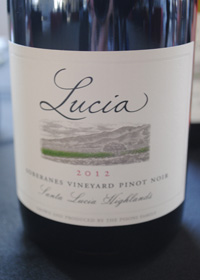 2012 Lucia, Pinot Noir, Soberanes Vineyard, Santa Lucia Highlands.
2012 Lucia, Pinot Noir, Soberanes Vineyard, Santa Lucia Highlands.
The newest vineyard in the Cru class is the Santa Lucia Highlands is the Pisoni family’s Soberanes Vineyard, this site has massive potential and could even eclipse the more established sites, this is going to be exciting to follow over the next few years. The latest wines from Jeff Pisoni, the Pinot Noir, Chardonnay and Syrah all look impressive, the 2012 vintage is set to match 2007 or 2009 in quality. The Soberanes is planted to the best clones and has all the history and excellence learned and proven over the last two decades, again this is a special place and the vines are already giving a peek into their future here with a great set of wines, even from these young vines, especially this Pisoni Clone Pinot Noir from Lucia. The 2012 shows more depth, density and finesse than the prior wines from this site, I think the proof is in the pudding, the Soberanes Pinot is beautiful and wonderfully detailed, refined and lush. The nose has classic Santa Lucia Highlands dark fruits, briar and floral array, leading to a palate of well defined cherry, plum and blackberry fruits with hints of mineral, gravelly stones, wild herbs, cinnamon, vanilla and a touch of smoky wood. This is really good and lavish Pinot Noir with smooth texture, a touch of vibrant acidity and underlying spiciness, there is also a hint of saline, licorice and lingering strawberry, drink over the next 4 to 6 years.
($53 Est.) 93+ Points, grapelive
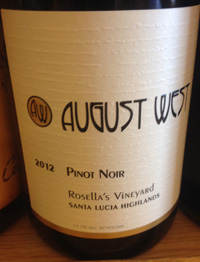 2012 August West, Pinot Noir, Rosella’s Vineyard, Santa Lucia Highlands.
2012 August West, Pinot Noir, Rosella’s Vineyard, Santa Lucia Highlands.
Ed Kurtzman’s latest August West Rosella’s follows in his tradition of fruit forward, unfiltered wines and reminds of his brilliant efforts in the past with Roar, and since he is no longer making Roar, this label is getting more quality attention. His 2011 scored 92 in Parker’s Wine Advocate and certainly this vintage is considerably better in all areas with rich density and deeper complexity. This is pure Rosella’s with dark fruits, spice, mineral and lush texture showing this Cru vineyard in it’s best light with black cherry, plum and mountain berry fruits, hints of savory herbs, game and sweet smoky wood. This vintage of Rosella’s is full and polished with good grip, silky ripe tannins and juicy freshness, this is a delicious effort.
($45 Est.) 93 Points, grapelive
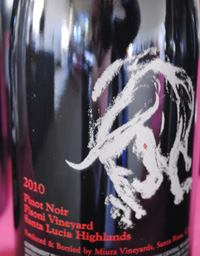 2010 Miura, Pinot Noir, Pisoni Vineyard, Santa Lucia Highlands.
2010 Miura, Pinot Noir, Pisoni Vineyard, Santa Lucia Highlands.
Miura’s Emmanuel Kemiji was one of the first high profile Master Sommelier to turn vintner, now you have your Rajat Parr MS at Sandhi and Evening Land and Sarah Floyd MS with Luli, and a few others. Kemiji’s wines have always a great mix of talent and terroir, especially his Miura Pisoni and Garys’ Pinots, but he also makes a sublime set of Spanish wines and I have always loved his Syrah wines that are made under his Antiqv2s label, these also have fruit sourced from Pisoni and Garys’ Vineyards. Emmanuel Kemiji’s membership to the Court of Master Sommeliers has made him shy on wanting full flavored and rich wines, all the wines he produces are lavish and showy wines, but they are certainly balanced and in my own experience age well, I recently uncovered a few Miura and Antiqv2s wines from 2001 and 2002 in my cellar and found them extremely beautiful and vibrantly fresh. I’ve been lucky to have had Miura, and Kemiji’s other wines since he first started, and he has always had the talents of Byron Kosuge as his consulting winemaker, this consistency and the access to great fruit has always been a major plus, these are wonderful wines. Emmanuel and Siduri’s Adam Lee where two of the first clients of the famed Pisoni Vineyard and were among an elite set of vintners to get these grapes, they also helped convince Gary Pisoni to make his own wines. The Miura 2010 Pinots are both terrific and classic wines from these two Cru sites in the Santa Lucia Highlands, the Pisoni might have the edge early, but the Garys’ is also a stunner. The Miura Pisoni starts with a heady nose of fruit, flowers, earth and mineral with violets, cassis and bramble leading to a glorious palate of blackberry, plum, raspberry and a dense core of black cherry fruit along with smoky oak notes, briar, cinnamon stick, wild herbs, anise and loamy truffle notes. This wine is deep and packed with layers of detail and flavor, still vivid, tight and lively with vitality and vigor, good acidity, silky tannins and a long hedonistic finish all make for a perfectly delicious Pinot Noir of class and distinction, in a pure Pisoni charmer, flamboyant, but without question a gorgeous wine. Drink this rewarding Pinot over the next decade, best from 2016 to 2022.
($63 Est.) 94 Points, grapelive
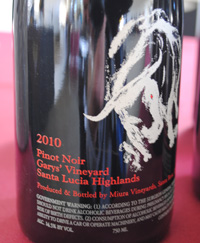 2010 Miura, Pinot Noir, Garys’ Vineyard, Santa Lucia Highlands.
2010 Miura, Pinot Noir, Garys’ Vineyard, Santa Lucia Highlands.
The 2010 Miura Garys’ is more restrained, intense and brooding than the flamboyant Pisoni at this stage, but I wouldn’t bet against this one from turning the tables on it’s bother in a few years, everything is there to blossom and develop into a stunner itself. The more generous Pisoni might have it’s day now, but there is a lot to love here too, this Miura Garys’ Pinot shows darker fruit, more acidity and a slightly less ripeness, though it does open up in the glass and fills out magnificently on the palate with rich fruit and clear detail, while the nose is shy it still has plenty to offer as well with hints of rose petal, violets and tea spices along with toasty oak and mocha. The raspberry, cherry and plum fruits are lifted by acidity and silky tannins, though there is a lush and dense mouth feel that shines through and this is rich wine from start to finish. Background notes of wild strawberry, licorice, forest mushrooms and a hint of game add complexity, give another couple of years to unfold for the best rewards, I’m sure this will continue to improve and intrigue over the next 3 to 5 years, and clearly this Pinot Noir has seductive charms not to be missed now and in the future.
($63 Est.) 93+ Points, grapelive
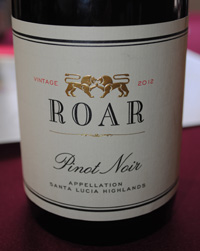 2012 Roar, Pinot Noir, Santa Lucia Highlands.
2012 Roar, Pinot Noir, Santa Lucia Highlands.
From select blocks of Rosella’s, Garys’ and Sierra Mar comes the pretty and easy to fall in love with Roar SLH cuvee, which is a fantastic wine and has be considered one of the best values in the region. The blend of vineyards is a plus, and of course coming from some of the most prized sites in California, let alone in the Santa Lucia Highlands, this is no ordinary entry level wine! In the past this wine has even included some Pisoni fruit and it still might, but even without it, this is great stuff. This is one of the last Roar releases that was fashioned by Ed Kurtzman, he led Roar, after Adam Lee of Siduri, from 2007 to 2012 and will be missed, though the transition to new winemaker Scott Shapley looks to have gone very smoothly and all parties are moving happily ahead. The 2012 is more plush than 2011 or 2010, but the style is very consistent with the past with beautiful silky texture, unfiltered transparency and round full flavors. The nose is graced with red fruits, mocha and spicy elements leading to a palate of raspberry, cherry and plum fruits with hints of vanilla, peppercorns, briar and anise with hints of smoke, mineral and earth. This wine is vivacious and will drink nicely for next 4 or so years.
($40 Est.) 92+ Points, grapelive
Syrah
My dark horse grape here, these wines are really on a roll, the Lucia, Cattleya, Antiqv2s by Miura and even the Wrath show what this varietal can do, these wines are exciting, rich and throughly rewarding. This region gives color and depth as well as cool climate refinement with vibrant acidity and northern Rhone flavor profiles in most vintages. The Roar and Lucia wines from 2004 and 2006 were major breakthrough vintages for Syrah in the region, in fact I think they surpassed the Pinots those years. The top sites in the SLH are Pisoni (Susan’s Hill), Garys’, Rosella’s, Soberanes, Paraiso and KW Ranch, formerly known as Fairview Ranch. These wines are often much less than the Pinot Noir, so they make for savvy choices for those that want stylish SLH wines. Don’t forget to check out Siduri’s Novy label for super sexy SLH Syrah as well!
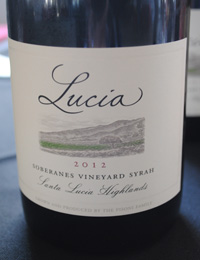 2012 Lucia, Syrah, Soberanes Vineyard, Santa Lucia Highlands.
2012 Lucia, Syrah, Soberanes Vineyard, Santa Lucia Highlands.
The Pisoni family’s Soberanes Vineyard, with it’s young vines, is proving a sensation, it just might be the most exciting new vineyard on the central coast, and Jeff Pisoni is taking full advantage of the quality and character found on this amazing site in the Santa Lucia Highlands. The vines here are the result of knowledge gained from the now legendary Pisoni estate and from top sites that the Pisoni and Franscioni families have planted and managed, like Garys’ Vineyard, plus the experience Jeff Pisoni has gained working with Peter Michael and other estates in the Sonoma Coast area. Soberanes has huge potential and might become as famous as the original Pisoni estate in the years to come, planted here are vines that include the famous Pisoni clone Pinot Noir, much rumored to be a La Tache/suitcase clone, an Old Wente clone Chardonnay and maybe the most exciting an Alban clone Syrah which gives the Santa Lucia Highlands some better material in what has been one of the great success’ of the region, Syrah. Yes, Pinot Noir from here is still the buzz word and yes it is still fantastic, and of course Chardonnay put the region on the map in the first place, but since 2004, and even before, Syrah has produced some of the regions best reds, I honestly think Roar and Lucia have made Syrah just as good as their Pinot, I remember tasting the 2004 vintage and even rating the Syrah higher, and this Soberanes 2012 is fantastic! Jeff Pisoni has crafted a rich, meaty and complex wine here and shown a bit of the future with this dark and layered Syrah, interesting it makes for a wonderful contrast to his wife’s same vineyard and vintage version under the Cattleya label. While Bibiana’s is more floral and higher pitched, Jeff’s is more blooding and earthy, you could say the Cattleya is like Cote-Rotie and the Lucia is more Hermitage or Cornas in style, but really both are Santa Lucia stars, these are great wines from great talents. The 2012 Lucia Soberanes Syrah starts with wild game, new leather, blackberry, briar patch and wild flowers that fill the nose before the explosion of intensity on the palate with boysenberry, blueberry, black currant and spiced plum fruits along with raw meat, black olives, melted licorice, lavender oil and white pepper. There is a bit of raw tannin and vibrant acidity, this wine is still really young, but with air the wine opens to reveal a polished nature and glorious texture with hints of cassis, cedar and cigar spice with just a faint charcoal note. the finish is vivid and lingering, it re-enforces the black and blue fruits and gives a touch of magic that will certainly make you want to have more, don’t miss this excellent wine, drink from 2014-2022.
($45 Est.) 94 Points, grapelive
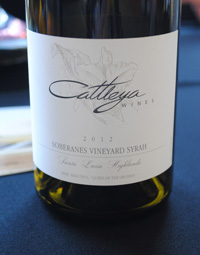 2012 Cattleya, Syrah, Soberanes Vineyard, Santa Lucia Highlands.
2012 Cattleya, Syrah, Soberanes Vineyard, Santa Lucia Highlands.
Bibiana Gonzales Rave is a Colombian woman winemaker, you don’t hear that too often, and she is also extremely accomplished and talented in her craft, she has made wine in Cote-Rotie and now plies her trade her in California, making her wines under her own Cattleya label. Bibiana crafts small lot Chardonnay from the Russian River, a Pinot Noir from Carneros, and this glorious Syrah from Pisoni’s Soberanes Vineyard in the Santa Lucia Highlands. I should also mention she is the wife of Jeff Pisoni, and that is how she found out about the Soberanes site, and fell in love with it’s terroir and especially it’s Syrah. Her first vintage got a huge buzz in the geeky new wine world, and I couldn’t ever seem to get my hands on a bottle, so I was very excited to finally get a chance to taste her wine, and I can tell you it was not a disappointment, her 2012 Soberanes Syrah is fantastic, she certainly gives her husband a run for his money on quality and style, and that is saying a lot, Jeff Pisoni himself is one of California’s best young winemakers. Soberanes is the Pisoni family’s newest site and is located closer to Garys’ Vineyard, but at a slightly higher point in the Santa Lucia Highlands, it offers great exposure and distressed soils, it also has their top clonal selections in the vines, including Wente Chardonnay, Pisoni Clone Pinot Noir and Alban Clone Syrah, this might make Soberanes legendary in a few years when these vines get a bit more age on them, but regardless the potential is there and the quality is already stunning. The 2012 Cattleya Syrah, hand crafted with a long maceration time, and a precision controlled fermentation, cool for the extended soak and warmed when necessary to bring out subtle complexities really shows in this beautiful and aromatic wine, the wine is full of rich density, but delicate, this is a masterful example of the varietal and highlights Bibiana’s talents. The nose starts with violets, loamy earth, hints of wild game, briar and creme de cassis lead, then there is a dark palate of blueberry, boysenberry, loganberry and plum fruits with pepper, black olives, grilled herbs, meat and mineral notes. The layers are supported by pretty smoke and vanilla from the good use of French oak, the smooth and supple tannins melt into the wine and the fruit is lifted by acidity and the wine shows a vitality and vivid nature with a nice lengthy finish that lingers with kirsch, bitter chocolate, black licorice and dusty fruit essence. This wine should gain and develop in bottle, even though it is top notch now, also it will be hard to find as it was a tiny production, hence the price, but it is worth the search and the cost, drink from 2016 to 2022.
($70 Est.) 94 Points, grapelive
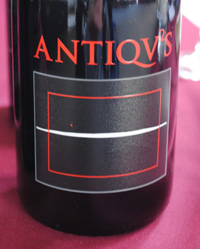 2008 Antiqv2s, Syrah, Pisoni Vineyard, Santa Lucia Highlands.
2008 Antiqv2s, Syrah, Pisoni Vineyard, Santa Lucia Highlands.
This intensely dark Syrah still has vibrant freshness and force, but has started to really come into it’s own, with a few years of bottle age allowing it to reveal glorious detail and class. Emmanuel Kemiji’s Antiqv2s label has been an underground secret for many years, while most Pisoni fans know his Miura wines, these tend to wrongly get overlooked, these Syrah wines, one from Garys’ Vineyard and one from Pisoni, crafted by Byron Kosuge, Kemiji’s longtime winemaker, are stylish and sumptuous Syrahs that are hedonistically full, but with terroir and refinement showing throughout. Sadly it looks like 2010 will be the last vintage of the Antiqv2s, and Kemiji will focus on his Miura label domestically, while he’ll continue making his Spanish wines. Emmanuel Kemiji, master sommelier, is a busy man, a perfectionist and all around great guy and if you get a chance or can find them, I highly recommend these Antiqv2s wines, and especially now that he has dropped the original $60 price recently to about $35 retail for them, that makes for a real great value. The 2008 Pisoni Vineyard Syrah is deeply purple, flowing with lush black fruits, earthy briar, black olives, mineral and white pepper spice while there is classic boysenberry and blueberry compote as the core. This wine is deep and has nice French oak shadings which are subtle to the taste, while camphor and char add to the background notes of cassis, cedar and truffle. This Syrah is delicious and ready to rock and roll, drink now and for next couple of years.
($35-60 Est.) 93 Points, grapelive
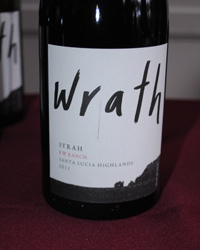 2011 Wrath, Syrah, KW Ranch, Santa Lucia Highlands.
2011 Wrath, Syrah, KW Ranch, Santa Lucia Highlands.
Wrath is a young label and is just starting to gain momentum, though they have been singled out by non other than Robert Parker as a winery to watch and he has graced them with some more than notable ratings, which have helped them massively I am sure. I have myself been much more skeptical and I wasn’t a huge fan at first, and I do have issues with their prices, so it was a pleasant surprise to find this Syrah, which offers top notch quality and relative value. Wrath wines are crafted by the hardworking and I must now say talented Sabrine Rodems, sorry I was late in my praise, she looks to be doing a wonderful job here. Wrath also has Byron Kosuge on their books to consult and give advice, which doesn’t hurt either. The 2011 KW Ranch Vineyard Syrah is a lovely and tasty wine, this vineyard is formerly the Fairview Ranch, a site that Big Basin used to make great Syrah in the past and it is very close to Garys’ Vineyard. The nose is perfumed with violets and dried floral notes, earthy spice, hints of meat and juicy red fruits lead the way, this pretty wine shrugs off the difficult vintage with ease, kudos to the farming and gentle winemaking here, this smooth medium weight Syrah has more than a few similarities to it’s French cousins with hints of camphor, pepper and hints of salad olives. Overall this wine oozes charm and it brightly focused, again it was a nice and welcome surprise, drink now and until 2016.
($39 Est.) 92 Points, grapelive
Chardonnay & Other Whites
Chardonnay is the main and most planted grape in the SLH, it accounts for the most sales and while the mainstay of budget wines, it can be exceptional when done right. Historically it was the Chardonnay that first caught people’s attention to the area, though that was before the AVA was conceived, and wines like Talbott’s Sleepy Hollow were the kings of the region. Today there are dozens of artisan producers making world class Chardonnay here, though I again must warn that from I saw from early samples, 2012 will be a vintage to be very selective in purchasing, lots of these wines showed a total lack of character, and more disappointing was the number that had ugly veggie notes, plus a few that were cloyingly sweet. Also, very worryingly there seems to be pricing madness in SLH Chard too, with lot’s of mediocre or worse wines priced at eye popping levels, but seriously there is a huge disconnect from reality and value in price for quality here. Across the board things need massive step up to on terms with the rest of the wine world. Producers like Bernardus, Morgan, Talbott and Mer Soleil as well as small artisan guys need to up their game, they have the terroir and vines to do it, let’s hope they turn it around. Exceptions were the Roar and Lucia wines, these were definitely standouts. As for other whites, the Rhone varietals are looking good with Viognier and in some cases Roussanne doing very well here. There was a good showing from Pinot Gris, with Puma Road’s off dry style being one of the best, I think it will be worth watch this grape here, and maybe someone will go for something a bit more exotic, who knows. The biggest surprise here came in the form of Riesling, once almost wiped out, it seems to be making a comeback of sorts with at least four or five decent examples to be found and one really shockingly good in a dynamic and dry style.
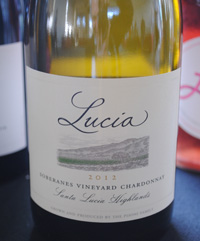 2012 Lucia, Chardonnay, Soberanes Vineyard, Santa Lucia Highlands.
2012 Lucia, Chardonnay, Soberanes Vineyard, Santa Lucia Highlands.
Jeff Pisoni smiles when asked about where the old Wente Clone cuttings came from, I suggest his connections and his past experience at Peter Michael might be involved, but he winks and says nothing more, what is certain is that he has made a darling of a Chardonnay in 2012 from the youngest of the Pisoni Crus, Soberanes and that this is a Chardonnay to search out. Each vintage brings new challenges and solutions, but it also puts experience and knowledge in the bank, and with each year Jeff Pisoni brings more and more to the table, this is a talented winemaker and his wines reflect that, and he has well and truly come out from his dad’s huge shadow and is becoming a legend in his own right, his dad is unbelievably proud these days. The 2012 Soberanes Chardonnay is focused, well crafted and judged, giving depth and richness along with drive and finesse, it shows peach, white flowers, honeyed pear and zest lemon layers with a clarified cream like texture plus hints of brioche, vanilla, saline, mineral and golden fig. Only a slight tropical note and baked apple linger and the vivid acidity holds everything in check. This is a lavish and pleasing Chardonnay, best from 2014 to 2018.
($53 Est.) 93 Points, grapelive
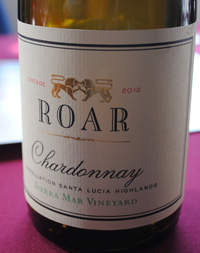 2012 Roar, Chardonnay, Sierra Mar Vineyard, Santa Lucia Highlands.
2012 Roar, Chardonnay, Sierra Mar Vineyard, Santa Lucia Highlands.
This vintage is showy and expressive with loads of pear and pineapple to go along with lemon curd and yellow apple fruits. Roar’s Sierra Mar like Soberanes is a work in progress just starting to mature into a Cru site. While not as classy and refined as Rosella’s can be, the latest Sierra Mar looks set to be a winner and is certainly one of the best wines so far from the vintage. Roar also does a tiny amount of Viognier that is well worth checking out, this is suburb operation fun by Gary Franscioni, with his son Adam and while Ed Kurtzman has left as winemaker there is a real excitement for the future with the young and talented Scott Shapely, who will put his mark on the wines beginning with the 2013 vintage, he worked with Adam Lee of Siduri, and Wells Gutherie (of Copain) while at Roessler. Roar’s first winemaker was Adam Lee, so there is a full circle of talents and subtle transitions happening here, which I think is a good thing and I am looking forward to seeing the up coming releases. The lush and plush 2012 Chardonnay has plenty to like and should gain over the next few years in bottle, look for butterscotch and a creamy texture to develop, but most people will drink this over the next 12 months.
($45 Est.) 92 Points, grapelive
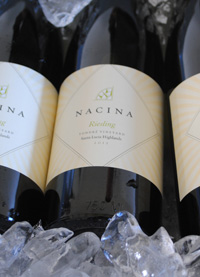 2012 Nacina, Riesling, Tondre Grapefield, Santa Lucia Highlands. (By Tudor)
2012 Nacina, Riesling, Tondre Grapefield, Santa Lucia Highlands. (By Tudor)
While most know and acclaimed for his Pinot Noir, Dan Tudor is now staking out a claim to be the regions best Riesling maker, and I must say the new Tondre Riesling is a stunner, it was a huge surprise and for me, by far and away the best wine ever from the Tondre site! While I’ve had some green meanie issues from Tondre Pinots, I’ll have to admit this Riesling is pretty damn good. I tasted this wine following an extensive tasting of some of the finest Rieslings from Germany, Austria and the Finger Lakes in New York State, so with a huge palate of experience and a slight prejudice I had to eat crow, I honestly found this Nacina Riesling amazingly competent and enjoyed the bracing acidity and crisp dryness. This brisk white delivers zesty citrus, loamy earth, mineral and sour green apple up front and has a layer of lime, grapefruit and melon with hints of tropical essences and verbena. One of the best California Rieslings out there, bravo, drink now.
($20 Est.) 92 points, grapelive
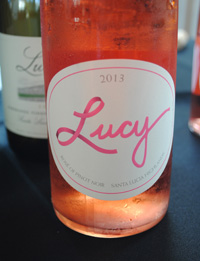 2013 Lucy, Rose of Pinot Noir, Santa Lucia Highlands (Pisoni Family)
2013 Lucy, Rose of Pinot Noir, Santa Lucia Highlands (Pisoni Family)
The Lucy Rose was made to give money to breast cancer research, at least one dollar for every bottle sold, that alone makes you want to get a few bottles, but the Pisoni Family Rose is, regardless of great cause, a super delicious pink wine crafted from estate grown Pinot Noir. This is one of my favorite domestic Rose wines, and this new 2013 vintage, which is soon to be released is one of the best yet, it is bright, fresh and has lots of style and energy. The 2013 Lucy shows a hint of sour cherry, sweet herbs, spice and mineral along with a touch of floral before a blast of citrus, red peach and watermelon. With a bit of air some lovely strawberry comes through and the wine settles down and tastes a bit more like a chilled Pinot Noir along with a subtle richness. This pink is a wine to drink and enjoy young, with it’s vivid flavors, vibrant color and easy to love style the Lucy is a winner all round. Drink over the next 12 months, look for it to be hitting the shelves between Feb 15 and March 2014, and don’t miss it.
($18 Est.) 90 Points, grapelive
March 2014
Grapelive German Riesling 2013 Preview
By Kerry Winslow
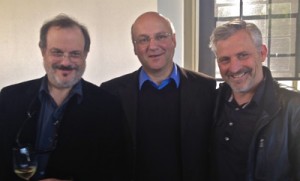
This winter I had a chance to try some barrel/tank samples from some of Germany’s top Riesling producers, they were showing some young 2013 wines, to get a gauge on the vintage. All these wines were presented by Riesling importer Terry Theise, maybe the foremost Riesling expert and fanatic in the USA, his enthusiasm and insight has inspired thousands to enjoy this noble grape, myself included. The good news is the wines are showing well with amazing clarity and heighten aromatics, the bad news is there will be only tiny amounts available later this year and or next, as the crop was greatly reduced due to severe growing conditions in 2013. The German wine scene is hot, the home market is extremely good and even emerging markets are discovering the joy of Riesling, so that means even less wine for the rest of us, especially here in the US, where there seems to be a re-awakening to Riesling, and to German red wines like the fabulous Pinot Noirs coming out of the Ahr. The dry “Trocken” wines again seem to be the center of attention with a real awareness of Grosses Gewachs taking hold, plus non cru dry wines which offer a great value. The sweet wines don’t deserve to be overlooked as they are as beautiful as ever, even as they become a bit less in favor, but seriously the Mosel Spatlese are some of the greatest wines available and can be drunk as table wines and with many cuisine options. Germany is going through classification pains and each governance seems uniquely club like and traditional QbA, Kabinett, Spatlese, Auslese, BA, TBA and Eiswein still confuses some people, as does the VDP’s Cru labeling, but regardless the best producers in Germany’s top regions are making sublime wines and honestly some of the greatest period in the wine world, this is without doubt a golden era of German wine. Here’s a quick look at what’s in store from the 2013 vintage.
Nahe
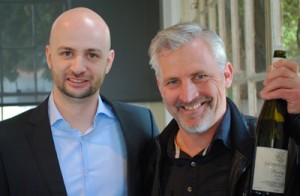
The Donnhoff estate needs no introduction, they are one of the world’s great wineries and this sample of 2013 wines are just stunning. Cornelius Donnhoff’s estate wines are a huge success in this difficult year. The yields were exceptionally low and the grapes came in with great extract and intensity. I think the wines will be a cross between the high acid and extract of 2008, but with the pretty aromas and generous fruit of 2007 or 2011. It will be hard to beat 2012 for overall perfection, but 2013 certainly will not be lagging too far behind in terms of quality or intreats, there just won’t be much on offer, and that is a shame, especially as these Donnhoff wines are very tasty, so be sure to fill out your pre arrival requests early, these will be gone in a flash.
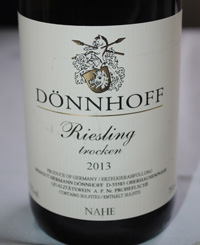 2013 Dönnhoff, Riesling, Estate Trocken, Nahe Germany.
2013 Dönnhoff, Riesling, Estate Trocken, Nahe Germany.
Always a treat and cooly dry the Estate Trocken by Donnhoff is one of the great values in wine, remarkable clarity, mineral driven Riesling of outstanding quality. It will be hard for the 2013 to compare to the 2012 which is still getting better in the bottle as I speak, but it certainly will be a fun companion and it is impeccably well made. I almost compare this bottling to Premier Cru Chablis, but honesty I might rather drink this given the choice 8 out of 10 times, this is just sizzlingly good and vibrant to the core. I’d say buy as much 2012 as you can, but don’t miss out on the 2013 it will be a worthy purchase, and I do adore the heightened aromatics of this vintage. The nose is fresh with lime, white flowers and chalk dust leading to a tangy palate of brisk dryness that includes grapefruit, lime again, unripe green apple and sour tarts. There is vivid steeliness and wet stones along with earthy sea salts, melon and white tea spices adding complexity, look for the extract to expand and roundness in the future when released late spring/summer of 2014, drink from 2014-2018.
($24 Est.) 92+ Points, grapelive
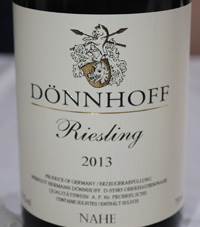 2013 Dönnhoff, Riesling, Estate, Nahe Germany.
2013 Dönnhoff, Riesling, Estate, Nahe Germany.
The semi dry Estate bottling is going to be a winner too, I found it juicy off dry with hints of sweet and sour, it is well defined, balanced and flexible. Again it is hard to match the 2012, but it is pretty darned close, and there will be far less available anyway, so as mentioned it would be wise to stock up on 2012, though I will certainly be getting a few of these myself, the touch of sweetness really makes this a grand summer sipper. The 2013 starts with a tropical note, floral charm and orange leading to a peach and sour apple infused palate with hints of lime, more stone fruit and kiwi, plus hints of mango, mint and river stones. This is pure and easy, super with Asian cuisine and is priced well, especially for the quality. I look forward to seeing what evolves in the bottle, drink 2014 to 2018.
($24 Est.) 91 Points, grapelive
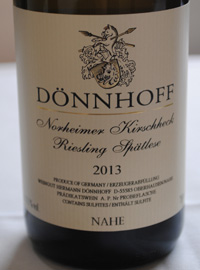 2013 Dönnhoff, Riesling “Norheimer Kirschheck” Spätlese, Nahe Germany.
2013 Dönnhoff, Riesling “Norheimer Kirschheck” Spätlese, Nahe Germany.
This 2013 Norheimer Kirschheck is serious stuff, already a heady and well defined Riesling, incredible really considering this is a tank sample, Donnhoff has crafted a beauty here. This lovely and caressing white has creamy sweetness, plenty of firm extract and deep layers of flavor and there is much more to come given time. This super impressive 2013 Spatlese looks set to have a long and pleasure filled life, I have put it on my own personal wish list, no doubt it will provide amazing drinking enjoyment over the coming decade. I can’t wait to try more of Cornelius Donnhoff’s 2013, hopefully this summer I’ll get that chance, and for sure I am planning to visit the winery in the Nahe when I get an opportunity, maybe later in the year or next year, if plans come together. The 2013 Norheimer Kirschheck Spatlese leads with rocky mineral, white flowers, tropical essences and layered textures with tangerine, apricot, white peach and passionfruit all playing roles as well as green apple and more mixed citrus. There is a touch of density starting to come through, but the fresh acidity holds things in balanced harmony, this pretty Spatlese feels juicy and vibrant even though there is delightful sweetness and fleshiness throughout. Mineral notes and exotic flavors are there in the background, everything is looking good here, I believe this to be a brilliant and excellent Riesling that will continue to impress for a decade or more, drink from 2016 to 2028.
($44 Est.) 94 Points, grapelive
Rheingau
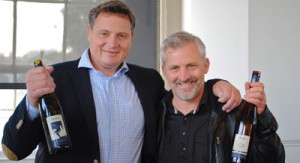
I think the Rheingau will be a big hit for 2013, the wines I tried all offered up beautiful bouquets, crisp mineral notes and impressive depth of fruit. They might develop even more exotic characteristics as time goes by, these were very early samples, but things are looking really good. The leading light of these were the Leitz wines, from his QbA Dragonstone to his Rüdesheimer Magdalenenkreuz Riesling Spätlese, Johannes Leitz crafted some magical wines. After tasting his samples of 2013, I started day dreaming of returning to Rudesheim and hiking these glorious vineyards above the Rhein, this place is still one of my greatest ever wine region visits, it keeps me checking on flight times to Frankfurt! Like the Donnhoff wines from the Nahe, the Leitz wines from 2013 show intense and powerful aromatics with the classic flinty/spice of the slate and the peachy character of the quartzite in the differing soils make of the Rudesheim and Rheingau area. It is hard to imagine a week or so to go by with having a bottle of Leitz Riesling, these wines are so compelling and delicious.
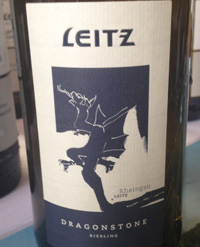 2013 Leitz “Dragonstone” Riesling, Rudesheim, Rheingau Germany.
2013 Leitz “Dragonstone” Riesling, Rudesheim, Rheingau Germany.
The Drachenstein Rudesheim Riesling 2013 is perfumed and vibrantly peachy, it looks set to be another success, I almost like it as much as the currant 2012, which is high praise, I adore the “Dragonstone” this is massively appealing wine, there is always richness and finessed detail to be found in this Riesling, the must weight is usually quite high, this is not a wimpy afterthought, this is serious and deep wine from Riesling grown high up on quarzite soils. I believe this wine is way under priced for the quality. This is terroir and craftsmanship on show, making for a mostly dry feel, but with a hint of sweetness and a full and juicy mouth feel. This 2013 shows exceptional floral character, maybe unique to this small yielding vintage, it is richly flavored with yellow peaches, pineapple, basil notes, flinty mineral and tangy citrus. This entertaining Riesling has star quality at a more than fair price and I love the extract, acidity and creamy length, drink from 2014 to 2018.
($19-22 Est.) 91-92 Points, grapelive
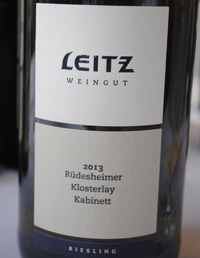 2013 Leitz, Riesling, Rüdesheimer “Klosterlay” Kabinett, Rheingau Germany.
2013 Leitz, Riesling, Rüdesheimer “Klosterlay” Kabinett, Rheingau Germany.
Another great value from Johannes Leitz is the flavorful and elegant Klosterlay Kabinett which would be a great dessert island wine, you could survive on this no problem, if there was only one choice, especially as it is well suited to be enjoyed with warm weather, tropical cuisine and seafood! I am impressed to see the 2013 showing so well, it really is right up there with the dynamic and gorgeous 2012’s produced by Rheingau favorite Johannes Leitz. Rudesheim’s terroir and exposure is historic, this is a perfect winegrowing area and it’s little wonder it is Meursault’s sister city, this is wine country at it’s best and these wines are as good as any made anywhere. The Klosterlay is honeyed pear, lime, tangerine and peach driven with a hint of sweetness, spice and stony, everything is beautifully detailed and weighted artistically. This fine expression should drink well over the next 3 to 5 years, but there is enough stuffing to last a decade, this is nice juice, drink from 2014 to 2018.
($22 Est.) 92 Points, grapelive
 2013 Leitz, Riesling, Rüdesheimer “Magdalenenkreuz” Spätlese, Rheingau Germany.
2013 Leitz, Riesling, Rüdesheimer “Magdalenenkreuz” Spätlese, Rheingau Germany.
Coming from one of the top sites in Rudesheim the “Maggie” 2013 is a stunning young Spatlese, be sure to keep an eye out for this one, it is a sleeper. This pristine and crystalline Riesling is full of flavor, charm and elegance with layers of detail and a rich sweet core of fruit, balanced by loamy earth, spice and kicking acidity, this is terrific wine start to finish. The talents of Johannes Leitz and mother nature came up with something rather special here and the 2013 Leitz Rudesheimer Magdalenakreuz is a joyous Riesling of class and extravagant underpinning, I think Johanne’s Maggie is one hot ticket! The nose offers up rose petal, tropical notes and fruity character leading to a vigorous palate of sweet apple, peach, fleshy apricot and pink citrus while white plums, fresh herbs, mineral tones and saline add complex edges. There is a lot going on here, but overall everything flows smoothly and harmoniously from start to finish with a lingering sweet note, though more is certainly coming to the mix, I suspect more intrigue over the next few years, further examination will be required and happily I might add, I am really excited by these 2013 samples, I can’t wait to taste the finished product in bottle, just be sure you chase some down as they look set to be rarities even before release, drink this one from 2016-2022.
($28 Est.) 93+ Points, grapelive
Pfalz
While there wasn’t much on offer of the 2013 from the top producers, I was informed by reliable sources that here too the 2013 vintage looks set to have made some intriguing wines. I look forward to trying the likes of von Winning, Muller-Catoir and other this summer when bottle samples will likely be more readily available. The Pfalz is an exciting region with a vast array of varietals and styles to chose from, there are some amazing wines coming from here and if you’ve not stocked up on the glorious 2012 vintage you are missing out!
Ahr (not a big Riesling area, but worth mentioning)
The Ahr is one of the hottest regions for Pinot Noir on the planet, and while 2011 and 2012 might be the best vintages back to back ever seen, I will certainly be keeping an eye out for 2013, though that should be about another year or so before any real meaningful samples get offered. 2010 was pretty decent with soft pretty wines, but 2011 and 2012 are amazing for Spatburgunder, these Pinot Noirs are just starting to hit the market and should not be missed, especially the wines of Meyer-Nakel, these wines would make even the most hardcore Burgundian cry with joy. If you are looking for unique and extreme Pinot Noir, this region is one to check out.
Mosel-Saar
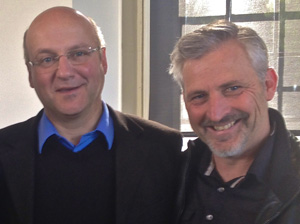
famed Mosel winegrower Johannes Selbach of Selbach-Oster told me flat out the 2013 was an economic disaster with grapes and quality juice down over 60%, but even with this terrible business reality the bright spot is what little amount of wine that was made in 2013 looks super. Selbach had a new, first time Kabinett from his Saar holding for 2013 and it was delightful and already easy to drink, it will certainly be on my list of wines to grab when releases later this year. The Selbach-Oster 2012 wines continue to perform well, and in fact are quite remarkable, so while there isn’t going to be much as of way for the 2013 vintage, you should stock up on 2011 and 2012 while you can. Johannes confessed his own stocks are running extremely low on these fantastic vintages, so I headed his advise and stashed some Schlossberg Kabinett myself! Other a real happy note, I got to finally try the single block Zeltinger Himmelreich “Andrecht” 2012 which is due here in the states in May (2014) and while I’ve already posted the review, I think it is worth mentioning again this is one of the great whites of the vintage and I believe a legendary wine. I also got to re-sample the Zeltinger Sonnenuhr “Ur Alte Reben” which again blew me away, it is a Feinherb, but forget classification or RS, this is a stunning wine that too will go the way of legends, so while not many 2013’s will be coming there is still something to look forward to, these two wines could be the most under the radar collectables on the planet, if you are a Riesling fan these are must find wines, trust me, you don’t want to miss them.
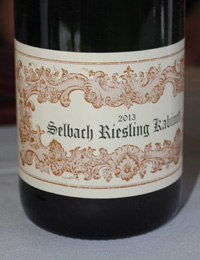 2013 Selbach, “Saar” Kabinett, Saar Germany.
2013 Selbach, “Saar” Kabinett, Saar Germany.
The Selbach Saar Kabinett is the first of it’s kind, previously there were only Spatlese under this label, in 2013 there was an opportunity to pick twice from this section, one to make this Kabinett and again later for the Spatlese, and while quantities are tiny it is a great addition to the lineup. Johannes would have liked a normal vintage for obvious business reasons, he just shakes his head thinking about the lack of grapes in 2013, but he cannot be unhappy with the quality that is for sure. Even this little Kabinett from the Saar land is sumptuous and delicious with loads of fruit, purity and vivid character. Even though I am eagerly waiting on his more classic Mosel wines from places like Graacher and Zeltinger, this little gem is enough to tell you Selbach is going to have a nice collection of Riesling to search out in 2013, though you’ll have to fight to get them, especially if there as scare as Johannes hints at… The 2013 Saar Kabinett starts with pretty citrus blossoms, chalky stones, steely mineral and green apple with sweet pineapple, spiced peach and candied lemon rind along with tangy elements and fresh acidity. There is plenty of extract and this wine is really well defined with much more detail and focus than might be the case in an average vintage, there is plenty to love here, drink from 2014 to 2017.
($20-24 Est.) 90-92 Points, grapelive
Many thanks to Terry Theise, Hiram Simon (Wine Wise) plus Cornelius Donnhoff, Johannes Selbach and Johannes Leitz for their time, insights and kindness!
March 2014
The La Paulee is a celebration of Burgundy, it was first established in New York in 2000 by the famed Daniel Johnnes as homage to the festivals of Burgundy’s fabled Meursault which themselves have been celebrated since 1923 in modern times. The La Paulee has included recently San Francisco and Aspen to it’s lineup, both places quickly rising to the occasion and putting on amazing Burgundy events. The tradition is to put on lavish wine dinners with over the top combinations of food and of course wine, with expansive vertical collections of famous producers, the great vintages and the latest releases. In San Francisco, restaurants, sommeliers and retailers all put on mind blowing tastings with winemakers, importers and celebrated authors, critics and wine professionals pouring a vast array of fine Burgundies. This is the time to catch the magic of this fabled region, there is a staggering collection of tasting to attend, for the novice and serious collector alike, be sure to check out the list of events at the La Paulee website, these will sell out, in fact many have already so be sure of availability and get your RSVPs in asap.
My La Paulee event notes will be posted here with some of the wines reviewed.
San Francisco Wine Trading Company’s Philippe Pacalet Tasting
March 8, 2-5:30pm
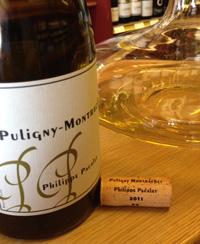 2011 Philippe Pacalet, Puligny-Montrachet, White Burgundy, France.
2011 Philippe Pacalet, Puligny-Montrachet, White Burgundy, France.
The gorgeous and rich 2011 Philippe Pacalet Puligny is a textured and fresh Chardonnay of wonderful class and detail. Pacalet sources small yielding organic grapes from select plots, employs gentle natural native yeast fermentation and ages on the lees in neutral cask making a stylish and generous wine that showcases terroir, vivid transparency and heightened flavors. Pacalet’s natural winemaking might work best in his glorious white wines, while he gets most attention for his reds, these whites are stunning wines, both his Meursault and Puligny-Montrachet shine brightly and standout for their lovely texture, vivacious character and class, these are strikingly beautiful wines. The latest Puligny-Montrachet, the 2011 is pure joy in the glass with vibrancy and charm, it shows white flowers, apple, white peach, lemon oil and spiced pear along with steely mineral, hazelnut and wet stones from a cold river. This is lovely Puligny, it feels decadent and noble without being heavy and while young it delivers lots of pleasure and finesse, drink over the next 5 to 8 years. While the 2010 was a tad more gripping and austere, the 2011 is more open and expressive, this is golden nectar through and through, both graceful and lively.
($100+ Est.) 95 Points, grapelive
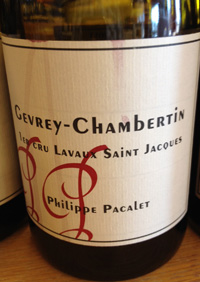 2011 Philippe Pacalet, Gevrey-Chambertin, Lavaux Saint Jacques Premier Cru, Red Burgundy, France.
2011 Philippe Pacalet, Gevrey-Chambertin, Lavaux Saint Jacques Premier Cru, Red Burgundy, France.
The 2011 Gevrey-Chambertin Lauvaux Saint Jacques 1er Cru is gorgeous and full of life and intensity, this is beautiful and exciting Pinot Noir, this is light handed, gentle winemaking at it’s finest. Pacalet, known for his natural wines techniques, his low sulfur and organic grape sourcing should really just be known for his quality product period. Pacalet’s wines are generous, spicy, brightly flavored and wonderfully clear and transparent, these have become stars in there own right, leaving behind the tagline best of the “Natural” wine in Burgundy, these wines are now among the new wave of elite without prejudice. Philippe Pacalet has been making Burgundy under his own label now since 2001, and with ten years on record, his wines have moved from novelties to proven delectables. The 2011 Lavaux Saint Jacques is a classy, elegant wine, Pacalet as always used 100% whole cluster and native yeast, with seasoned oak, ending up with a low natural alcohol at about 13% wine that shows balance, structure and alluring presence and depth. The nose is brightly fresh with earth, flowers and tangy fruits, there is mineral and zesty spices too, the layers of fruit is impressive with peppered raspberry, strawberry and plum adding to the core of morello cherry along with truffle, mint tea, dried roses in this ruby hued wine. While Pacalet is proud of the 2010 vintage, maybe his favorite, I am thinking these 2011 wines are not far off and I feel they are showing fantastic and make for great early drinking wines, though with enough stuffing and acidity to last another decade easy. If Pacalet is not on your radar and you are a serious Burgundy lover, you need to check these wines out, they will not disappoint!
($125 Est.) 94+ Points, grapelive
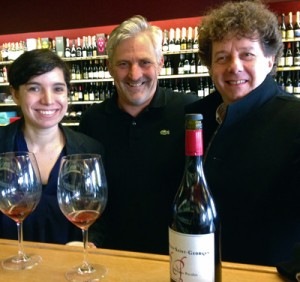 Philippe Pacalet and his wife Monica are in the bay area this week for La Paulee, they have been busy with 10 events in 7 days for their US importer Return to Terroir, even so I got a chance to meet up and taste, and I’ve been lucky to have tasted his wines from 2008, 2009, 2010 and the currant 2011 vintages, knowing these are glorious and well crafted Burgundies. Pacalet makes about 30 different wines per vintage, all small lot stuff, mostly single vineyard, though he does a few AC or village wines too, I tasted his Nuits-St.-Georges 2011 with him, and while the premier crus are a bit more detailed, this NSG was a beauty, and his regular Gevrey-Chambertin is a stunning example as well, plus he does Meursault and one of my favorite Puligny-Montrachets, without question Philippe has the magic touch. I’ll be tasting through a further selection of his limited cuvees on March 8 and more notes will follow, La Paulee 2014 is awesome and has brought some of Burgundy’s brightest stars to San Francisco, I’m really grateful to have had the chance to pour some of these great wines and meet some wonderful people, like the Pacalets!
Philippe Pacalet and his wife Monica are in the bay area this week for La Paulee, they have been busy with 10 events in 7 days for their US importer Return to Terroir, even so I got a chance to meet up and taste, and I’ve been lucky to have tasted his wines from 2008, 2009, 2010 and the currant 2011 vintages, knowing these are glorious and well crafted Burgundies. Pacalet makes about 30 different wines per vintage, all small lot stuff, mostly single vineyard, though he does a few AC or village wines too, I tasted his Nuits-St.-Georges 2011 with him, and while the premier crus are a bit more detailed, this NSG was a beauty, and his regular Gevrey-Chambertin is a stunning example as well, plus he does Meursault and one of my favorite Puligny-Montrachets, without question Philippe has the magic touch. I’ll be tasting through a further selection of his limited cuvees on March 8 and more notes will follow, La Paulee 2014 is awesome and has brought some of Burgundy’s brightest stars to San Francisco, I’m really grateful to have had the chance to pour some of these great wines and meet some wonderful people, like the Pacalets!
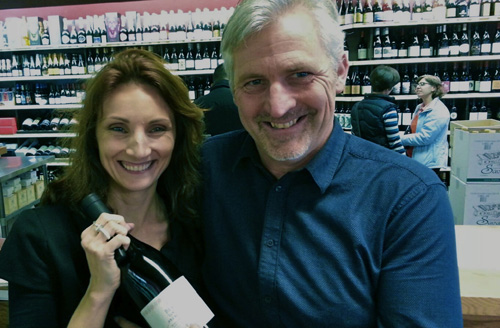
San Francisco Wine Trading Company’s Pascal Marchand Tasting
March 1st
Pouring along side Mark Fincham of Maison Marchand-Tawse and Aline Thiebaut the US importer of Marchand was a great experience and a thirsty crowd was appeased with a selection of fantastic 2011 wines from the Canadian born Pascal Marchand, former winemaker at the famous Comte Armand Pommard domaine. With the backing of Tawse, Marchand is a fast rising star in the Cote d’ Or and they have recently added estate holdings in prime locations with the purchase of longtime old school favorite Domaine Maume with top pacels in Chambertin, Gevery as well as their longtime leases in Nuits-St.-Georges, Pommand and Morey-Saint-Denis, these guys mean business and are the real deal. The 2009 and 2010 wines were stunning, but I must say these 2011 Burgundies across the board showed incredibly well and in some cases even better. Be sure to look for these wines, these are impressive and small lot wines, mostly from biodynamic or all organic low yield sites. Some of the smash hits in the tasting were the fabulous 2011 Meursault, 2011 Nuits-St.-Georges, 2011 Corton, 2010 Mazy-Chambertin (aka Mazis-Chambertin) and the wildly seductive and sexy Morey-St.-Denis Rue de Vergy, the Meursault was classic, brooding with hazelnut, lemon and crushed stones, majestic in style and the reds were equally as intriguing with my fags being the Beaune Premier Cru and that gorgeous Rue de Vergy Morey-Saint-Denis.
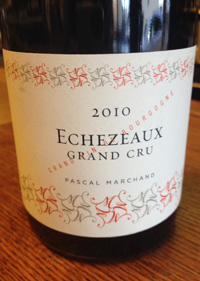 2010 Pascal Marchand-Tawse, Echezeaux, Grand Cru Red Burgundy, France.
2010 Pascal Marchand-Tawse, Echezeaux, Grand Cru Red Burgundy, France.
The Canadian Pascal Marchand continues to rise in Burgundy, he is credited with bringing Comte Armand back into the limelight and now under his own label his wines are garnering much attention and accolades, this seems very much deserved after tasting the last three vintages. Mr Marchand and Mr Tawse have now completed their takeover of the Domaine Maume estate and it will be interesting to see what Maison Marchand-Tawse does with those historic plots and I can’t wait to taste the finished wines, the first will be from the 2012 vintage, but until then we can enjoy the 2009, 2010 and 2011 wines, which are stunning, especially so is this 2010 Echezeaux Grand Cru. sitting outside the tiny village of Flagey in the Cote de Nuits, the glorious vines of Echezeaux are one of the area’s main attractions, this is Pinot Noir country and this Grand Cru remains one of the great values in Red Burgundy, while not cheap, the wines of Echezeaux are most often half the price of the other Grand Crus and in fact many Premier Cru wines fetch more these days, so if you want a great Burgundy and still want a deal, look to Echezeaux, and Marchand’s 2010 is a great place to start, it is rich, intense and wonderfully detailed. The 2010 Echezeaux starts with rose petals, wild mushrooms, red currants and elegant wood notes leading to a lush and silky palate of dense fruit, this medium weight Burgundy delivers layers of textural pleasure with raspberry, black cherry and plum along with hints of vanilla, cured meat, dried violets, tea spice and shaved fennel. There is a stony mineral essence and lush mouth feel with a long aftertaste, plus a good core of acidity bringing flavors a perfect pitch, this is super Pinot Noir, still full of vigor and youth, drink from 2016-2022.
($125-150 Est.) 94 Points, grapelive
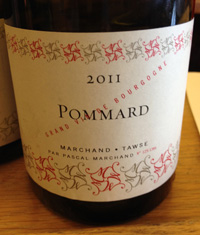 2011 Maison Marchand-Tawse, Pommard, Red Burgundy, France.
2011 Maison Marchand-Tawse, Pommard, Red Burgundy, France.
Pascal Marchand, the former Comte Armand winemaker, knows Pommard and how to get the best of it and this 2011 shows his skill and touch, this is a wonderful expression of finesse and terroir, this wine is a gift to cherish. While the vintage is not going to get lots of praise or press, these wines from Marchand are almost as delectable as his 2009 and 2010 wines, I think they are solid choices for true Burgundy lovers and non investment buyers, these wines are highly enjoyable and should age well with a lifespan of 10 to 15 years easy, though they are generous and drink well even now. The 2011 Marchand wines are a savvy choice and will not disappoint, especially this lovely Pommard with it’s racy red fruits, spice and chalky mineral tones. The 2011 Pommard starts with a bouquet of dried roses, minty herbs, warm stones and a touch of earth and iodine leading to a palate of refined silky tannins, bright acidity and giving lush fruits that include a core of cherry, plum and raspberry while a long lingering wild strawberry stays throughout and haunts long after the glass is empty. There is dusty stones, anise, tea spice and truffle notes as well making for an entertaining and seductive wine. This is really well crafted, radiant and engaging Pinot Noir, and again a wine for wine lovers, drink from 2015 to 2022. Tasted a finished bottle sample durning La Paulee SF Burgundy Week, it will be arriving in May of 2014.
($80 Est.) 94 Points, grapelive
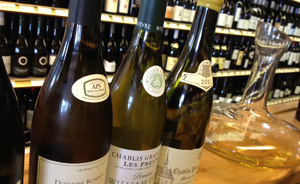 San Francisco Wine Trading Company’s Chablis Tasting Flight
San Francisco Wine Trading Company’s Chablis Tasting Flight
March 2nd
A wet and dreary day could stop a huge gathering of Chablis fans, and I poured Chablis almost until my arms ached and feet gave out! Thanks to all those that came out to taste, it was a super fun and educational tasting of mineral laced stony Chardonnay, and one delightful Sauvignon Blanc thrown in as an extra since it was made by a Chablis producers from vines just down the road in Saint-Bris. Chablis is a special place, sitting on ancient soils in the northern most part of Burgundy, this famous region makes for a unique and vastly differing styles with a common terroir link, these are steely and mineral driven wines of freshness and charm. I poured some 2012, 2011 and a few 2010 vintages from Petite Chablis to Grand Cru with a highly prized Raveneau Monte de Tonnerre Premier Cru in the mix. All the wines showed well and each had their fans including the La Chablisienne Saint Bris that for about $10 was delightful and zesty, but of course most people came to try the rare and exotic Raveneau which did not disappoint, though some preferred the William Fevre Les Preuses Grand Cru which was refined, woody and round, plus the Romain Collet 2010 Premier Cru Montmains, maybe the dark house in the lineup, it showed the nature of the Fevre and the vibrancy of the Raveneau with lime tones and hints of smoky vanilla, it was still young. These Chablis were tight, firm and brisk in the bottle, which made decanting essential and was a huge reminder to myself and those present that it is always important to decant young wines, though of course mature wines need TLC and delicate/gentile handling.
I love fine Chablis, and I’m a huge fan of Bernard Raveneau and his wines, so the experience of his Montee de Tonnerre, my absolute favorite was epic!
Coming next
San Francisco Wine Trading Company’s Philippe Pacalet Tasting
March 9, 2-5:30pm (go to www.sfwtc.com for details)
Grapelive La Paulee Wines
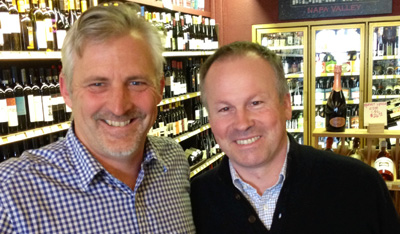
2010 Domaine de Chateau de Puligny-Montrachet, Nuits-St.-Georges Clos des Grandes Vignes, Vielles Vignes, Premier Cru Red Burgundy, France.
The Premier Cru Clos des Grandes Vignes in Burgundy’s famed Nuits-St.-Georges is all biodynamic and is a pure monopole site, these Clos vineyards seem to be historic 19th century creations, these walled areas make up some of the best Pinot Noir in the region with some of the oldest vines in Burgundy it’s self, some well over a hundred years old. Chateau du Puligny-Montrachet under Etienne de Montille since 2002 has made Premier Cru from Clos des Grandes Vignes from 2006 to 2012 and has since sold the vineyard in a restructuring of their holdings, which sadly became necessary when Etienne needed financing to purchase the Domaine. His efforts here at Clos des Grandes Vignes are brilliant, and his fantastic 2010 is sublime and one of the best values in top Burgundy I’ve seen from the hailed 2010 vintage with wonderful density, vigor and length, this truly is provocative and stylish Pinot Noir. This old vine cuvee was completely whole cluster and shows lively steamy spices, heightened aromatics and a majestic play of ripe flavors and earthy savory counterpoints, firm tannins, tangy acidity and a silky texture that coats the palate leaving a detailed and long finish. The nose starts with briar, bramble and red currants, a touch of smoke, truffle and pepper leading to a racy mouth of cherry, black raspberry and plum fruits along with minty herbs, anise and pomegranate while mineral, loam, saline and baking spices add complexity. After tasting the latest lineup of Domaine Chateau de Puligny-Montrachet with Etienne, I have no doubt the future is looking bright for this label, I’ve always enjoyed these wines, but this set are a major step up, especially his 2011 whites with a stunning purity and excitement, the St. Aubin and Pulignys really shined, but I could not resist this lovely Nuits-St.-Georges Clos des Grandes Vignes it is simply gorgeous Burgundy and filled with magic, emotion and charm, drink from 2016-2025.
($70 Est.) 95 Points, grapelive
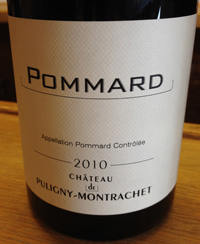 2010 Domaine du Chateau de Puligny-Montrachet, Pommard AC, Red Burgundy, France. The 2010 and 2011 wines by Etienne de Montille and his Domaine du Chateau de Puligny-Montrachet estate are fantastic and remarkable values in the face of rising prices from Burgundy, and his 2010 reds are exceptional, especially this provocative and alluring Pommard. Etienne and his sister Alix, sine taking over from their famous father Hubert de Montille have both made quite a name for themselves and are both regarded as fine and gifted winemakers with Alix making the Domaine’s whites and Etienne making the family’s reds, but at Chateau de Puligny-Montrachet, Etienne makes all the wines and has done for ages, though since taking over the Domaine du Chateau de Puligny-Montrachet there has been talk that Alix will now join the team there as well. I was thrilled to taste through the Chateau de Puligny lineup with Etienne just prior to the La Paulee 2014 San Francisco, and I’ve always been a fan of this label. The 2010 Pommard is vigorously exciting, elegantly crafted and lengthy with intriguing depth, flavor and focus, this is wonderful Cote de Beaune Pinot Noir that shows real class and terroir. The nose is lively with spiced red fruits, herbs and dried flowers leading to a medium palate of delicate red raspberry, plum, tangy currant and morello cherry fruits with mineral, chalky stones, briar, earthy elements, cured meat, peppery spice, lavender/anise, saline and cinnamon/vanilla notes. There is refined, but firm tannins, brisk acidity and with air the wine gains density and richness, there is a dynamic force driving this wine, though it does fill out and deliver soft lush texture with time in the glass, this is a wine that might need another 3-5 years to really show it’s potential, but it is lovely now too, drink from 2016-2022. ($56 Est.) 93-94 Points, grapelive
2010 Domaine du Chateau de Puligny-Montrachet, Pommard AC, Red Burgundy, France. The 2010 and 2011 wines by Etienne de Montille and his Domaine du Chateau de Puligny-Montrachet estate are fantastic and remarkable values in the face of rising prices from Burgundy, and his 2010 reds are exceptional, especially this provocative and alluring Pommard. Etienne and his sister Alix, sine taking over from their famous father Hubert de Montille have both made quite a name for themselves and are both regarded as fine and gifted winemakers with Alix making the Domaine’s whites and Etienne making the family’s reds, but at Chateau de Puligny-Montrachet, Etienne makes all the wines and has done for ages, though since taking over the Domaine du Chateau de Puligny-Montrachet there has been talk that Alix will now join the team there as well. I was thrilled to taste through the Chateau de Puligny lineup with Etienne just prior to the La Paulee 2014 San Francisco, and I’ve always been a fan of this label. The 2010 Pommard is vigorously exciting, elegantly crafted and lengthy with intriguing depth, flavor and focus, this is wonderful Cote de Beaune Pinot Noir that shows real class and terroir. The nose is lively with spiced red fruits, herbs and dried flowers leading to a medium palate of delicate red raspberry, plum, tangy currant and morello cherry fruits with mineral, chalky stones, briar, earthy elements, cured meat, peppery spice, lavender/anise, saline and cinnamon/vanilla notes. There is refined, but firm tannins, brisk acidity and with air the wine gains density and richness, there is a dynamic force driving this wine, though it does fill out and deliver soft lush texture with time in the glass, this is a wine that might need another 3-5 years to really show it’s potential, but it is lovely now too, drink from 2016-2022. ($56 Est.) 93-94 Points, grapelive
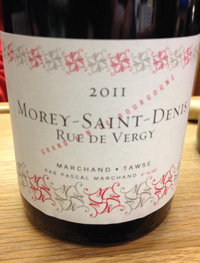 2011 Pascal Marchand, Morey-Saint-Denis, Rue de Vergy, Red Burgundy, France.
2011 Pascal Marchand, Morey-Saint-Denis, Rue de Vergy, Red Burgundy, France.
The Marchand-Tawse label of Pascal Marchand is a winery to watch and start collecting if you are a rabid Burgundy lover, these are stylish, richly favored and intriguing wines that deeply show a sense of place as well as being well crafted and balanced. Marchand’s 2011 offerings are highly successful and dynamic, these are wonderful drinkers, especially his marvelous Morey-Saint-Denis selections, of which I am partial to. The 2011 Rue de Vergy is beautiful, textured and seamless with hints of violets, earthy loam, spice and an array of red and blue fruit, and while the 2009 and 2010 wines were stunning, this 2011 is showing remarkably well and looks set to be right on par. The nose starts with floral and wild herb notes along with mineral and touches of game and cassis leading to a palate of cherry, plum and black raspberry fruit, cool stones, rose petal tea, truffle and anise. This is suburb and focused Pinot Noir that has good vivid flavors, character and juicy acidity, it shows silky tannins and leaves a nice long finish with lingering strawberry, violets and very subtle wood. Drink from 2014 to 2020, this is a Burgundy lovers discovery for short to mid term enjoyment, no need to hide these beauties away for ages.
($65 Est.) 93 Points, grapelive
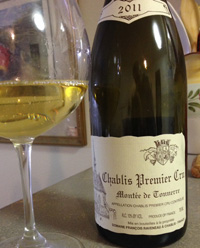 2011 Domaine Francois Raveneau, Chablis, Montee de Tonnerre, Premier Cru, White Burgundy, France.
2011 Domaine Francois Raveneau, Chablis, Montee de Tonnerre, Premier Cru, White Burgundy, France.
Raveneau Montee de Tonnerre is my favorite Chablis, though I must say if I could afford Les Clos it might be a little higher in my favorite list, but honestly I adore Montee de Tonnerre and love it’s vigor, intensity and unique charms. I consider myself very lucky indeed to have experience with Raveneau’s Montee de Tonnerre, going back more than a few vintages and for me this wine is everything you could ask or want from a great Chablis it shows vibrancy, terroir and complexity with exotic notes and lots of steely minerality. As a part of a La Paulee San Francisco tasting I had a chance to pour and show this marvelous wine, and while it is not for everyone, it is truly one of the world’s most exciting white wines, I decanted two bottles and showed one without decanting, the difference was amazing, note to self, decant, decant, decant! The 2011 vintage is showing much better in bottle than some critical voices have suggested and after an hour of decanting the Raveneau Montee de Tonnerre was explosively stunning and hitting on all cylinders, this is fantastic Chardonnay with lively flavors and beautiful details. The nose is still shy with hints of citrus flower, white tea, briny/seaweed, chalk and grapefruit, but the palate is vocal with a choir of layers music including green apple, lime, kiwi and vivid lemon along with marmalade notes, wet river stones, saline, tangy citrus pip and soft leesy tones. With air and a slight warming in the glass the texture turns creamy and a hint of vanilla comes forth, but you never lose the acidity and focus, this is wondrous and classic Chablis and a pure heavenly joy to behold, Drink from 2016 to 2023, worth every penny on the right occasion.
($160 Est.) 95 Points, grapelive
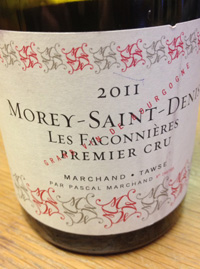 2011 Maison Marchand-Tawse, Morey-Saint-Denis, Les Faconnieres Premier Cru, Red Burgundy, France.
2011 Maison Marchand-Tawse, Morey-Saint-Denis, Les Faconnieres Premier Cru, Red Burgundy, France.
Only 2 barrels of this seductive and gorgeous Morey-Saint-Denis were made in this vintage by the talented hands of Pascal Marchand, so I highly recommend getting your hands on some, it is ultra lovely and a stylish Burgundy of quality and class. The Les Faconnieres Premier Cru sits just across the road between the two Grand Crus of Clos Saint-Denis and Clos de la Roche sandwiched by Les Millandes Premier Cru and Les Charieres, and not far from Clos des Ormes, this is great terroir and it shows in this beautiful wine. I loved the 2010 version, but considering the vintage, this 2011 might even be better and is certainly a greater feat, I was blown away, it is one of the finest Premier Crus I’ve sampled to date. Marchand’s 2011 Les Faconnieres starts with heightened floral aromas with a bowquet of violets and rose petals with hints of tea leaves, forrest floor and shaved fennel to go with red fruits and mineral. The palate is move expansive that you’d think with richness, texture and luxurious mouth feel, this is dreamy Cotes de nuits with red currants, black cherry, plum and wild strawberry fruits, tangy spice, saline and wet chalk, plus hints of loamy earth, game and new leather add to the details. A touch of blackberry, licorice and sweet char linger on the delicious finish, again I suggest locating some of this entertaining Burgundy, drink from 2015 to 2021, very very tasty stuff.
($80 Est.) 95 Points, grapelive
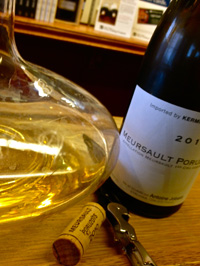 2010 Domaine Antoine Jobard, Meursault-Poruzots, Premier Cru White Burgundy, France.
2010 Domaine Antoine Jobard, Meursault-Poruzots, Premier Cru White Burgundy, France.
This is a seriously chiseled Meursault, unbelievably firm and lean with sizzling acidity and powerful, just as Jobard wanted and dreamed of I’m sure. This golden nectar will surly need a decade to unfold all of it’s charm and unleash it’s potential, but that all being said and true, this fine and masterful Chardonnay is glorious with exceptional purity, focus, drive and terroir, this could be only Meursault Poruzots and certainly this vintage is completely on show, with Jobard’s signature style. This mineral laced beauty maybe the Ice Queen at the moment, but the extract, detail and length are all there, I love the energy and force on display even now, it shows wet stones, lemon, pear and subtle fig along with matchstick, hazelnuts and clove spice. Even decanting hardly got this tight and vivid Meursault to open, this is dynamic wine and as much as I begged it, it will require the ultimate in patience, though the rewards will be stunning, no question, everything is there like a treasure just out of reach for now. A few years back, I was able to sample a selection of Jobard wines with 10-12 years of age on them, and they were glorious and still very vibrant and youthful, so be sure to lock these puppies away, and to those that do, well, lucky you, these will be wonderful surprises in time, I can only imagine, and be sure to have a Lobster around! Drink from 2018 to 2024, for those that adore classic white Burgs, this wine would be a great investment in future pleasures.
($120 Est.) 94 Points, grapelive
 2012 Domaine Savary, Chablis, Vieilles Vignes Selection, France.
2012 Domaine Savary, Chablis, Vieilles Vignes Selection, France.
A racy brisk Chablis with dynamic character, the Savary Old Vine is a terrific and classic wine that offers a stunning value. Olivier Savary is a rising talent in Chablis and his wines are secretly called baby Raveneaus, highlighting the quality and style his wines show. The 2012 Savary Vieilles Vignes is vibrant and fresh with pure Chardonnay varietal charms, lime, lemon and green granny smith apples with hints of steely mineral, loads of chalky limestone and wet river stones. This is a white Burgundy lover’s dream, this is very vivid and elegant wine, do not miss.
I’ve been a fan since the 2007 vintage, and this wine year after year has been consistently one of my favorite Chardonnays, especially for the price, there are not too many wines that compare, drink now through 2020.
($28 Est.) 92+ Points, grapelive
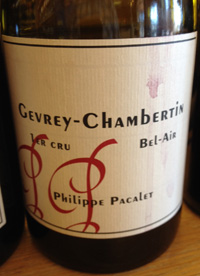 2011 Philippe Pacalet, Gevrey-Chambertin, Bel-Air Premier Cru, Red Burgundy, France.
2011 Philippe Pacalet, Gevrey-Chambertin, Bel-Air Premier Cru, Red Burgundy, France.
Philippe Pacalet’s new 2011 wines are a revelation and take his label to the next level, from a difficult vintage they are stylish, richly flavored and possess that Burgundy magic, the undefinable element that becomes the holy grail of all wine critics and wine lovers, it is that unexplainable joy and or emotional response that certain Burgundy (Pinot Noir as well) can give that just makes all the stars align and haunting music play when you experience it. Whatever the X factor is, Pacalet’s wines have it, especially his Gevrey-Chambertin Premier Crus, like this fantastic Bel-Air, which is already drinking with lovely fruit, poise and length. The 2011 Pacalet Gevrey-Chambertin Bel-Air Premier Cru is deeply layered with a nice floral perfume and a complex character, it comes from broken rocks, a touch of clay and a root of limestone soils, it was made from a tiny yield of grapes, which explains the concentration and intensity, all the vines are organic and only native yeasts are used, everything was 100% whole cluster (fermented with stems) and aged on it’s lees for 16 months in cask without racking, this is natural and gentle artisan winemaking, and the results are stunning. The nose starts with rose petals, wild flowers, hints of game, spice, kirsch and a mix of red fruits, leading to a full mouth of black cherry, plum and mountain berries along with pepper, chalky stones, mineral and truffle notes. With air a tangy raspberry, sandalwood and briar side come through, hints of fine tannin coat the palate plus a juicy red peach, guava and lavender oil. This a firm and salty wine still, but very expressive and captivating even at this young stage, bravo to Pacalet, this is great stuff, drink over the coming decade.
($110-125 Est.) 94+ Points, grapelive
More to follow!
La Paulee Burgundy Week San Francisco
October 2013
German Riesling Vintage 2012 Report
By Kerry Winslow
Riesling, this amazing grape is one of the most terroir driven varietals there is, it always gives pure expression of place, transparently delivering striking wines that reflect exposure and soil. Germany showcases this with different examples of schist, slate, loam, loess, limestone and sandstone all adding interesting characteristics to each region and each wine. Riesling, while great in both France and Austria, seems spiritually connected to Germany and it’s famed regions like the Rheingau, the Mosel, the Nahe and the Pfalz, to name a few historic areas.
The latest releases from Germany show 2012 is a year to celebrate in the glories of Riesling, no other year has moved me as much as this one in early tastings, and the potential is there for this to be one of the absolute great vintages in our generation. Beyond this vintage there is much to be excited about in the German wine world, there are many new young winemakers on the scene, some old hands making the best wines of the career and of course the refined Grand Cru or Grosses Gewachs system for dry wines from top vineyard sites. Of the new names to watch I would suggest following Matthais Knebel, Andreas Spreitzer and Eva Fricke and of the talented old hands to be admired you should really check in on Johannes Selbach and Johannes Leitz as they keep upping their game with each vintage, plus names to focus on include Muller-Catoir, Schlossgut Diel, Donnhoff and Kruger-Rumpf. I know I’ve left a lot out, for which I am sorry, but these certainly will not disappoint in this majestic vintage.
The 2012 vintage across the board in Germany looks to be one of the strongest years in my experience, with most every region producing top quality wines. While there is little argument about the vintage, there does seem to be a growing identity issue with produces reporting that customers are being led by the nose into shunning wines with residual sugar and this is proving to be very troubling as wineries are almost having to forsake anything above Halb Trocken, this is crazy, but I did see that trend on my visit to Germany in 2009, and it’s only gotten worse. There is a misconception, and this is a worldwide trend not convinced to Germany, that sweet is bad, made the more idiotic or at least ironic when you see in real terms customers crave sweet, in fact there has been a huge increase in residual sugar in red wines, and a huge increase in demand for Muscato or semi sweet Muscat wines, it is all in peoples heads. Wines labeled as sweet will not sell, but sweet wines or sweeter wines that are thought to be dry sell like crazy, and in blind tasting customers overwhelmingly gravitate to the sweeter wine as long as they associate it with the idea it is dry. Lets end the silliness, though it will be hard to re-educate the masses… That all being said, I’m am thrilled by the latest Trocken style wines coming out of Germany, and I rate the dry wines in 2012 the highest overall, even if the Spatlese and Auslese were also exceptional, and as not all the sweeter styles have yet been released, I’ll need to review my thoughts after longer reflection.
Regardless of issues regarding sweetness levels and negative perceptions that are causing concerns, the 2012 is a thrilling and exciting vintage for German Riesling and there are many outstanding wines to covet, this is a vintage to jump on, perfect for anyone to get know these fanatic wines and regions, especially also for collectors or those that want to add great drinking values to their cellars. Riesling is a great drinking investment, these wines are fun and age well gaining character and they are long lived, putting them a away even short term is massively rewarding.
Riesling is certainly one of the most flexible and most noble of grapes, it is a white grape that even die-hard red wine drinkers can fall in love with and it can go with almost any cuisine thrown at it. From dry sparkling wines to oozing thick honey flavored sweet wines Riesling is a champion, no other grape can match it for quality in everything style, and it amazes me it still is so under valued in the market place, and or overlooked. we professionals certainly drink a lot of it! Why can’t we change mainstream opinions? That’s eternal question.
Here are 30 plus outstanding Riesling wines that you should look for, they have mostly been released and should be available through fine wine merchants between now and the end of 2013, most are from the famed Terry Theise portfolio, I certainly am grateful to have attended his and Wine Wise’s huge pre arrival tasting in San Francisco in June of 2013, that is where most of my notes came from and it was great to get some one on one time with many of the producers, this report would not have been possible without their kind support, Danke. Oh, I did include one Muskateller and one Scheurebe, because they were too good to leave out!
Mosel Germany
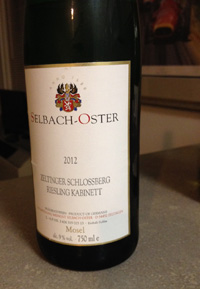 2012 Weingut Selbach-Oster, Riesling, Zeltinger Schlossberg, Kabinett, Mosel, Germany.
2012 Weingut Selbach-Oster, Riesling, Zeltinger Schlossberg, Kabinett, Mosel, Germany.
A beautiful Riesling, the 2012 Selbach-Oster Zeltinger Schlossberg Kabinett is a showcase of detail, history and class with exotic tropical touches including mango, passionfruit and pineapple along with green apple, lime and vibrant salted citrus. This vintage is really a near perfect year with fantastic fruit clarity and vivid acidity, mineral force and a dreamy texture. The drive and vigor point to impeccable winemaking and high quality terroir, a historic terroir and the structure will allow great cellaring rewards, as well as making for a wine that can be drunk young as this wine proves even now. A subtle sweetness and a delicate floral perfume shines throughout, though there are savory elements, sea (briny) essences and basil, and white tea notes too, the Schlossberg finishes with a wet stones and a creamy peachiness that begs for another sip, this is gorgeous Riesling, drink from 2014 to 2024. Johannes Selbach and his team has crafted a majestic set of wines with the 2012 vintage and they will continue to dazzle on the world stage for many years to come.
($30 Est.) 94 Points, grapelive
2012 Selbach-Oster, Riesling Zeltinger Schlossberg Auslese (0ne Star) Mosel, Germany.
Johannes Selbach’s weightier Rieslings are majestic wines, some of the finest white wines in the world, and I look forward to trying some of the single block rarities like the Andrecht, but while those are extremely limited and more costly, this beautiful 2012 Zeltinger Schlossberg Auslese will be a slightly easier treasure to acquire when released this fall (2013) and it is a stunning Riesling in it’s own right. This one star selection, I tasted recently and while young, shows amazing class and depth all ready, and it is remarkably well balanced and doesn’t feel overly sweet, even though it is an Auslese, and it is full of complexity and focus. The nose is bright and fresh with crystalline mineral, white flowers and stone fruits leading to a full and generous palate of peach, pineapple, tangerine, apricot and key lime, while there is briny sea breeze and saline, tropical essences, candied pear and cool slate stoniness. This wine is powerfully dense, but filled with acidity and vibrant intensity, without question one of the top cellar choices of the vintage, so be sure to make note to look for this fantastic wine, and be rewarded short term and especially long term, drink from 2014-2022. Selbach’s 2012 vintage looks set to join his long line of legends and rivals even the great 2005 wines, but don’t over look 2009 and 2011 either as they also provide glorious drinkability and are worth extended aging as well, that said these 2012’s are very very special.
($38 Est.) 95 Points, grapelive
2012 Selbach-Oster, Riesling Zeltinger Schlossberg Spatlese Mosel, Germany.
Classical styled and remarkably pure the 2012 Zeltinger Schossberg Spatlese is a great candidate for cellar building with wonderful depth and structure and stunning potential for future rewards. While beautiful and charming even now, this wine has much more to come and is really worth investing in with everything in store to give massive drinking pleasure both short term and long term. The nose is still evolving and shy needing a lot of coaxing to reveal much, but there is a hint of spring blossom and smoking mineral tones with a touch of sea salt leading to a very gripping and balanced palate, while a Spatlese it feels more dry than sweet at this stage with plenty of zing and vibrancy. The mouth is an explosion of citrus, tropical fruit and creamy white peaches with a crystalline essence of rich minerality. The is a nice briny earthiness and saline quality to this fine Riesling and the touch of sweet papaya lingers on and on. This appealing and compelling white is a star in the making, best to show patience, drink 2016-2025, if you can of course, even with my best intentions I can’t always resist these Selbach-Oster Rieslings in their youth, and these 2012’s look to be legendary, be sure to get some later this fall when the arrive in the states.
($28 Est.) 93+ Points, grapelive
2012 Selbach-Oster, Riesling Zeltinger Sonnenuhr “Ur” Alte Reben Mosel, Germany.
This Riesling from 100 Year Old Mosel vines in Zeltinger Sonnenuhr is a touch off dry technically, but is wonderfully dry feeling and is a marvel of precision and balance. Selbach’s selection of ancient vines and deft touch shows in this finely detailed wine that has both grace and underlying power and intensity with salty minerals, extract and lazar like focus, and amazing potential. The hint of sweetness adds a subtle touch of lush luxury to this classy Riesling and gives a hint of creamy mouth weight while remaining vivid and vibrant throughout. The nose is still a bit closed, though crushed stones, mint leaves, white flowers and grapefruit show, before a lively palate of green apple, peach and lime fruit, sea salt, chalk and tropical essences. A clean and fresh Riesling with glorious character, the 2012 Selbach-Oster “Ur” Alte Reben ultra old vine finishes with tangerine and tangy apricot plus a burst of energy, this is fantastic stuff, don’t miss it when a tiny amount is released this Fall (of 2013) and while it will drink great young, it should age well, Drink 2014-2024.
($32 Est.) 93-94 Points, grapelive
2012 Selbach-Oster, Riesling Zeltinger Schlossberg Spatlese Trocken (one star) Mosel, Germany.
Johannes Selbach’s dry Spatlese wines are truly special in this vintage, the Mosel was blessed with an amazing vintage in 2012 for a full range of Rieslings, there is greatness from each level and while there maybe a lack of TBA and Icewine, the quality of the Trocken, QbA, Kabinett, Spatlese and Auslese is outstanding, and especially the Spatlese Trocken. While, I admit I adore the slightly sweet regular Spatlese from Selbach-Oster, I must say the Zeltinger Schlossberg Trocken is a fine example of the dry style, and even I personally like the Zeltinger Sonnenuhr a bit more, this is an amazing wine of class and nature with lush texture, extract and brisk acidity. The nose is full of mineral tones, spicy slate essences, hints of tropical fruit and white rose leading to a tangy palate of sizzling intensity with tangerine, grapefruit, dried pineapple, mangoes and lime, plus hints of apricot and green apple, briny saline and peach pit. The dusty minerals coat the mouth and a spicy element lingers on the crisp and clear finish, drink from 2014-2017.
($30 Est.) 93 Points, grapelive
2012 Selbach-Oster, Riesling Zeltinger Sonnenuhr Spatlese Trocken Mosel, Germany.
This is the real deal, without question this should be a Grosses Gewachs (Grand Cru) with it’s power, grace and extract this wine is utterly mind-blowing, a dry Riesling for the ages. This wine might be a game changer, with it’s pure Mosel character, focus, drive and depth it goes beyond what I’ve experienced in Mosel Trocken, this is glorious wine and a top cellar choice, if you can find it of course. I freely admit I’m a huge fan of Selbach’s wines and have been for ages, but honestly I can’t remember a better dry style in previous vintages than this 2012. The single block collection wines might be more of everything, weight and potential included, but for the money, it is hard to imagine a better dry Riesling from the Mosel than this. The 2012 Zeltinger Sonnenuhr Trocken Spatlese starts with heady bouquet, it is more expressive at this stage than the Schlossberg, with white flowers, tea spices, tropical essences and flinty minerals leading to a lifted palate of lime, papaya, orange and apricot fruits with chalky wet stones, bacon fat, sea salt and grapefruit seeds adding savory notes to the bright freshness of this gripping Riesling. A huge explosion of secondary citrus, green apple and peach flow from the mid palate to the tangy finish that leaves a lime and pineapple aftertaste. This vivid and vibrant wine impresses for the expansion of flavors in the mouth, the vigor of it’s acidity and the density of the extract all coming through in a well judged fashion, this artisan crafted wine is pure, round and exciting throughout and should drink fantastic for the next decade or more, if you are looking for a dry Mosel, this is a wine to search out.
($30 Est.) 95 Points, grapelive
Nahe Germany
2012 Weingut Donnhoff, Riesling, Estate, Nahe Germany.
Certainly, you cannot find many QbA Rieslings as good as this Donnhoff, there is just no question, especially this years edition, as 2012 is proving to be a fantastic vintage. I missed this wine at the pre arrival tasting in June of 2013 in San Francisco, where I got a chance to try most of the significant offerings from the wonderful Terry Theise portfolio, so I was thrilled to be able to taste it this weekend, and it did not disappoint, it is a lovely and mostly dry style with just a touch of sweetness, about normal Kabinett level in feel. This remarkable 2012 Donnhoff Estate Riesling makes for a compelling wine and again a super value, this is quality stuff, with floral and tropical essences, tangy lime and peach fruit, steely minerals and creamy rich finish, but with brisk and vibrant acidity. This charming and pure wine has a touch of apricot, tangerine, basil, sea salt and wet stones as well, plus some juicy green apple. The off dry feel plays well, making for a bit of fleshy texture, this is a very pleasing and refreshing wine. The 2012 Donnhoff Estate Riesling is almost a must wine, if not a must have a case wine, it is that good and it is perfect for Asian food, picnics and well, almost time, and it should drink great for a decade!
($26 Est.) 92 Points, grapelive
2012 Weingut Donnhoff, Riesling, Estate Trocken, Nahe Germany.
This 2012 Dry Estate Riesling is clearly and most definitely a baby Grosses Gewachs (Grand Cru) and shows amazing drive and quality throughout, this is a steal, don’t even think about it, get yourself a case or two! Donnhoff is one of Germany’s great wineries and without question these 2012 vintage Rieslings are going to be highly sought after and prized, and this Estate Trocken is just plain gorgeous and very entertaining. The nose is slow to get open at this stage, but with coaxing it delivers white flowers, hints of rose petals, mint leaves and steely mineral tones along with orange and stone fruit leading to an electrically charged palate of sizzling intensity with bright lime, green apple, peach and tangerine along with subtle tropical notes, wet stones, flinty mineral spice and tangy nectarine. The acidity is fantastic, lighting this wine up while allowing dense extract and fleshiness to show through, and I bet this little Grand Cru will age well, it should develop and gain greatly over the next decade, bravo, this is an impressive gift to us Riesling fiends. The crisp and clear finish is mouth watering with a briny saline note and a round creamy element settles in on the aftertaste, simply stunning, this rivals Premier Cru Chablis for class easy.
($25 Est.) 92+ Points, grapelive
2012 Donnhoff, Riesling Tonschiefer Trocken, Nahe Germany.
Another fantastic wine from Donnhoff is the Tonschiefer Trocken Riesling, it is a real classy effort that brings intensity and vitality to the table, but in a graceful and purpose filled fashion with an amazing mineral/steely core and perfectly judged acidity. The fruit is tangy fresh with lime, yellow peach, mango, bitter apple and green melon along with chalky stones, briny sea salt and spicy herb notes. There is a subtle bouquet of citrus blossoms, smoky flint and tangerine essence that lead into the palate, and the crisp, dusty dry finish leaves an electric buzz of acidity, but a lingering hint of creaminess. This is sublime Riesling and a mega deal, be sure to look for this wonderful Donnhoff, in the US, again look for Theisse Selections for it, it should be hitting the shelves in Oct or Nov of 2013. With out question this wine is a class act, even now, but patience will be rewarded and you should look to putting a few bottles away, drink 2014-2020. Weingut Donnhoff is serious one of the greatest wineries in the world, if you’ve not tried their wines you are missing out, from top to bottom this wines rock, especially the 2007, 2009, 2011 and 2012 vintages!
($27 Est.) 94+ Points, grapelive
2012 Donnhoff, Riesling Hollenpfad Trocken, Nahe Germany.
Donnhoff’s outrageously good Hollenpfad Trocken is a suave and sexy Riesling that delivers everything on promise and on the palate. While not a Cru, Grosses Gewachs, the Hollenpfad could easily be, this is a dry style marvel with great depth, extract, detail and class no question, and with many happy years ahead of it. The 2012 Hollenpfad Trocken lifts off with lime and tropical essences with a tangy mouth of mango, briny sea salt, chalky mineral, multi-citrus and peach fresh with more stone fruit, melon, apple skin, spice and apricot. The acidity is on vibrant display, but everything is remarkably balanced and elegantly focused, especially for such a young wine, this is pure genius and I can’t wait to try it again down the road, look for this in the states in the late fall of 2013, this we be a real treasure in the cellar.
($43 Est.) 93-94 Points, grapelive
2012 Donnhoff, Riesling Felsenberg GG (Grosses Gewachs), Nahe Germany.
Donnhoff’s amazing dry Grand Cru Felsenberg is one of the world’s great wines, forget white or red, grape, anything, this Riesling is as good as it gets, rivaling any wine from anywhere. While the last few vintages, especially the 2009 and 2011 which are stunning as well, this coming release, the 2012 Donnhoff, Riesling “Felsenberg” Grosses Gewachs (GG) Nahe, Germany is going to surpass prior efforts, this is a white that compares or blows away the top wines of the Cote de Or or Hermitage! While this Riesling might not seem cheaply priced, I can assure you it certainly is when you taste it and understand it’s qualities, this is a thrilling and classic wine, still very primal and what you’d call an infant, but the making of a legend are all ready unfolding. The bouquet takes some time to open, but the essences are clear with apple skin, spiced pear, lime flowers and crushed stones with a touch of cream and sea brine, this leads to a intensely striking palate of brisk and firm bee of acidity with lime, white peach, mango, tangerine and dried apricot. Tangy stone fruit pit, saline and chalk add to this mineral laced white, while a medium textured feel comes through, everything is precise and fantastically focused in this crisp and persistent Riesling, and is often the case when writing about wines like this, words just fail to due justice, this is awe inspiring wine with jaw dropping potential, drink 2018-2024.
($70 Est.) 96 Points, grapelive
2012 Donnhoff, Riesling Kreuznacher Krotenplahl Kabinett, Nahe Germany.
This elegant Kabinett has it all, and while still subtle and classy in character it maybe the finest vintage I’ve ever tasted of this wine, and anyone looking for a German classic need look no further. This clever Riesling shows a clarity that is like looking into the soul of Donnhoff, this pure and spiritual wine is nothing short of stunning with a light hearted sweetness, but with ultra serious character, this graceful Riesling plays with you, toys with your senses and seduces completely with flowery citrus, dried pear, candied apricot and tangy apple teases, zest acidity and dusty stones. The palate expands and includes pineapple, guava, white plum and a core of white peaches plus a savory side that balances the sweetness perfectly, briny sea salt, hints of minty tea and striking mineral tones. Don’t you dare miss this great vintage, it would be unthinkable not to have a few of these in your cellar, if you could be patient, the rewards are going to be heavenly.
($27 Est.) 94 Points, grapelive
2012 Donnhoff, Riesling Normeimer Kirscheck Spatlese, Nahe Germany.
The Normeimer Kirscheck Spatlese is the most overt, extrovert and flamboyant of the 2012 Donnhoff wines, it is openly sexy and flaunts it throughout, and I must admit, I’m totally comfortable with that! This inviting Riesling is no tease, it gives you it’s all and then some, it doesn’t require lots of foreplay either, this is easy to love and energizing wine with great vigor and lusty flavors. The nose is slightly floral and tropical with a hint of sultry earth and spice before a full and fleshy mouth that kisses deep with energy, there is raw honey, mineral and tangy stone fruit layers held firm by bright acidity. There’s green apple, yellow peach, passionfruit and lime layers as well as sugared plum, tangerine and kiwi notes. The finish is remarkably long and the aftertaste is of oranges, sweet flowers and liquid minerals with a element of saline and seaweed. Ultra fantastic and glowing wine, proving a noticeable sweet wine can rival the worlds best whites, Donnhoff again has delivered a masterclass of great wines in 2012 and this beauty is a must have for short and long term drinking pleasure, this is a 20 year wine no question.
($43 Est.) 95 Points, grapelive
2012 Donnhoff, Riesling Oberhauser Brucke Spatlese, Nahe Germany.
The 2012 Brucke Spatlese is reserved and is like a museum piece, it just might be my favorite Spatlese ever, it is just outrageously fabulous, even if it is more understated than it’s cuisine like the Normeimer Kirscheck. This graceful and joyous Riesling flows in a creamy and more austere fashion with subtle perfume, elegantly integrated acidity and sweet tannins, but don’t let that fool you this is a wine for the ages, I wouldn’t doubt a 30 year lifespan with pleasure given until the very end. This classic and statuesque wine is like having the Hermitage museum in your glass, it is a true masterpiece, and certainly words will not begin to due justice here, I just beg you to get a few bottles, especially if you are a real Riesling junkie! The nose is slight still with hints of rose petals, citrus blossoms and sea breezes leading to a crystalline palate of white peach, apricot flesh, wet stones, apple skin and honeyed pear while in the background you find almost cherry notes and briny saline along with steely mineral essences. With air the texture fills out, the cream nature comes through, but everything is held firm with acidity and earthy elements. A classic beauty, the Oberhauser Brucke Spatlese is simply one of the best wines in the world.
($55 Est.) 96 Points, grapelive
2012 Kruger-Rumpf, Scheurebe Spatlese Nahe Germany.
Georg Rumpf’s brilliant 2012 Scheurebe is one of the most exciting wines of the vintage, and maybe the ultimate example of this grape, it is simply magic in the glass. While a Spatlese, this wine neither feels or tastes cloying in any way, but rather divinely balanced with wonderful vibrancy and class. The nose is the most perfumed expression of Scheurebe I’ve ever encountered with delicate jasmine, honeysuckle and orange blossom, it is mind-blowingly seductive, but still restrained and refined. The palate is medium weighted with extract and hints at density with beautifully lifted and vibrant fruit, lemon, melon, nectarine and honeyed pear all playing parts. Nice light mineral essences and tropical notes shine through as well, and while everything flows smoothly, there is plenty of vigor and life here, and a refreshing salt lick and crispness come through on the finish with the faints of sweetness lingering. This is a fantastic white wine, coming this fall (2013) and should not be missed, drink 2014-2018.
($26 Est.) 93+ Points, grapelive
2012 Kruger-Rumpf, Riesling Munsterer Pittersberg Auslese Nahe Germany.
Georg Rumpf’s fantastic 2012’s deserve a lot of attention and high praise, especially this amazing Auslese, maybe one of the best I can remember and utterly drop dead gorgeous with sublime balance and detail already. This is a wine for the ages, though very versatile in that it could be enjoyed young and in fact could partner up with certain cuisine choices right now with it’s youthful freshness, but without question there is more magic to come with time and the rewards for cellaring a few of these would pay huge dividends. The 2012 Pittersberg Auslese starts with a lovely almost delicate bouquet of lime blossom, ripe nectarine, candied pineapple and steely liquid minerals leading to a lush palate of peach flesh, apricot, papaya and sweet tangerine with subtle savory notes, sea breeze and verbena. The seductive tropical essences, mandarin oranges and honeyed pear elements only flitter in the background and the bright acidity makes everything feel dream like and surreal, though there is plenty of weight and extract to fill the mouth with luxury and hedonism, this is a profound Riesling of terrific class and character, not to be missed, don’t be afraid of the sweetness this wine is all about grace and pleasure.
($60 Est.) 95 Points, grapelive
2012 Schlossgut Diel, Riesling Nahesteiner Trocken, Nahe Germany.
Diel’s gorgeous dry Nahesteiner Riesling is bright and vigorous with loads of extract, mineral notes and gripping acidity, without question this one of the great steals in Trocken for the vintage. The 2012 Schlossgut Diel Nahesteiner Trocken starts with fresh orange blossom, sea breeze, chalk dust before a palate of lime, yellow peach, dried apricot and grapefruit essence with hints of river rock, apple, iodine, flint and lemon oil. This steely Riesling is intensely lively with a real kick of acidity, but everything folds together nicely, balanced and focused all the way, even a roundness in the mouth comes through, and there’s a good length to the citrusy finish. Diel’s dry wines are all refined, tasty, crisp and full of flavor and class, especially this Nahesteiner, be sure to get your hands on some when it comes out later this year, drink 2014-2020.
($28 Est.) 93+ Points, grapelive
2012 Schlossgut Diel, Riesling Dorsheim Trocken, Nahe Germany.
Diel nailed it in 2012, and one of my favorite wines in their exceptional lineup is the beautiful and vigorous Dorsheim Trocken, this is a vibrant and intense Riesling of pure class, style and persistence. The 2012 vintage is one of the best years to invest in Germany Riesling across the board, but it is especially true of the dry wines, and Diel is one of the masters of this niche, these are wines of good extract, acidity of course, and amazing life and detail. Diel’s Dorsheim Trocken is a great example of this style and a wine that will reward time in the cellar, it gives amazing quality and while still way too young it delivers stunning character all ready with super depth and grace. The nose is shy, there is a lot more to come here, but with coaxing there is some white flowers, dusty stones, essences of the sea, briny elements and steely minerals with hints of basil and stone fruits leading to a palate of white peach, green apple, grapefruit and a juicy core of mouth watering lime. There are notes of green tea, mint and loads of saline as well in this tight and brisk Riesling, but certainly a few years in the cellar will be massive rewards, the results are something to look forward to, no question.
($36 Est.) 93 Points, grapelive
2012 Schlossgut Diel, Riesling Kabinett, Nahe Germany.
The normal Diel Kabinett certainly deserves mention, it is a slightly sweet style that while feeling plenty dry has a bit more refreshing creaminess that the trockens, and I can honestly say it delivers the goods, this very complete Riesling is a charmer. I find it impossible to really call this, or many Kabinett level wines “sweet” I mean this is a pretty and stylish table wine, this is not a dessert wine or even as sweet as many California chardonnays in perceptual cloyingness. This wine is less severe that a trocken and more caressing on the palate, but still serious and highly pleasurable. This wine is perfect for low alcohol fans, picnics and medium spicy Indian or Asian cuisines. As I have mentioned a few times, the 2011 and 2012 Germany wines do tend to favor some of the dry styles, but do not overlook the great other wines of these vintages, especially Kabinett and Spatlese from the best producers, like this lovely Schlossgut Diel Kabinett that shows tangy peach, tropical essences, apple and fleshy apricot along with creamy lime, kiwi and nectarine. There is also a steely edge here with a driving force of acidity, plus mineral, wet stones and mint leaves that add to the complexity and balance in this finely tuned white. The finish is bright with an aftertaste of sea salted honey, verbena white tea and tangerine tanginess, this is a class act, drink 2014-2020.
($30 Est.) 92+ Points, grapelive
Pfalz Germany
2012 Muller-Catoir, Riesling Trocken, Pfalz Germany.
Even the basic Riesling Trocken by Muller-Catoir is a stellar wine, and a steal, be sure to look for these 2012’s, they might be rare on the shelves, but certainly worth the search. Not too long ago, it was common wisdom that for dry aromatic Riesling you looked to Alsace France, but that no longer applies in the wine world as we discover the magical dry Riesling of Germany, and especially Muller-Catoir of the Pfalz, if you’ve not had these wines this is a great time to start, though be warned, you will become addicted to them! The Muller-Catoir Pfalz Trocken is a fine Riesling with lifted flavors, floral notes and wonderful steely presence with citrus fruit, sone fruit and a dusty chalky finish. The palate includes lime, tangy nectarine, orange and white peach elements, along with wet stones, white tea and sea salt. This wine feels zesty and almost sizzling with energy, it is light and fine in character, but shows good persistence in the middle and cooly crisp on the finish, drink over the next 3-5 years.
($25 Est.) 91 Points, grapelive
2012 Muller-Catoir, Riesling Burgergarten Trocken, Pfalz Germany.
I believe the first vintage of Muller-Catoir I bought was the 1997, and I’ve been a fan ever since, these Pfalz wines are some of the finest white wines made and the 2012 vintage is a stellar year for this great domaine. While I can’t stop babbling on about Muller-Catoir’s fantastic Muskateller, it is there dry Riesling wines that take center stage in this latest set of releases, especially this magical 2012 Burgergarten Trocken. This is serious wine for serious wine lovers, intense and noble with transparent clarity and real purpose, the Burgergarten is a pure Riesling expression from it’s place, the sandstone soils, exposure and deft winemaking. The 2012 Muller-Catoir Riesling Burgergarten Trocken is vigorously steely and stingingly dry with spritzy vibrancy throughout, there is white flowers, salty brine, tangy peach, pear and green apple with a core of cool lime, plus hints of grapefruit, apricot pit and chalky wet stones. The finish is mouthwateringly dry and zesty, but there is lingering impressions of rosemary, mint and tangerine. This is ultra Riesling, maybe not a Grand Cru, but certainly it has it all if not in name, this wine is looking good to be in my top ten best of the year, bravo, drink 2015-2022.
($55 Est.) 95 Points, grapelive
2012 Muller-Catoir, Muskateller Haardt Trocken, Pfalz Germany.
If you ever want to know how serious dry muscat should taste, then you must try Muller-Catoir’s Haardt Muskateller, in fact if you what to try one of the world’s most beautiful wines then you should sample this fabulous white from the Pfalz. The 2012 is one of the finest examples of this wine I can remember, and I’ve lusted after this wine since first trying the 1998 vintage, and there is no doubt this will be in my ten best whites of the year. The 2012 Muller-Catoir Haardt Muskateller has a wondrous perfume of star jasmine and citrus blossoms along with spice and river stones leading to an ultra dry and light-medium bodied palate of lime, crisp green apple and white peach with chalky mineral essence and juicy acidity through out. This brisk and delicate wine marvels the senses and is pure class from start to finish, this wine is totally captivating and the most dynamic expression of this grape I’ve tasted to date. I can’t wait to try this again, it will be released in the fall of 2013.
($40 Est.) 94+ Points, grapelive
2012 Muller-Catoir, Riesling Haardt Trocken, Pfalz Germany.
A classic dry Catoir, tangy, detailed and pure, this is a near perfect vintage for this fabled estate, this set of releases takes Muller-Catoir back to the very top and this Haart Trocken is stunning stuff. The 2012 dry Haart is bursting with energy and intensity, it makes your palate tingle and set your senses alight with an almost stick your tongue in a light socket shock, this is bright and sizzling steely Riesling. The nose is saline filled, mineral charged and citrus laced with hints of chamomile, lemon zest and brine leading to a lifted palate of dried mango, grapefruit, lime and white peach fruits with hints of green tea, white currant and tangerine. The texture is light and chalky and there is a real wet stone element throughout leaving a long aftertaste of mineral spice and apple skin. Give this wonderful Riesling a bit more time to delevop and reap the rewards, drink from 2016-2021.
($33 Est.) 94 Points, grapelive
2012 Muller-Catoir, Riesling Mussbach Kabinett, Pfalz Germany.
This little Kabinett from Catoir is off the charts! The slight hint of sweetness is positively outstanding in this lovely wine, making it really pop and gives the wine tremendous flexibility and refreshment, this is glorious Riesling that will shine with almost any cuisine, especially Asian fusion fare and or pork dishes. The 2012 Muller-Catoir Riesling Mussbach Kabinett is a bright and vibrant white that shows an array of lively flavors and is mostly dry with plenty of sizzling acidity and has loads of charm. The nose is again pretty shy, as young rieslings tend to be, but does show orange blossom, hints of earth and sea, touches of tropical essence and sweet tea leading to a firmly crisp palate of lime, mint leaves, yellow peach, honeycomb, sea salt, brine, pineapple, apricot and a hint of apple flesh. You can notice the slight creaminess the touch of sugar adds, though you’d be had pressed to think of this beautiful wine was anything other than dry. As much as I love the totally searing Trockens, it is impossible not to adore this near perfect example of Kabinett, bravo, drink from 2014 to 2022, utterly gorgeous.
($36 Est.) 95 Points, grapelive
2012 Von Winning, Riesling, Deidesheimer Paradiesgarten, Trocken, Pfalz Germany.
Von Winning’s dry Rieslings are a revelation and are easily some of Germany’s most interesting wines, especially the three Grosses Gewachs (Grand Crus) each of which is dynamic and totally unique, but their med range Trocken (Dry) wines are not to be overlooked, like this Cru Paradiesgarten which is extraordinary in 2012. The upper Crus see more new French oak and rival Grand Cru white Burgundy, while the middle and lower wines are more about pure fruit essences and are subtler expressions, though non the less impressive, these wines are all sublime and offer amazing quality and character. The 2012 Von Winning Paradiesgarten is a forceful and firmly structured wine, but also is classy, elegant and charming with orange zest, white roses, verbena and mango to lead, before revealing intense lime, chalky minerals and grapefruit on the palate with touches of mint, briny saline and peach pit. This vigorous Riesling sizzles with energy and excitement throughout and the mid palate really kicks you with a burst of citrus, though the finish picks up a creamy note and the length is impressive for such a baby wine, for sure patience will be greatly rewarded here, and while not as hedonistic as Von Winning’s upper Crus, this certainly is an entertaining Riesling of fine details, excellent winemaking and a extremely well priced wine that should be a serious cellar contender for anyone looking for value, I know I’ll be picking a few of these up this fall when released.
($44 Est.) 93+ Points, grapelive
Rheingau Germany
2012 Weingut Spreitzer, Riesling “303” Oestricher Lenchen, Spatlese, Rheingau Germany.
This is Spreitzer’s signature classic Rheingau, and a thrilling expression of style and terroir with dynamic flavors, density and lush charms, while remaining balanced and focused throughout, this feels as weighty as ever, but in fact tastes drier than the 2009, 2010 or 2011 wines, echoing my my balanced comment. This is a powerhouse wine with a velvet cover, lovely and unique with yellow peach, mango and candied pineapple adding to the core of apple and zesty citrus fruitiness. The extract level feels high and there is a certain creaminess that is impressive too, but there is loads of zing and vibrant acidity along with a savory earthy loam character with hints of brine, sea salt and wild herbs. Wonderful length, especially in a young wine, there is massive aging potential here, fantastic effort, definitely a cellar selection.
($48 Est.) 93-95 Points, grapelive
2012 Weingut Spreitzer, Riesling, Wisselbrunnen Grosses Gewachs, Rheingau Germany.
The newly elevated Grand Cru Wisselbrunnen is one of the star dry wines of the vintage in the Rheingau and the Spreitzer family can really be proud of the majestic and powerful effort that is this wine, this is what all the buzz is about in modern dry German Riesling and right up there with some of the stars doing top echelon dry wines like Leitz, Donnhoff, Diel and others, this is a class act no question. Both the 2012 Grosses Gewachs I sampled this summer are stunning wines, it was hard to pick a favorite here, but in the end the flamboyant Wisselbrunnen got the nod, it is a massive and impressive wine with tons of dry extract and raw intensity, though some patience will be required here, it is another wine that should see a bit of cellaring. The nose has dried apricot, lime and smoky mineral essence with a full force palate of stinging acidity, earth and stones with loads of tangy fruit. Layers of lime, tangerine, white peach and pear all flow across the palate with a brisk dry sense of salt and spice finishing with length and lift. Drink 2014-2020, be sure to make note of Spreitzer’s Grosses Gewachs (Grand Crus) these are brilliant dry wines of charm and character.
($36 Est.) 93-94 Points, grapelive
2012 Weingut Spreitzer, Riesling, Winkeler Jesuitengarten Kabinett Halbtrocken, Rheingau Germany.
The sleeper in the Spreitzer lineup is the Winkeler Jesuitengarten Kabinett, this easy to enjoy Riesling does everything right and is very lovable right out of the bottle, but is serious in quality, it shows off this loess and loamy soil terroir well. Brightly fruited, entertaining and classy, the 2012 Spreitzer Kabinett is a joy with peaches, apple and tropical fruits leading the way, along worth hints of grapefruit, lime and saline coming through. Look for a bit more aromatics by this fall when it’s released and the touch of sweetness really makes for a pure and refreshing Riesling to be enjoyed over the next three to five years, though I expect it should age well for a decade at least. This playful and interesting Riesling is great first step into understanding the estate and terroir, be sure to check it out, and if you see 2009 or 2011 versions, snap them up too!
($22 Est.) 91+ Points, grapelive
2012 Eva Fricke, Riesling QbA, Rheingau Trocken, Germany.
Fricke’s 2012 dry Rieslings are stunning wines, but very tight, these are a set that will be best enjoyed with some age and cellar time, this patience will be rewarded greatly, though the basic Rheingau Trocken is starting to come out of it’s shell. The 2012 Eva Fricke Rheingau Trocken is a fine and unique Riesling of hand crafted charm and character with mouth watering acidity, tangy fruit and filled with mineral spice and saline. This intense wine starts with lime and mint, citrus blossom and sour peach and wet stones, the palate opens to apple, stone fruit flesh, flint and sea salt, this is a brisk, firm and vibrant Riesling that has a good long life ahead, best from 2015 to 2020, though being the Riesling freak I am I’ll be drinking it sooner I’m sure. This wine has lots going for it, but it certainly is severe and cooly focused, so if you are looking for a fruity style, best to look elsewhere.
($18 Est.) 92 Points, grapelive
2012 Weingut Leitz, Riesling “Dragonstone” Rheingau, Germany.
The Drachenstein is a lush and seductive wine of suburb quality and intensity with rich layers, but with loads of tangy acidity, this is an exotic wine and a great value. The 2012 edition is striking for it’s weighty feel, but dry crispness, this is a mostly dry style that has plush fruit and creamy texture, the unique Drachenstein site above the major Crus is from quartzite and slate soils, this is what gives the area it’s name Dragonstone, it is this terroir character that separates it from the schist and collared slate that makes up the premier Rudesheimer Berg vineyards. The Dragonstone keeps evolving and getting better and better each vintage, highlighting it’s personality, the Dragonstone has plenty of sweet peach, mineral essences, minty spices, saline (sea salts) honeyed fruits, bitter pit, apricot, apple and tropical fruits, plus there is hint of tart cherry water, tangerine and lots of limeade notes. With air the citrus elements gather strength and drive, but the mouth feel gets denser and coats the palate with a steely/stone dustiness, though everything is smooth and creamy. A hint of sweet and sour in the long aftertaste begs you to keep sipping, this is fantastic and fun Riesling that would go great with crab, smoked ham or Asian cuisines, drink now through 2021.
($18 Est.) 93+ Points, grapelive
2012 Weingut Leitz, Riesling Estate Rudesheimer Trocken, Rheingau Germany.
A bit more serious than his Leitz Out and a touch drier than Dragonstone, the Rudesheimer Trocken is a stunning value in Leitz’s all star lineup for 2012 and is a wine to stock up on for short to midterm drinking. Coming off vines from Bischofsberg, this bright and savory Riesling has plenty of extract and pleasing fruit to do the trick, this is a finely judged wine with a wonderful balance of sweet and sour elements. The nose is still a touch shy, but the palate is electric, charged up with vibrant lime, lemon and grapefruit while smoky mineral notes, peach, mango and saline add character. This charming wine has touches of earth, herbs and mint tea and after some air a tangy apricot aftertaste lingers. This is a friendly dry Riesling that is easy to enjoy now, but it should be at it’s best between 2014-2018, though I know I won’t wait to long myself.
($22 Est.) 91-92 Points, grapelive
2012 Weingut Leitz, Riesling Rudesheimer Magdalenenkreutz Spatlese, Rheingau Germany.
The Maggie Spatlese is always one of my favorite wines year after year, and while I couldn’t get enough of the 2009 and 2011, the 2012 is maybe even better still with plenty of lush extract, sweet fruit and loaded with juicy acidity, this is stunning wine at a stupidly fair price, I mean to say, this wine is a steal! Here is a classic example of why German Riesling is one of the best wine investments you can make, for a drinking cellar, putting a case away of this wine would pay off huge in terms of value and pleasure, especially as this wine has most likely a 15 to 20 year life ahead of it. I certainly will be signing up for some, putting my money where my mouth is, and I recommend getting on board the Riesling love train yourself. The 2012 Leitz Rudesheimer Magdalenenkreuz Spatlese leads with a heady bouquet, that needs coaxing still, of fresh cut roses, orange flowers and tropical essences with a firm streak of flint, spice and yellow fruit leading to a brisk palate of vivid crystalline citrus, mineral and fleshy stone fruit with mango, pineapple adding exotic character while smoky slate and salty essences add classic terroir. While a true sweetie, this Spatlese is pure class and balanced to perfection. Everything is here, everything is controlled and everything is delicious, bravo. The fall 2013 release can’t come soon enough.
($24 Est.) 94 Points, grapelive
2012 Weingut Leitz, Riesling Rudesheimer Berg Roseneck “Katerloch” Rheingau Germany.
Trying to pick of favorite of Leitz’s top dry cru wines is damn near impossible, honestly these are all unique and utterly fascinating wines that rival anything from anywhere, these crus just continue to get better and better and 2012 is one of the best vintages to explore these dry Rieslings from the hills above the Rhein River. Okay, that was a long sentence, but I’m sure you get the idea, Leitz Riesling is a bucket list wine and especially intriguing is the lovely and intense 2012 Leitz Riesling Rudesheimer Berg Roseneck “Katerloch” which is a fantastic example of German dry wine. This finely tuned Riesling bursts from the glass with smoky flint, red pepper spices and cool stone fruits, while the nose has white flowers and crushed stones the palate showcases the Roseneck terroir with full flavors of yellow peach, white currant, lime and powerful extract. This wine has total impact, force and firmness, a classic Riesling powerhouse and a wine of sublime character, this is a wine for the ages. Lingering apricot, mango and grapefruit add to the complete lustiness of this marvelous dry wine.
($42 Est.) 95 Points, grapelive
2012 Weingut Leitz, Riesling Rudesheimer Berg Kaisersteinfels, Terrassen, Rheingau Germany.
This staggeringly sublime wine is as good as it get in dry Riesling and this unique block high up in the famed Rudesheimer Berg, Kaisersteinfels is one of the great crus in this historic area framed by terrace walls, recently and painstakingly rebuilt. Having hiked up here in 2009, this steep site is extreme and gives amazing complexity with a near perfect mix of slate and quartzite soils that are highlighted in the wines with sheer transparent beauty and riveting details, it is no wonder why you hear “best Rheingau trocken” when you hear comments about this Riesling, both by experts and laymen tasters alike. Johannes Leitz himself thinks the 2012 is as good as it gets. The nose is intensely seductive with crystalline liquid mineral, smoky flint, tropical floral essences, citrus zest and salty sea breeze leading to a lime and yellow peach filling palate with plenty of sizzle and extract along with apple skin, apricot and tangerine notes, along with tangy mangoes and savory briny elements. This is beautiful and pure, a classic terroir driven wine of stunning presence and persistence, without a doubt this is going to be legendary, and patience with be greatly rewarded, drink 2015-2025, fantastic.
($55 Est.) 95+ Points, grapelive
August 2013
Family Winemakers of California Tasting Review
By Kerry Winslow
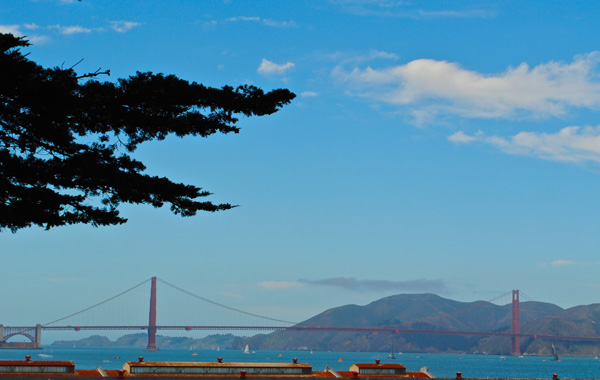
This year’s Family Winemakers of California tasting event was a good chance to taste some new wines, new vintages and meet some interesting people, plus get a pulse on how the wine business feels to those on the front lines. There seems to be a ways to go in the economic recovery, but there is promising signs and even hope in most people’s eyes that things are getting better and that is a brighter future ahead, though there was a lack of attendance by premier artisan Pinot Noir producers that I found very noticeable and troubling for this event, which is one of my favorite to visit and report on. That said, there was plenty to enjoy, great weather, super location at Fort Mason and many exciting wines to sample, all in all a very worthwhile show.
Here is my list of highlights from the Family Winemakers Tasting, these are the producers and wines that left the biggest impression on me and my palate, and while I tasted lots of very nice wines, and to be honest there was not many duds, I tried to only include those that offered that something unique or special. I wanted to include a good range of new and already established producers and regions. This is a wonderful state, and we have in California a fantastic array of terroirs, styles and the choices are almost endless, there is something for everyone here and this event highlights that to perfection.
Best New Winery: Law Estate Wines
I’m always on the trail of new discoveries and future specialties in the vast wine world, and at this year’s Family Winemakers Tasting in San Francisco, I managed to find an exciting new producer that looks set to compete with Saxum, Booker, Epoch and L’ Aventure for honors in the western hills of Paso Robles, Law Estate. Don and Susie Law have planted a glorious hillside vineyard between 1,600 and 1,900 Feet up on shiny limestone chock soils, mostly to Syrah and Grenache, but with some Cabernet, Mourvedre, Carignan, Tempranillo, Petite Sirah and Petit Verdot in black grapes and a few white grapes that include Roussanne, Marsanne and Clairette. The Law’s hired Scott Hawley to be their winemaker and leader, to make the wines and get an ambitious state of the art winery done and up and running, Hawley is known for making some very intriguing wines including his own wines at Torrin, as well as Jada and Alta Colina prior, he is also very much dedicated to sustainable growing practices. This fall Law Estate will releasing their first four wines from the 2010 vintage, all of which are stunning and all of which will certainly blow a few minds.
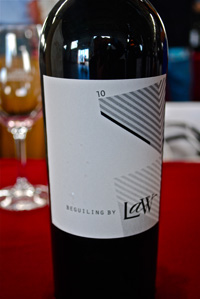 2010 Law Estate, Beguiling, Proprietary Red, Paso Robles.
2010 Law Estate, Beguiling, Proprietary Red, Paso Robles.
This Grenache cuvee, with a tiny amount of Syrah (94% Grenache & 6% Syrah) is lavish and lush with pure flavors and silky tannins, this is a delightful and throughly enjoyable wine. There is lots of lively layers to explore here with fresh fruit, floral tones and tangy grenadine on the aftertaste, the main drive though is a red fruit core that never stops pushing with loads of raspberry and baked strawberry leading the way. There is a spicy plum and pepper note that add to this fine effort, plus there is a shinning burst of acidity and hints of chalky mineral as well. This deeply colored red is very rich in the mouth and will satisfy most Grenache fiends addictions, this certainly reminds me of elements of Booker and Alban and pays tribute to the wines of the southern Rhone.
($62 Est.) 92-93 Points, grapelive
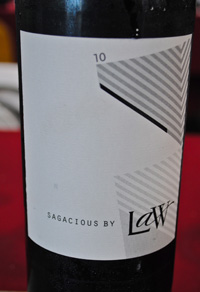 2010 Law Estate, Sagacious, Proprietary Red, Paso Robles.
2010 Law Estate, Sagacious, Proprietary Red, Paso Robles.
I especially liked the 2010 Law Estate Sagacious GSM blend of 44% Grenache, 42% Syrah and 14% Mourvedre, this was pure pleasure in the glass and I wish I could have gone off with a few bottles right there and then! The nose was young and tight, but it turned magical with air, violets, creme de cassis, white pepper and sticky lavender all flowed from bouquet to palate while blackberry, boysenberry, loganberry and blueberry compote exploded in the mouth and layers behind the scenes included sweet herbs, all spice, mineral and game plus a touch of espresso. This full bodied effort is flamboyant and utterly hedonistic, but not in anyway over the top or out of shape, this is well crafted and focused wine, and it should drink fantastic on release plus age well for another decade, this is deserving stuff, not cheap mind you, but after having the Saxum 2010 ($169) recently, and Booker ($89), plus others, this price point is very fair for the quality on offer here, no question.
($62 Est.) 94-95 Points, grapelive
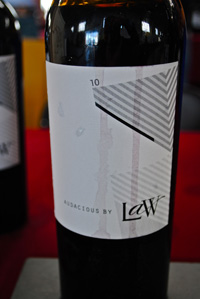 2010 Law Estate, Audacious, Proprietary Red, Paso Robles.
2010 Law Estate, Audacious, Proprietary Red, Paso Robles.
While the westside of Paso is home to some of the greatest Rhone inspired wines in California, there are those that get there clues from more than one region and there are a few that combine many ideas, like this almost Aussie meets Priorat influenced cuvee of 44% Grenache, 26% Cabernet Sauvignon, 20% Syrah and 10% Petite Sirah which all comes together in a most California fashion. The 2010 Audacious Red from Law Estate is super dark, brooding and full of explosive power, this is a wine to watch and while I quite like it now, it might be good to give this red some time in the cellar as it looks to be very rewarding, a solid investment in future pleasure. Certainly, as L’ Aventure’s Stephan Asseo has proved with his Estate Cuvee blend of Syrah, Cabernet Sauvignon and Petit Verdot, there is great promise in these kinds of blends and they can really show the nature and personality of the region. This wine is massive and forceful on the palate with loads of creme de cassis, blackberry, blueberry and juicy sweet plums along with dried currants, tobacco leaf, licorice and chocolate elements. Ripe tannins and subtle wood frame this wine very nicely, and the is great potential here.
($62 Est.) 93-94+ Points, grapelive
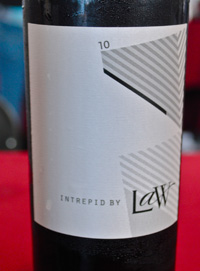 2010 Law Estate, Intrepid, Proprietary Red, Paso Robles.
2010 Law Estate, Intrepid, Proprietary Red, Paso Robles.
The 2010 Law Estate Intrepid is an intense 100% Syrah, the only one in their lineup this year to focus on a single varietal, but this wine lacks for nothing and is a very well crafted expression of this grape and place with lots of character and style. This gripping Syrah has eye popping fruit and almost a dry port feel to it, though I’m sure given time the wine will develop more graceful elements, I noticed air did open it up to reveal more complex details and there is plenty to enjoy here with it’s black and blue fruits, hints of peppery, sage and wild game. This wine leaves an impression, no question and I’m amazed by it’s depth coming from such young vines, this is a wine to take note of, I can’t wait to try not only this wine in a few years, but also to try future releases, this was the dark horse in the lineup, it might be a risk in the cellar, but I think it might be a good gamble. The nose has classic heady notes of sweet liqueur, smoke, salted licorice and meat along with loads of extract on the palate with blueberry, plum, kirsch and boysenberry fruit, plus hints of lavender oil, mocha and cracked pepper. For those that enjoy Alban and Saxum, you should be sure to look these guys up.
($62 Est.) 92-93 Points, grapelive
Best Up and Coming Winery: Donelan Wines
The future looks very bright indeed for Donelan, I was very impressed by the whole lineup of wines on offer by Donelan and the Brothers Tripp and Cushing Donelan that took me through their latest wines and developments, the Donelan family were partners in Pax, and started their own label after their split with Pax Mahle. This year they have added Chardonnay and Pinot Noir to their portfolio of wines, moving away from the Rhone only style, though they will keep making their Syrah based wines, mostly to their loyal mailing list clients as these wines are produced in limited amounts. Both their Chardonnay and Pinot Noir offering from the difficult 2011 vintage showed great, in fact the Pinot was utterly delicious and left me wanting more! I also tasted a barrel sample of their 2012 Chardonnay which was not in finished form and was from a single vineyard, but I can tell you it was spectacular and I highly recommend trying these wines and be sure to get on their list.
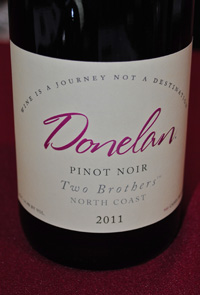 2011 Donelan, Pinot Noir, Two Brothers, North Coast.
2011 Donelan, Pinot Noir, Two Brothers, North Coast.
The 2011 Pinot Noir is a multi-region cuvee from sites in Sonoma County, Russian River and Mendocino, and while I tend to be a purist when it comes to Pinot Noir preferring single sites, this wine is glorious and is drinking great, I had to put my inner wine snob away and just enjoy this Pinots beauty and charm without prejudice. The nose is full of bright notes of fruit and flowers leading to a transparent, but deep palate of wilted roses, wild strawberry, plum and a rich core of cherry fruit, hints of cinnamon, pepper and fennel add complexity along with a fresh mineral streak. This vibrant and vivid Pinot is one 2011 wine not to fret about and while not cheap, is a lovely wine and very worthy of a splurge. Drinking well now, though should be a fun cork to pull for the next 3 to 5 years. Donelan’s Chards and Pinots are going to be some super wines to look forward to, especially the up coming 2012 vintage, so I’d suggest securing some of their wine sooner versus later. By the way, their Syrah wines are rockstars, be sure to check out 2009 and 2010 vintages as well!
($55 Est.) 93 Points, grapelive
Best Value Winery: Kaena Wine Company
Mikael and Sally Sigouin’s small Los Olivos winery is making some tasty Rhone wines from select sites in Santa Barbara and Santa Ynez, and all of them are sold at what has to be considered bargain prices for small lot artisan handcrafted wines. I’d had heard quite a few times I needed to check these wines out, but for whatever reason hadn’t had the chance to sample them, and now I really feel stupid for not getting to them earlier, these are wonderful and interesting wines of great quality. Mikael’s day job is crafting the excellent Beckmen wines, so he does know a thing or two, and I was impressed with his humble and laid-back nature, it makes sense as he is from Hawaii, hence the name and all. Mikael has been making Kaena since 2001, he has worked for Beckmen since 1999, but with a short stint at Fess Parker, becoming head winemaker at Beckmen in 2007. His Kaena wines all drink well, better than well, I should just say they all rocked, because they did, I particularly loved the Rose, the Sauvignon Blanc (the only wine in the lineup not a Rhone) and his 2011 Grenache Noir Vie Caprice from the Santa Ynez Valley, though I liked every wine he poured me, Kaena should be on your radar, these are top notch whites and reds.
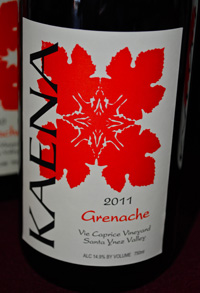 2011 Kaena, Grenache, Vie Caprice Vineyard, Santa Ynez Valley.
2011 Kaena, Grenache, Vie Caprice Vineyard, Santa Ynez Valley.
This wine is full of energy, life and soul, it may not be the richest or flamboyant compared with the 2010’s in Kaena’s lineup, and those are excellent, but I really just fell head over heals for the 2011 Vie Caprice Grenache which shows a more delicate nature, but still is wildly enjoyable. Like Sheldon’s lighter style Grenache, this wine is just sexy and pleasing with spice, acidity and layers of silky fruit. While 2011 won’t ever be regarded as a blockbuster, or even a remembered vintage, it did challenge winemaker’s to show their talents and Mikael has some, and this wine is the reward. The nose shows wild flowers, peppery spices and tangy red fruits with hints of earth, chalk and cinnamon stick leading to a palate of raspberry, loganberry, plum and strawberry with sweet fennel and herbs, peppercorn and tart cherry. I recommend buying up the 2009 and 2010 Grenache and Syrah wines from Kaena while you can, no question they deliver the goods, but also, grab a few of these, I really think you’ll be impressed, Drink 2013-2015.
($38-45 Est.) 93 Points, grapelive
Top Three White Wines
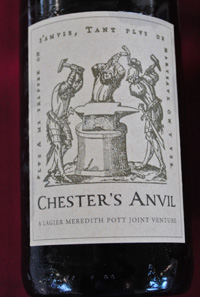 2010 Chester’s Anvil, Gewurztraminer, Potter Valley, Mendocino County.
2010 Chester’s Anvil, Gewurztraminer, Potter Valley, Mendocino County.
This wine is for all the wine weirdos out there that crave something different, something wild or truly unique, an off dry Gewurztraminer from Lagier Meredith & Pott Wines, this is super fun stuff and at a huge trade tasting, it stood out and I had to include it here in my top white picks! Carole Meredith, Steve Lagier and Claire and Arron Pott, neighbors and friends created a joint project to fuel their collective wine geek, that is Chester’s Anvil and they have made a collection of interesting wines together, their latest offerings include a Malbec, a Sauvignon Blanc and this wonderful Gewurztraminer. This tangy, bright and fresh white has a touch of off dry RS, but you don’t really get sweetness on the palate, so fear not, this is a refreshing table wine that offers an amazing array of flavors. The nose has a floral and tropical bouquet leading to a wild palate of lychee, melon and basil with tangy mango, pineapple and lemon, plus pepper and honeycomb notes. Crisp, but with a slight creamy feel mid palate this Gewurztraminer is great alternative white, and would be a dream with Asian cuisine and or most salads, don’t be afraid, this is groovy stuff.
($26 Est.) 91 Points, grapelive
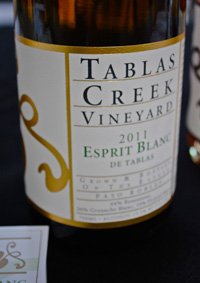 2011 Tablas Creek, Esprit Blanc de Tablas, Proprietary White, Paso Robles.
2011 Tablas Creek, Esprit Blanc de Tablas, Proprietary White, Paso Robles.
The Tablas Creek Esprit Blanc is a Roussanne, Grenache Blanc and Picpoul Blanc blend, an ode to Chateauneuf du Pape Blanc and Beaucastel’s glorious Roussanne based wines, and I think of it as one of the great white wines of California, it is a lovely and richly textured wine of utmost class and distinction. The 2011 shows a slightly lighter side than most vintages, but it is not a bad thing at all and I love the vibrancy of the fruit and the creaminess of the texture, it just plays well and makes for a balanced whole. This Roussanne led wine shows the intensity of this varietal with it’s hint of oiliness and that clarified butter note to go along with the citrus and stone fruits, while the acidity of Picpoul and complexity of the Grenache Blanc add mineral elements, fill out a peachy note and add to the life here. Tablas Creek maybe better known for their red, but without question this white rivals anything with loads of character, focus and seductive charms, it would be hard to imagine this wine needs anything more. The nose is subtle with hints of melon, pear, butterscotch and spices leading to a palate of white peach, nectarine, lemony citrus cream, a touch of wet stones. Beautiful and lush in the mouth and with a long clear finish this wine is world class, and it has good grip, but everything flows with smooth gracefulness, drink now through 2016.
($40 Est.) 93+ Points, grapelive
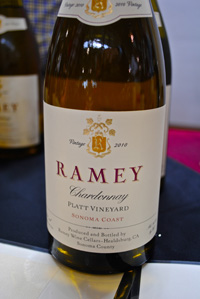 2010 Ramey, Chardonnay, Platt Vineyard, Sonoma Coast.
2010 Ramey, Chardonnay, Platt Vineyard, Sonoma Coast.
Dave Ramey nailed with this wine, the 2010 Platt is almost dead on perfect, this has to be one of the finest Chards I’ve had this year, and I will find it difficult to put into words just how good this wine is, so you’ll have to trust when I say, just try it yourself! While the Ritchie and Hyde Vineyard wines grab all the attention, it is this Platt that is more impressive, it is seriously fantastic, right up there with a top Puligny or dare I say a Batard, it is that good, it has it all and is a steal when compared to the great white Burgs it rivals, let alone the likes of Aubert, Kongsgaard or Peter Michael Chards. The 2010 Ramey Platt shows what a great vintage and site can do, it has a nose of white flowers, smoke, honeycomb and river rocks with a vivid palate of lemon, apple, pear and a hint of tropical fruit, firm acidity, chalky minerals and hazelnut notes. This Chardonnay is class from nose to finish with plenty of depth, length and laser like focus, without question this is pure class in the bottle, kudos to Ramey and his team, this is compelling juice and a fantastic wine, flirting with total perfection.
($55-60 Est.) 96+ Points, grapelive
Top Three Red Wines
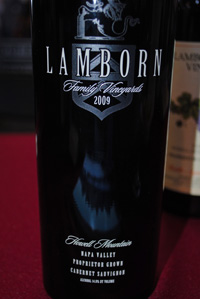 2009 Lamborn Family, Cabernet Sauvignon, Howell Mountain Estate, Napa Valley.
2009 Lamborn Family, Cabernet Sauvignon, Howell Mountain Estate, Napa Valley.
There are few small wineries that can say they have Heidi Peterson Barrett as their winemaker and ask this kind of price, it may seem odd, but yes this wine is a bargain, a tiny plot of Cabernet Sauvignon on Howell Mountain made by one of the great names in California wine, yup it is a steal. Better still, the Lamborn’s are great people, I’ve known them for a long time now, and they are true special and kind, I admire them greatly, and I have always been a fan. I used to buy a small production Zinfandel call Rocking Horse during the early nineties and one of their wines was from this Lamborn Vineyard on Howell Mountain, it was so different and interesting I just had to find out more, and then I discovered they made their own wine and I was hooked, and between 2001 and 2009 I didn’t miss a vintage of their Zinfandel which I found gave the same pleasure as a fine Chateau du Pape. As of the 2005 vintage, the Lamborn’s got into the Cabernet Sauvignon business, with Heidi calling the shots and developing the vines, with her experience and talents, of which most people know through her efforts at Screaming Eagle and other top estates, she has created a striking Cabernet for the Lamborn Family, a wine with terroir, personality and pedigree, and the 2009 looks set to considered the best yet. The 2009 Lamborn Howell Mountain Cabernet Sauvignon is a wonder expression of varietal and place with a nose full of acacia and dark flowers, sweet creme de cassis and spiced cherry leading to a full bodied palate of blackberry, currant and plum fruits with hints of mocha, licorice, lavender, blonde tobacco and smoky vanilla. Richly packed, dense and firm with ripe tannins this a jewell of a wine and the rewards of lots of handwork and commitment, drink from 2015-2022, bravo.
($100 Est.) 95 Points, grapelive
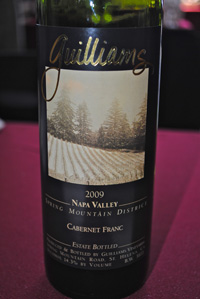 2009 Guilliams, Cabernet Franc, Spring Mountain Estate, Napa Valley.
2009 Guilliams, Cabernet Franc, Spring Mountain Estate, Napa Valley.
Guilliams has long been making quality Cabernet from their estate on Spring Mountain, and while they are known more for their Cabernet Sauvignon, they also craft a fine Cabernet Franc as well, and this 2009 is really lovely and very much worth spotlighting here. Guilliams also poured the 2007 Cabernet Sauvignon which was well made and extremely good, but I decided to focus on this 2009 Cabernet Franc, well, because I wanted to and that is was very interesting with lots of character. The nose has hints of violets and dried roses with hints of all spice and peppers plus a tease of creme de cassis before a refined medium weight, Bordeaux like palate of mineral driven fruit including dark cherry, plum and brambleberry with smoke, vanilla and wild herbs. There is a earthy element and touches of cigar, dried currants and cedar that really come into view with air, and the finish, which is lengthy and rich. This pretty Franc is drinking super now and should age another 5-7 years easy with it’s balance of fruit, tannins, wood and acidity, this is a classy mountain wine.
($36 Est.) 93 Points, grapelive
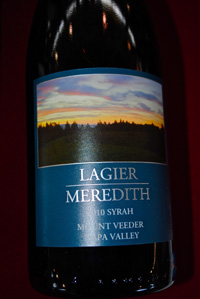 2010 Lagier Mededith, Syrah, Mount Veeder Estate, Napa Valley.
2010 Lagier Mededith, Syrah, Mount Veeder Estate, Napa Valley.
Steve Lagier and Carole Meredith have been making wine up on Mount Veeder since the mid nineties and while I had heard of them, I only first sampled their Syrah when I tried the 2004, and I was instantly a fan, and the 2005 was a magical wine, it left a mark on me for sure, they certainly produce wonderful wines. This years Family Winemakers tasting in San Francisco was a great chance to revisit their Syrah and the other wines in their lineup as well as get their expert insight into grape origins, with Dr Mededith being one of the world’s foremost researchers in the field, especially in the case of Zinfandel AKA Tribidrag and Syrah. Steve poured his latest samples, a Rose of Syrah with a touch of Mondeuse, the Tribidrag and the 2010 Syrah, but they he also brought out his 2002 Syrah, and wow, this was heaven, it was fresh and youthful with just a few signs of age, great stuff. But it was the new 2010 Lagier Meredith that blew me away, it was maybe my personal favorite of the show, though I must say it took me trying about 50 other really good wines to absolutely know just how remarkable it truly was, sometimes it is like that, putting things into context. The 2010 Syrah shows a deep opaque color, almost black in the middle with garnet edges and a nose of violets, huckleberry, creme de cassis, smoke and espresso bean leading to a full and robust palate of blueberry, boysenberry and mountain wild berry with touches of spiced plum, fig cake and cherry notes with pepper, cinnamon shavings, mint and vanilla. This beautiful and rich wines expands on the palate and the length is remarkable, this is special stuff, and while it drinks great now it should age with lots of style.
($48 Est.) 95+ Points, grapelive
More reviews to follow from this event on the main grapelive.com reviews page
A big thank you to Family Winemakers of California for putting on this event, again it was done right and with a warm and profession attitude making it one of my must go to events of the year, plus a special thank you to Dr. Carole Meredith, Steve Lagier for their graciousness in allowing me a thousand and one questions, and a shout out to Kathleen Naughton of Law Estate Wines that pushed through all the white noise and got my attention.
July 2013
Grapelive Special Report: Doing it the Old-Fashoined Way, and Doing it Right. Getting to know Anthony Scotto III of Scotto Cellars.
By Kerry Winslow, grapelive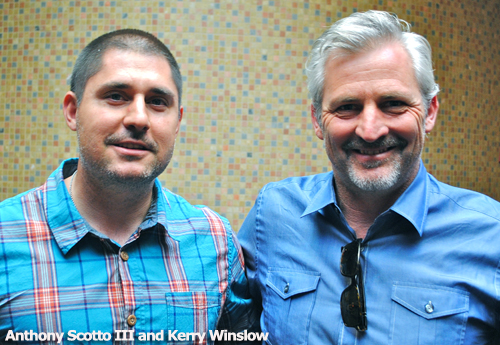
Whenever I hear the words “big wine company” I run the other direction, and fast! But when I received a press release about a historic Italian-American winemaking family that is virtually unknown, my interest was piqued. Here was Anthony Scotto III, a 5th-generation wine mogul whose family owns a past that reads like an American history novel, a wine rags to riches tale that includes elements much like California’s own history that intersects with the Mondavi, Martini and Gallo families. I wanted to learn more.
With an optimistic eye to the future, Scotto is launching a new Napa Valley label celebrating his heritage to be called 50 Harvests, honoring his family’s 50th year making wine in California, even if the real family winemaking history goes back to 1882 in the area around Naples, Italy by way of Brooklyn to Pleasanton, Lodi and Amador County.
Scotto has lots of labels and multiple facilities, all run by the family. This is a tight ship for such a huge venture, but nothing surprises me when it comes to Italian-American families—it is just in their blood! The new winery is near Lake Berryessa, though the vineyards are right on the famed Silverado Trail on the eastern side of the valley. I was lucky enough to taste a selection of barrel samples of the this project, only one of which has been officially named – the 50 Harvests Cabernet Sauvignon 2011 Napa Valley. Their first Napa bottling is the just released Napa by N.A.P.A. Michael’s Red which is a classic throwback field blend style wine which offers pure Napa character, old school, in a value priced category and which has been almost all snatched up by Cost Plus World Market, so be sure to find some there. It has picked up some nice press, especially from the Wine Enthusiast, and I look forward to tasting myself. The 50 Harvests Cabernet is a much more serious animal, and reflects the passion of Anthony Scotto. I was left impressed, very impressed by both the wine and the person.
Scotto’s great-grandfather, Dominic Scotto began making wine in Italy in 1883. He immigrated to New York in 1903, where he worked as a ship caulker. On the side, he and his sons made wine, which they sold in gallon jugs in the Italian neighborhoods of New York form a wooden cart. He opened Scotto Liquors, which is still open. After prohibition, his sons created their own brand, Villa Armando that still exists today. The family moved the operation to California in 1963, opening shop in Pleasanton.
The current generation of Scottos is comprised of five siblings: Anthony Scotto III, who oversees the family business, brother Paul, who handles winemaking and his own winery, Amador’s Sera Fina, sister Natalie Scotto Woods, who handles distribution and will head up the newly-purchased Napa Valley facility, brother Michael, who handles logistics, and sister Anne, who interfaces with distributors and media.
Anthony Scotto III shared his passion, creativity and values over a plate of pasta. He also shared some striking barrel samples of his soon-to-be-released wines!
The new as yet to be released 50 Harvests Cabernet Sauvignon
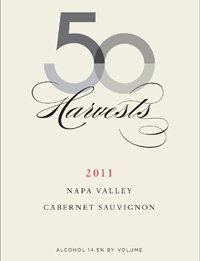 2011 50 Harvests (Scotto Family) Cabernet Sauvignon, Napa Valley.
2011 50 Harvests (Scotto Family) Cabernet Sauvignon, Napa Valley.
Kissed with new French oak, but stylish and restrained, the 2011 impresses with balance and purity of flavors, especially considering it was unbelievably difficult vintage for many Napa vintners, and the wine is already drinking very well. Only a tiny amount of this Cabernet will be available, but it should be well priced for the quality given Scotto’s track record. The nose is ripe and rich with detailed accents, floral tones, red and black fruits plus toasty wood leading to a smooth round palate of blackberry, dark cherry and plum with hints of cassis, vanilla, fine sweet cut tobacco, mocha and minty herbs. This Cabernet has 6% Petit Verdot added and it shows in the color and spices that come through on the aftertaste. (92 Points)
Plus the secret sample!
2012 (No Label as of yet, Scotto Family Steele Canyon) Petite Sirah, Napa Valley. (Barrel Sample)
No word on what will become of this wine yet, but this was my favorite of the samples I tried. This amazingly beautiful and polished red 100% Napa Valley Petite Sirah from vines at the Van Der Hayden estate on the Silverado Trail is truly a gem, deep in color, firm, but supple tannins and lengthy finish make this a powerful winemaking statement, I can’t wait to try this again in final form and with it’s label on the bottle, They have something remarkable and special here. The nose is floral with hints of violets and mocha with a touch of kirschwasser, classic Petit Sirah on the palate with blackberry, boysenberry and currant fruits, coco powder, chalky minerals and lavender oil. Hints of spice, licorice and blueberry compote come through with time in the glass and everything feels lush and balanced, very, very nice stuff indeed. (93 Points)
Scotto tips his hat to the generations that came before him. A history major in college, he recalls that every Sunday, the whole family would come together for dinner. While the others argued about business, Anthony’s grandfather pulled him aside to teach him about family history, values, tradition, winemaking and how to grow up to be a good man. It looks like it rubbed off on the thirty-something Anthony Scotto.
It is a family affair at Scotto Cellars, but the leader can only be one guy.
He is a driven man and always on the go from production to sales meetings. He does it all, pointing out that his company has no middle management, so he is able to over-deliver on quality for the price. Anthony Scotto is really smart when it comes to marketing and giving his customers what they want. He is totally committed and focused in his pursuit of success. Scotto points out that the wine business gives him passion and it delivers a challenge like no other for him, and he spelled it out to me as discipline: character building, a venue for creative thinking and his outlet to be successful both in his personal and business lives. I had my reservations about meeting the head of a big wine company going in, but going out I left with nothing but awe and respect. I found Anthony Scotto III to be as down to earth as it gets—and a family man is every sense of the word!
